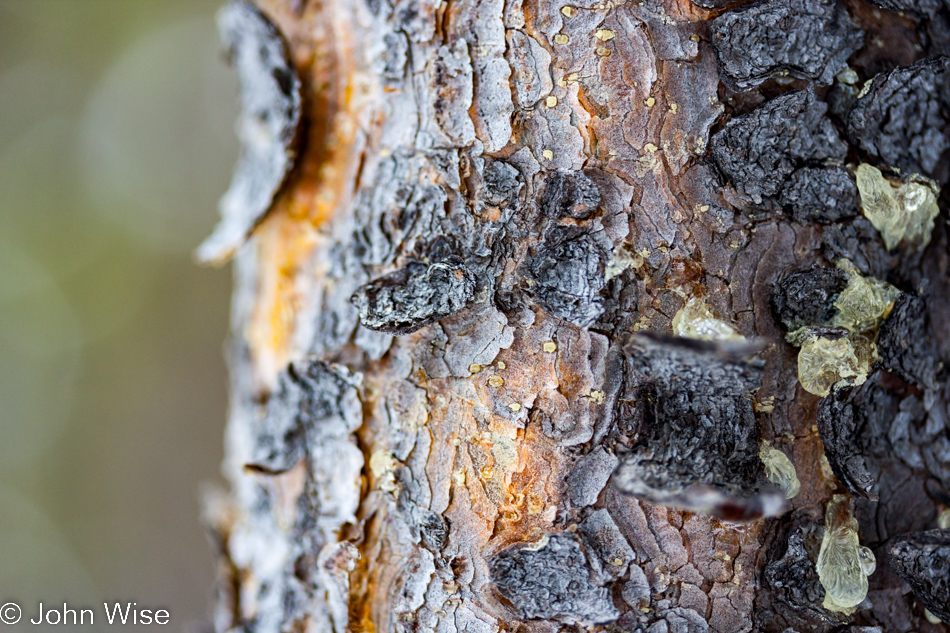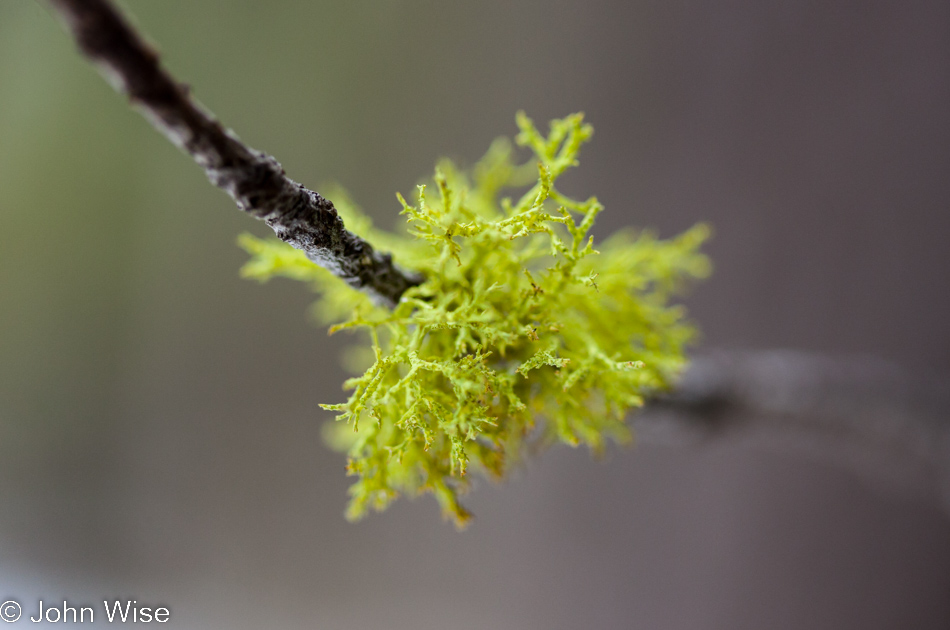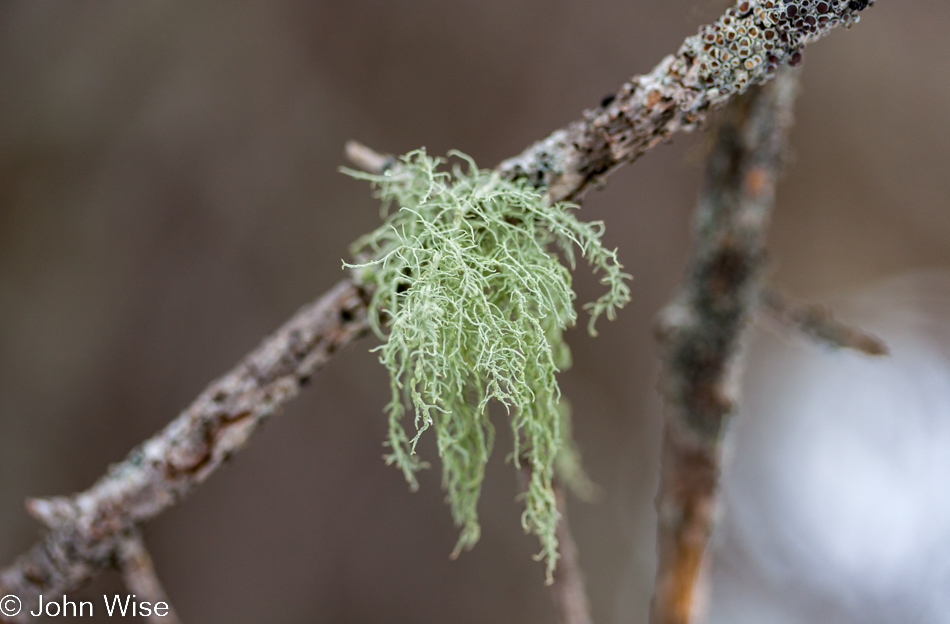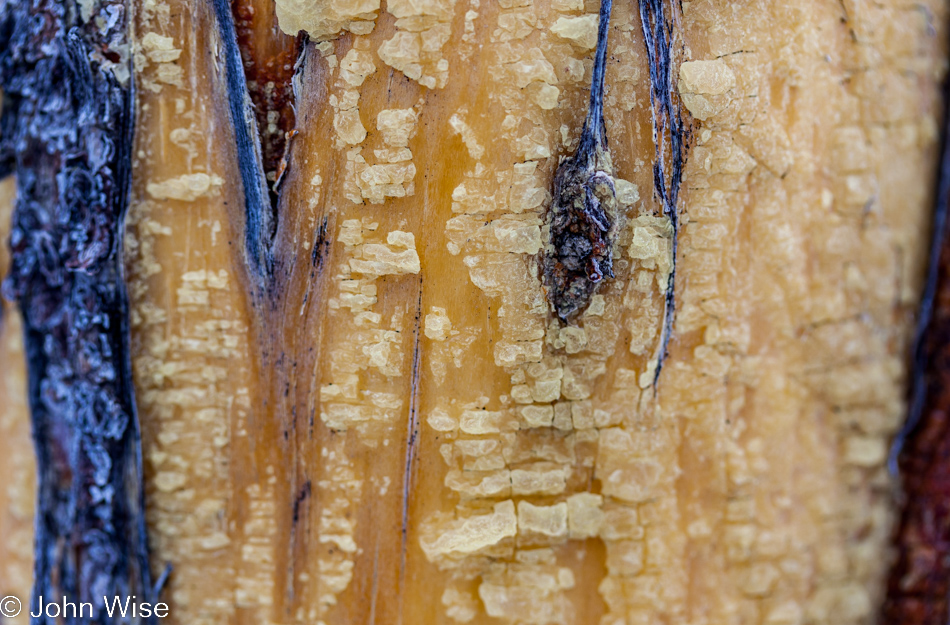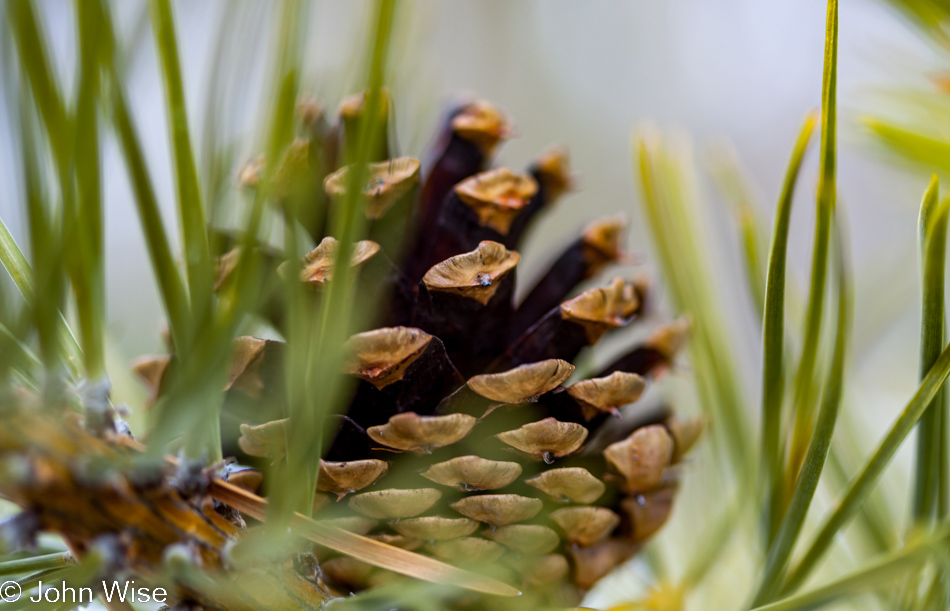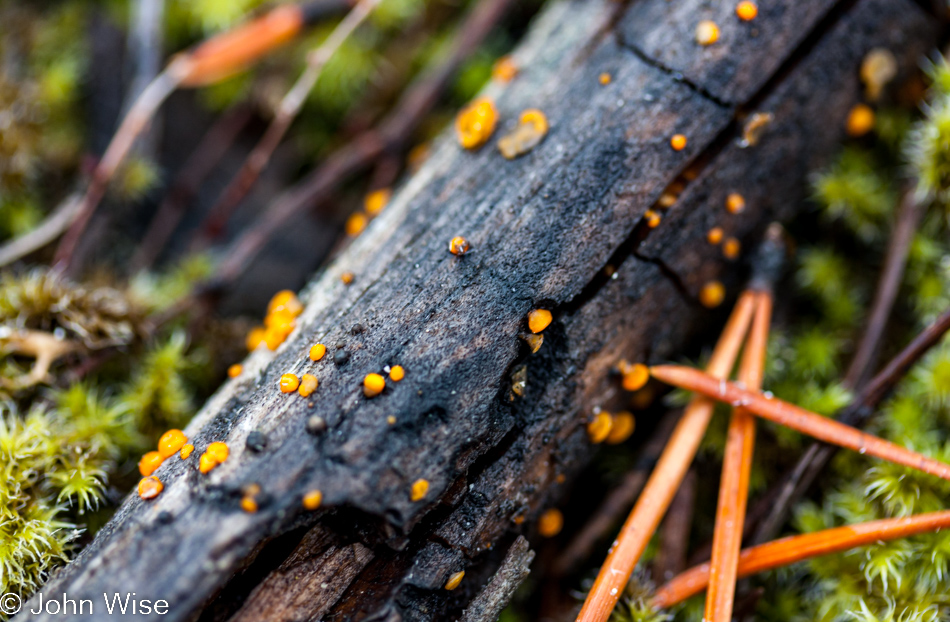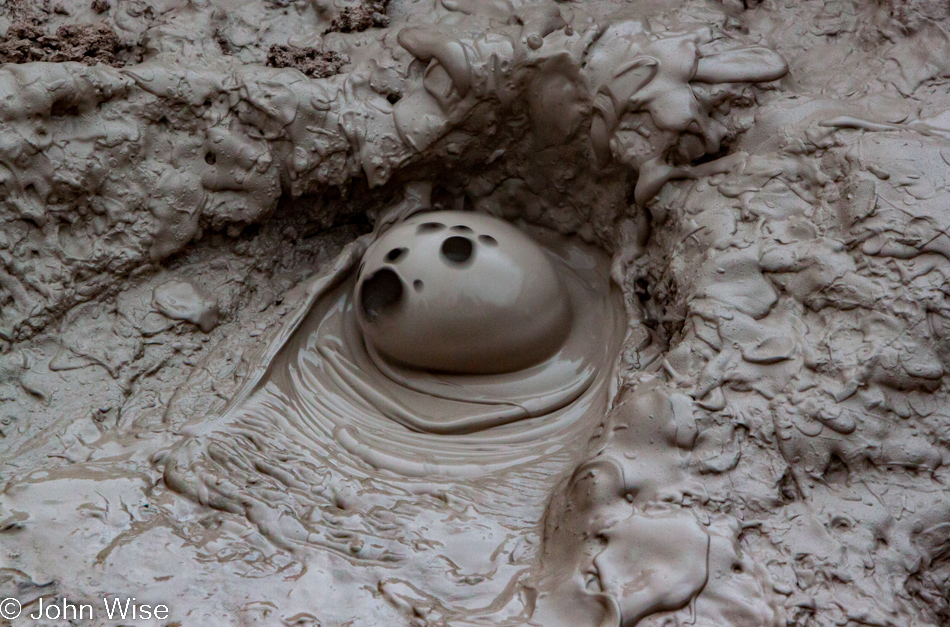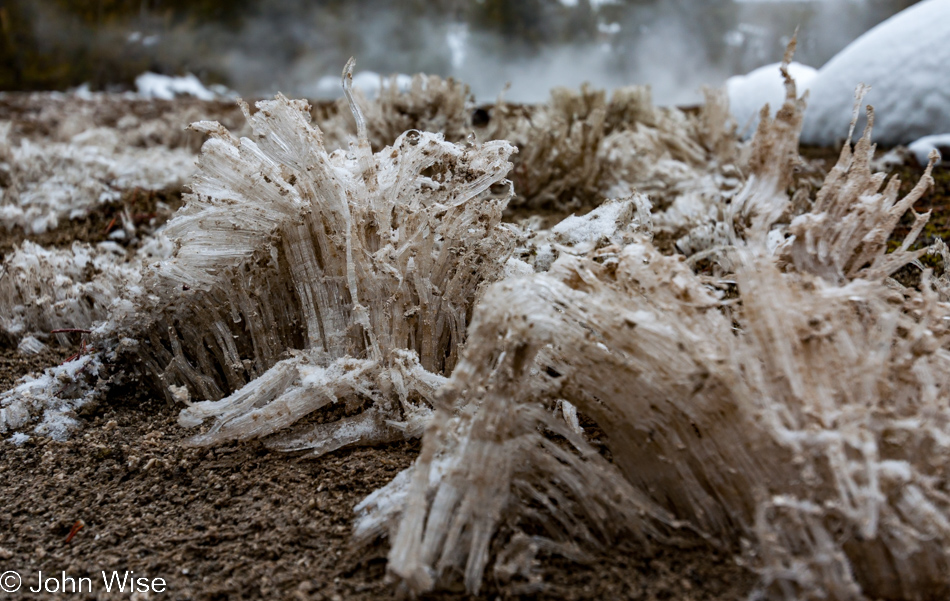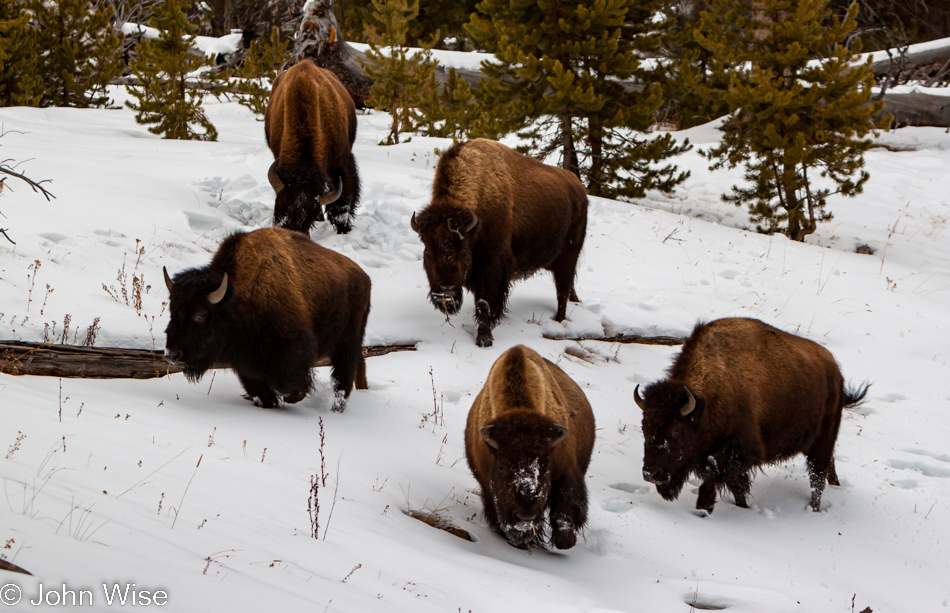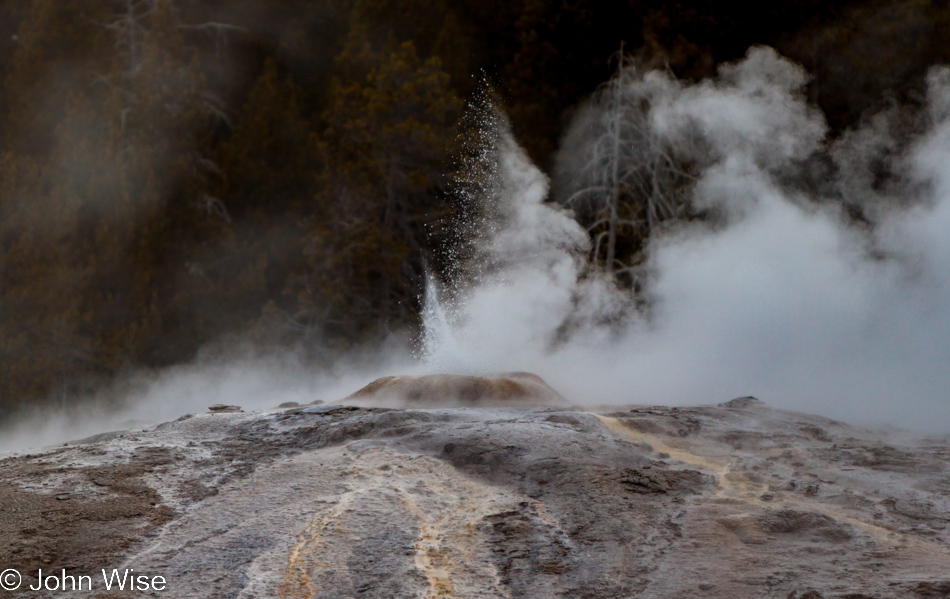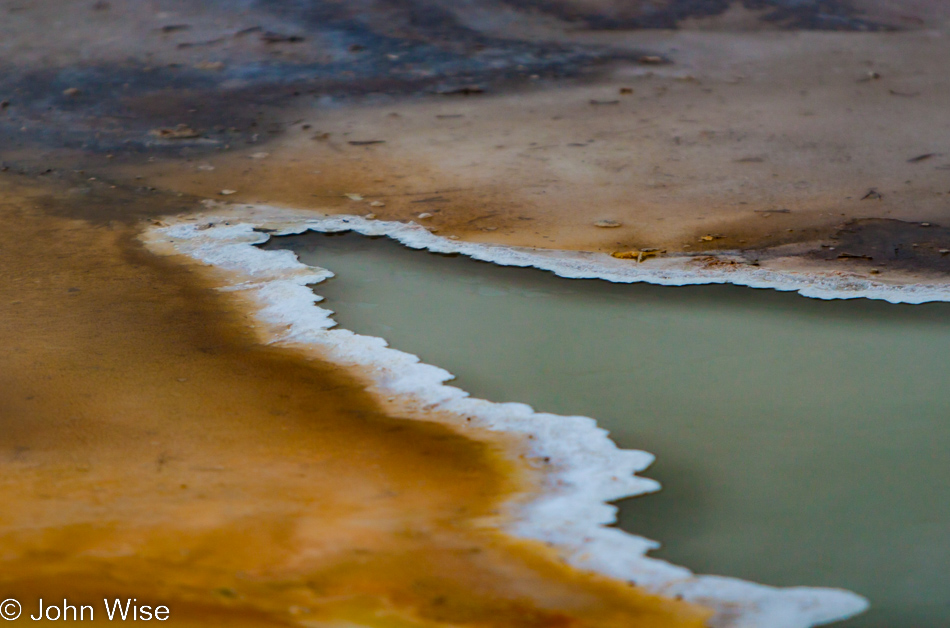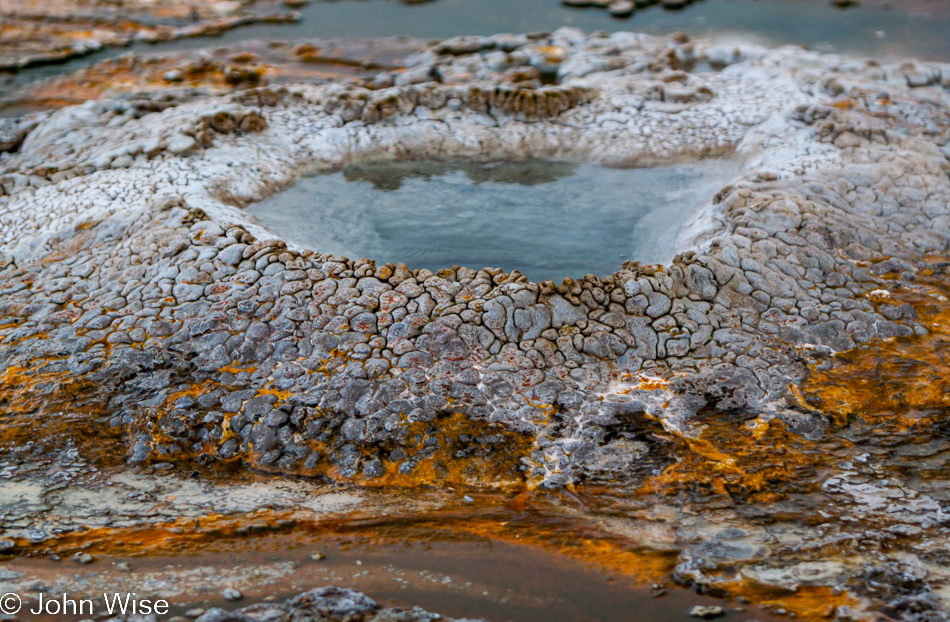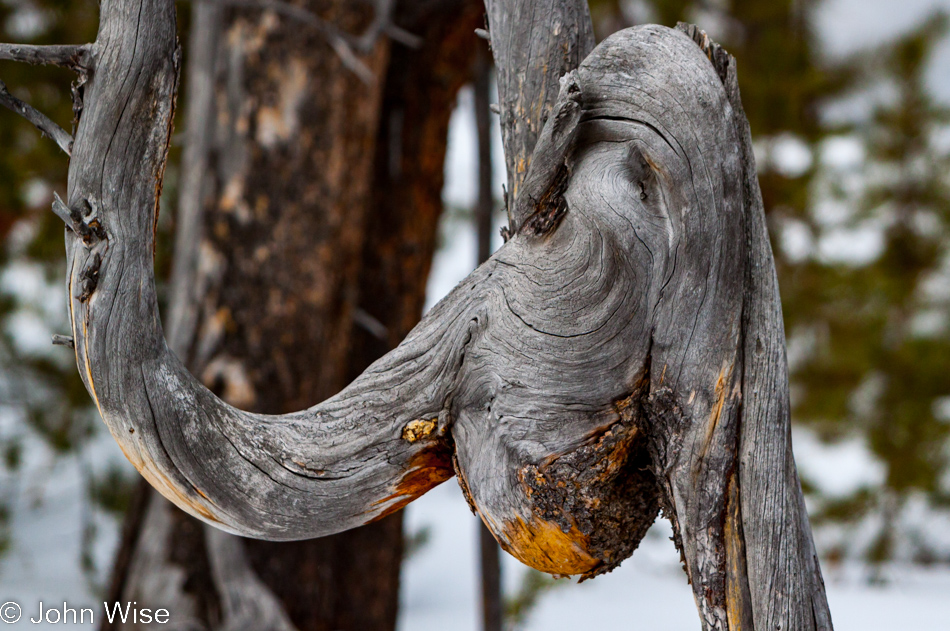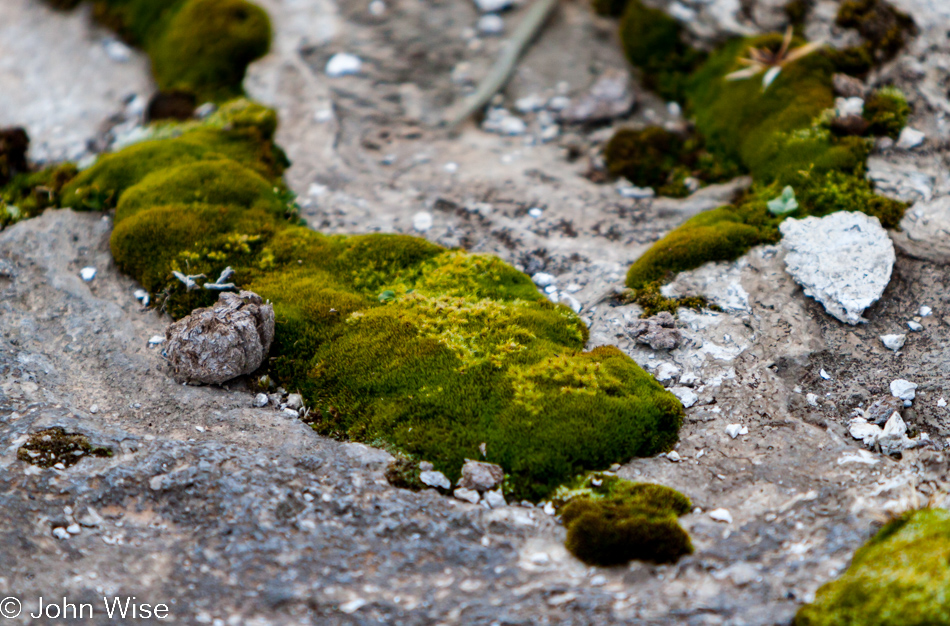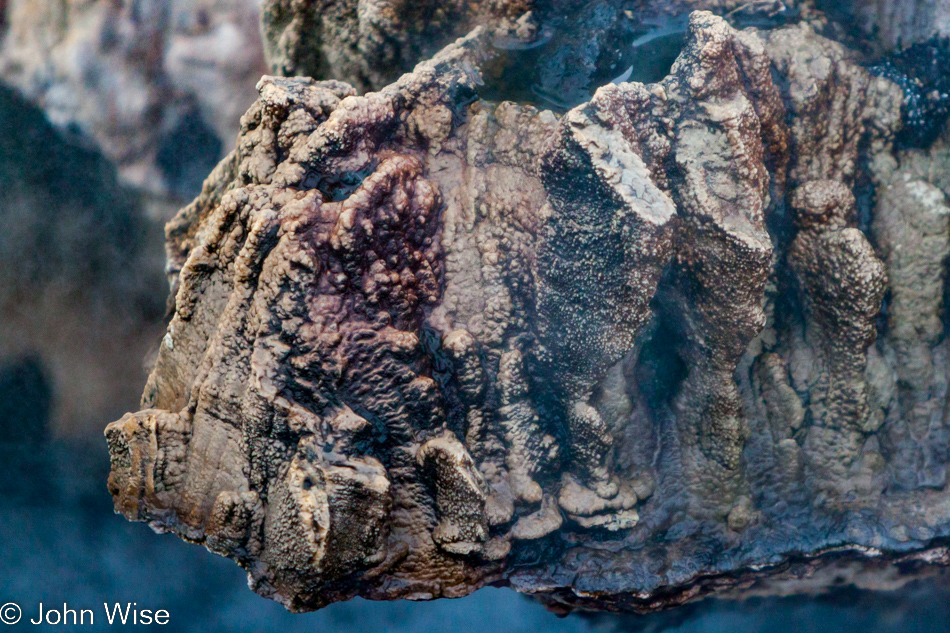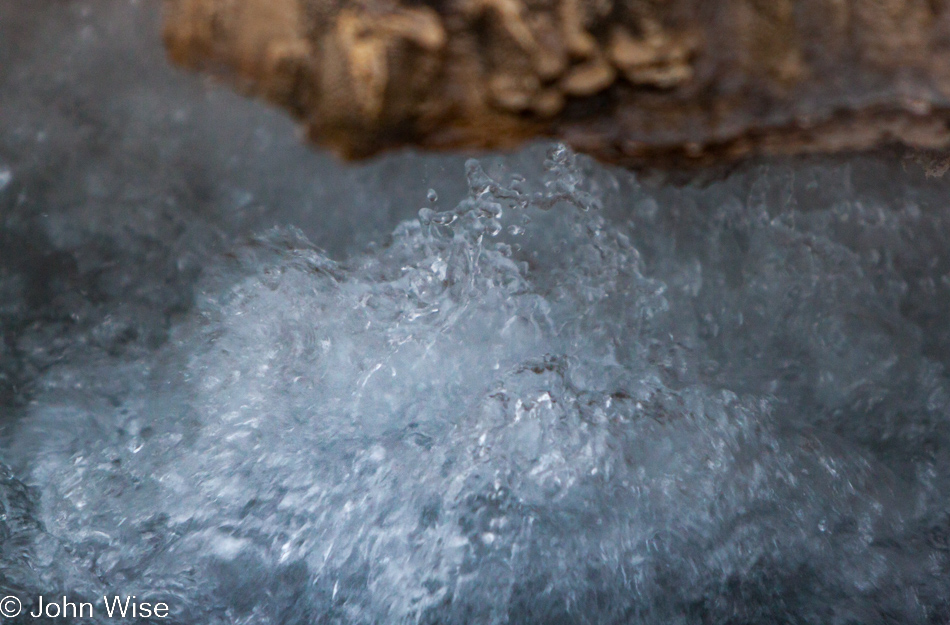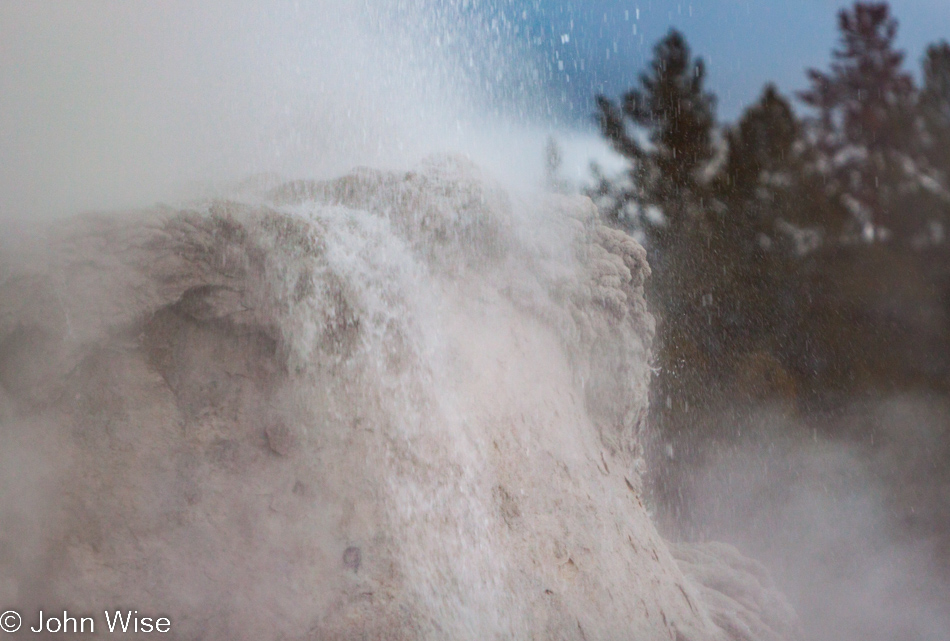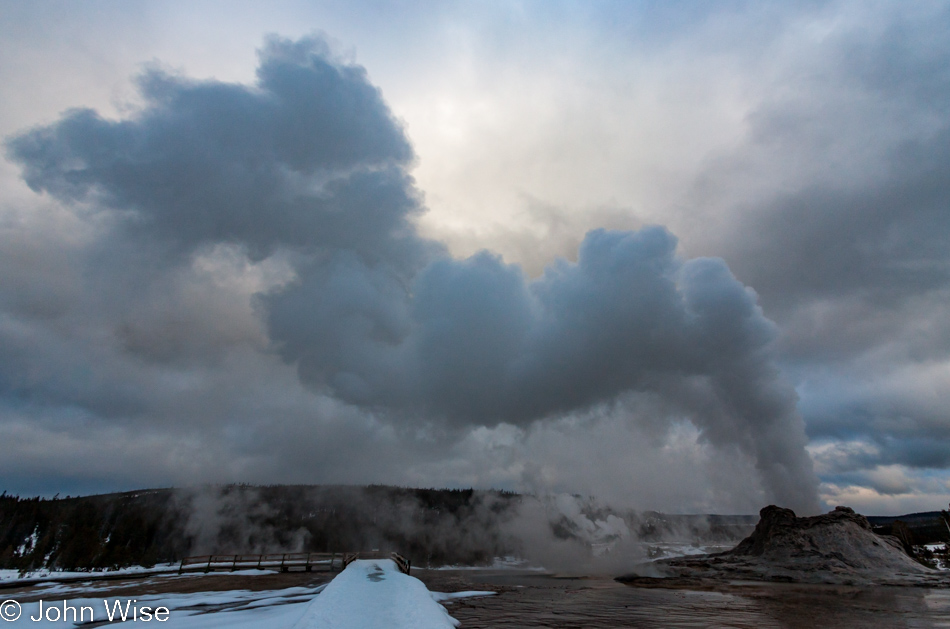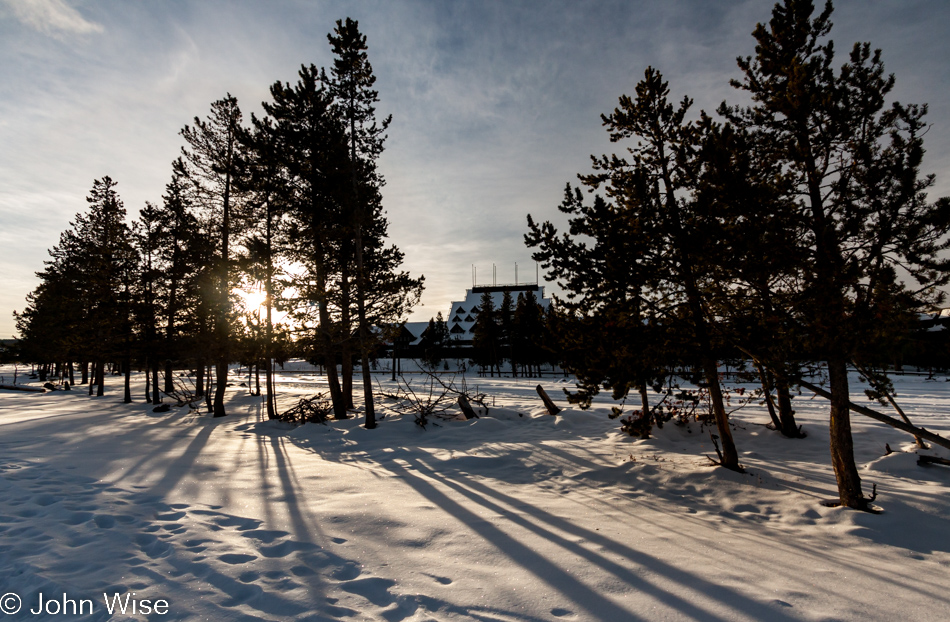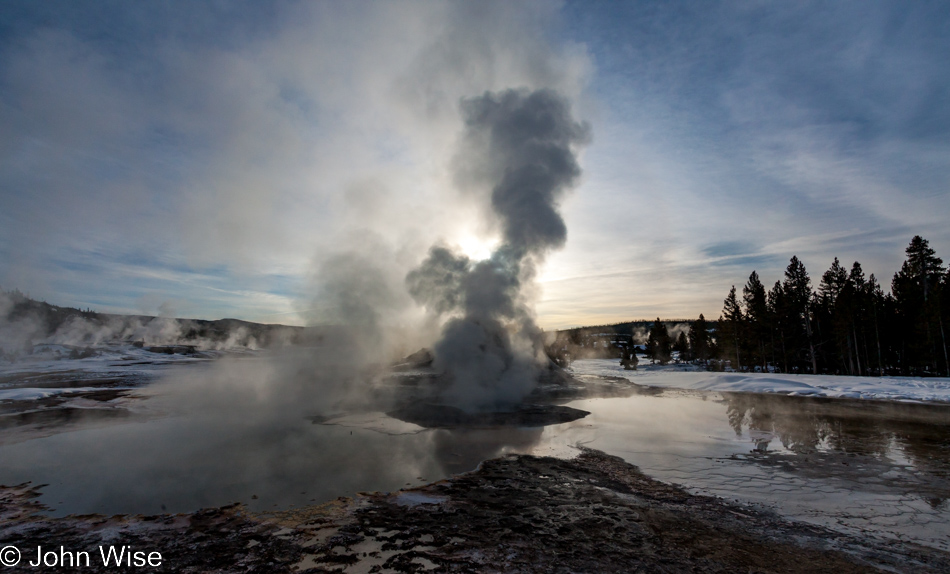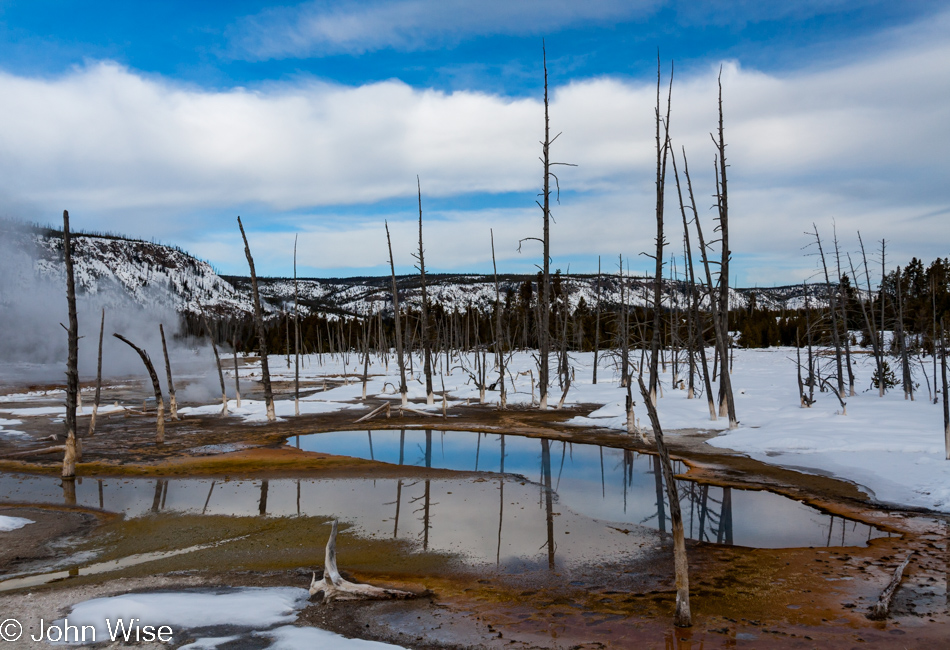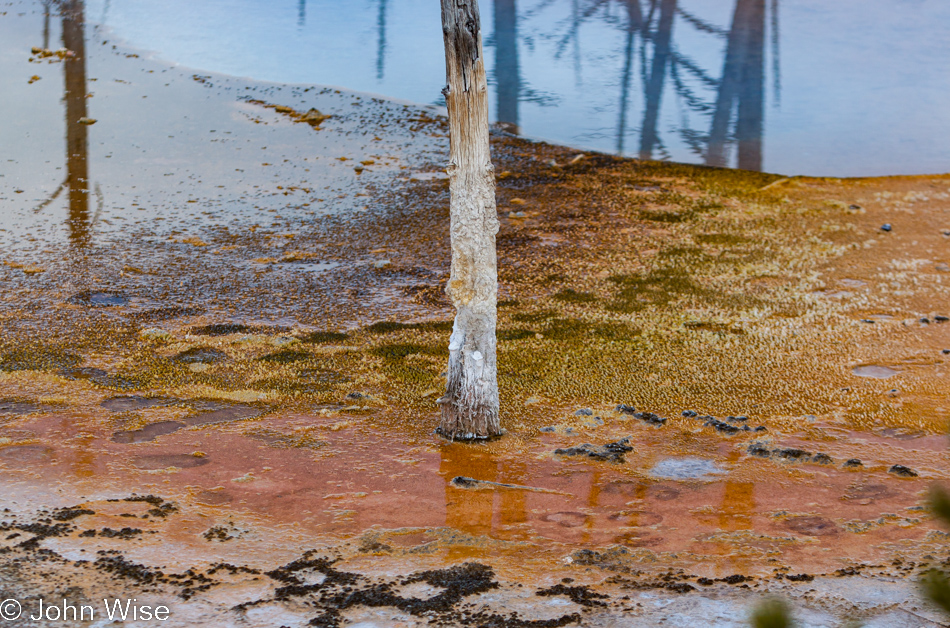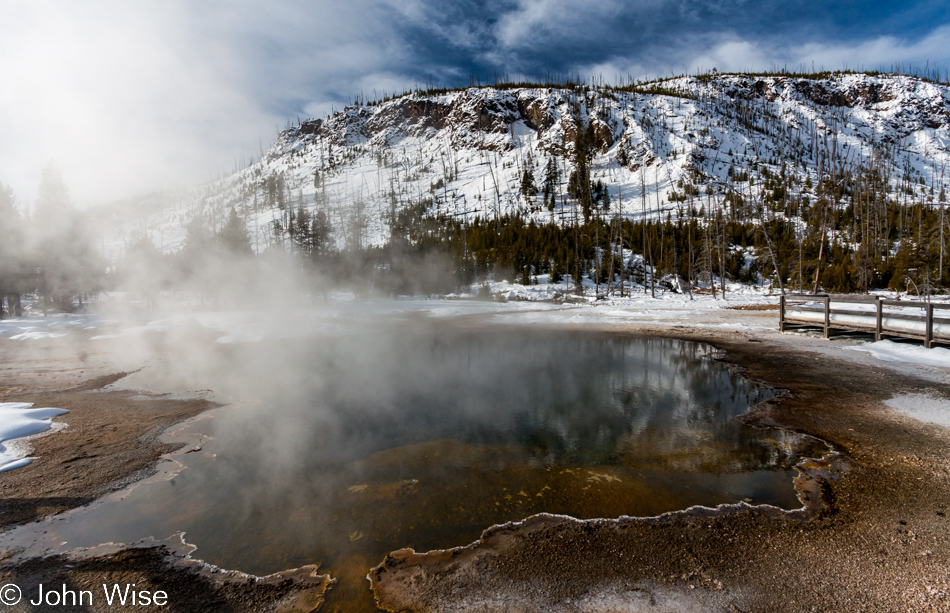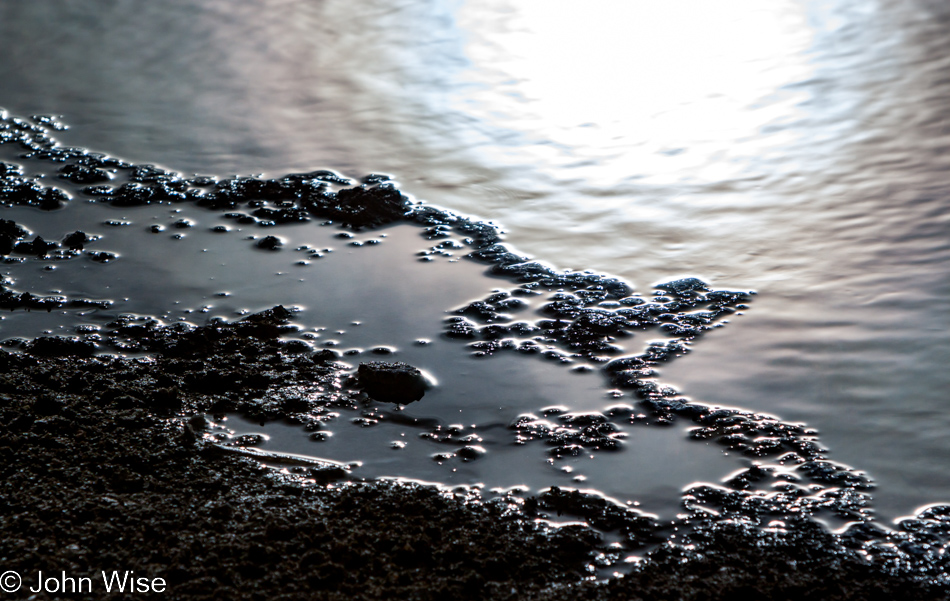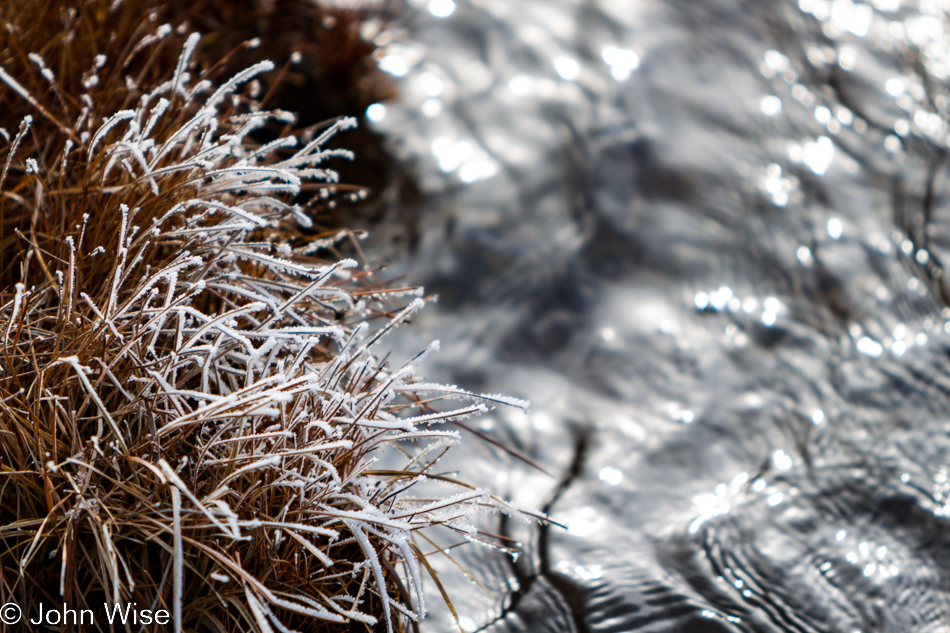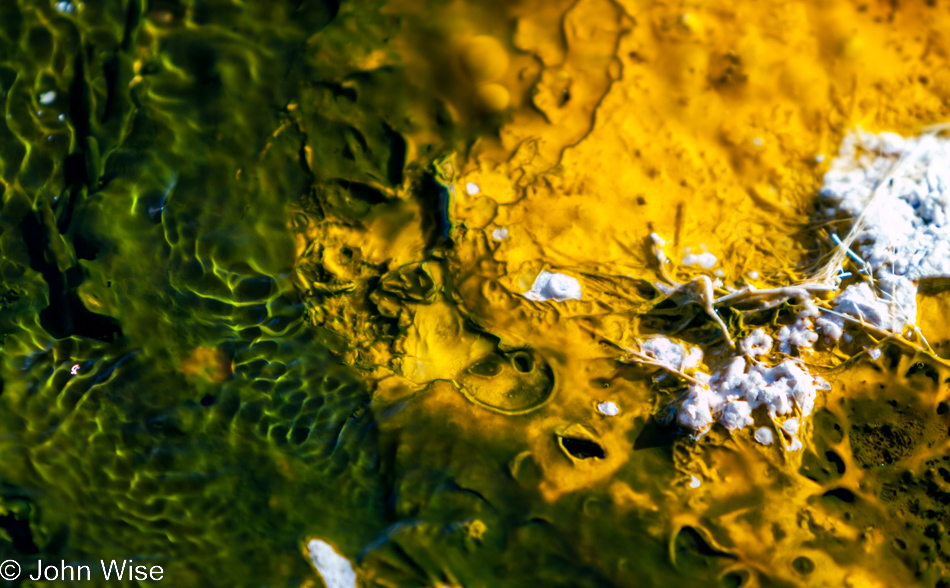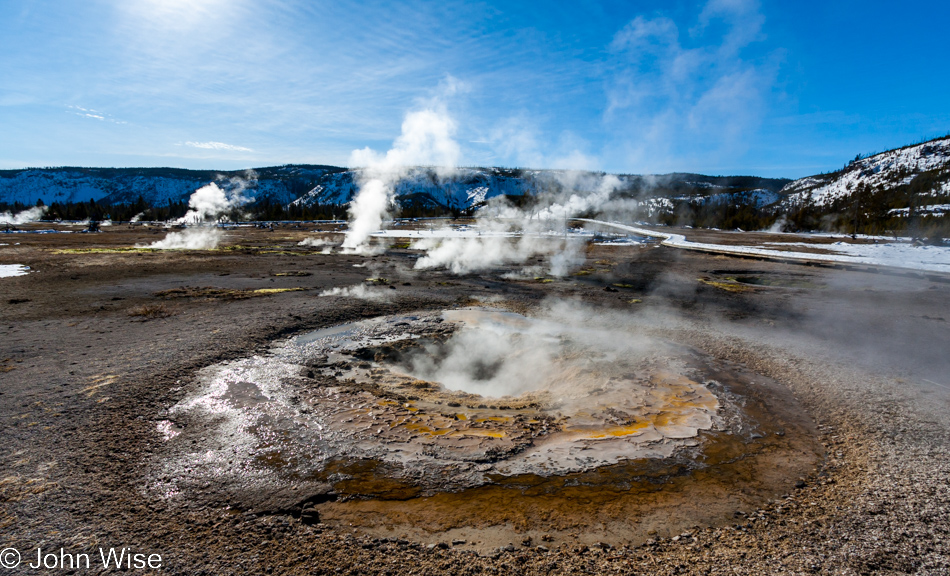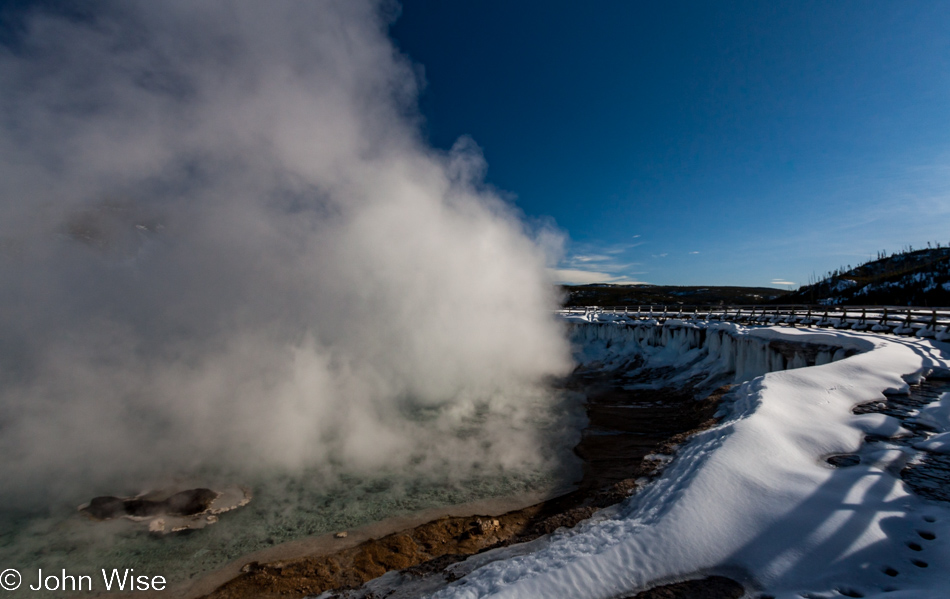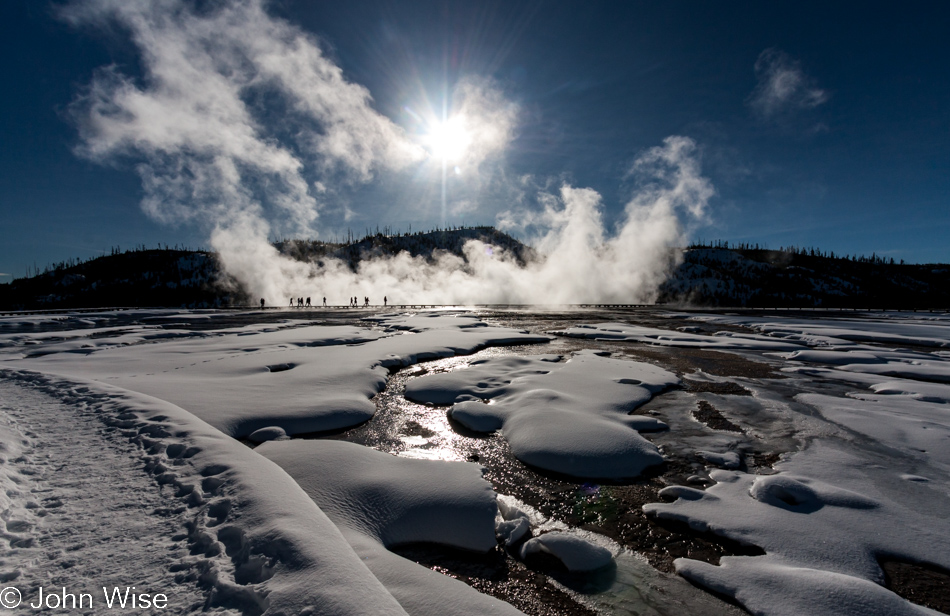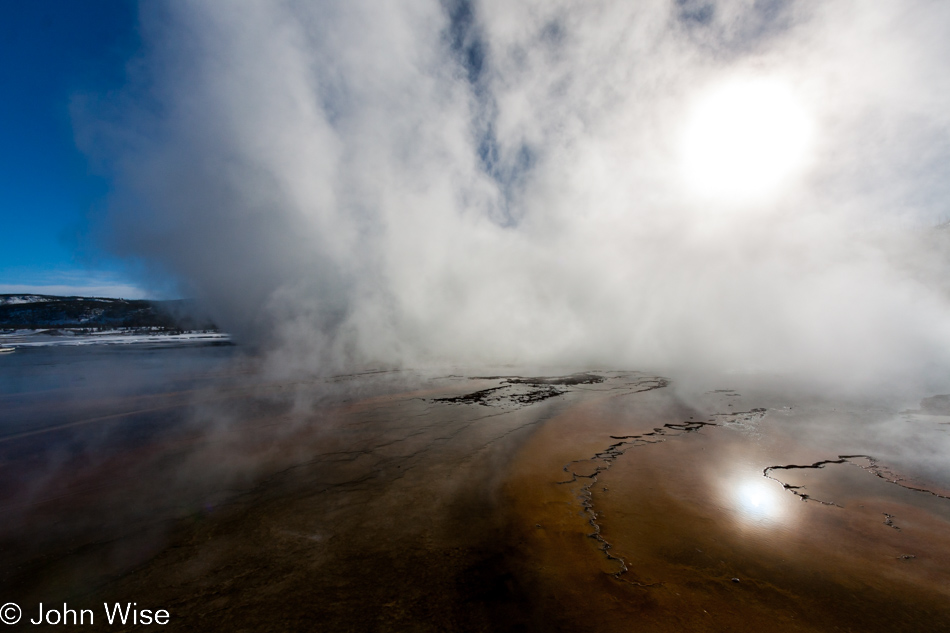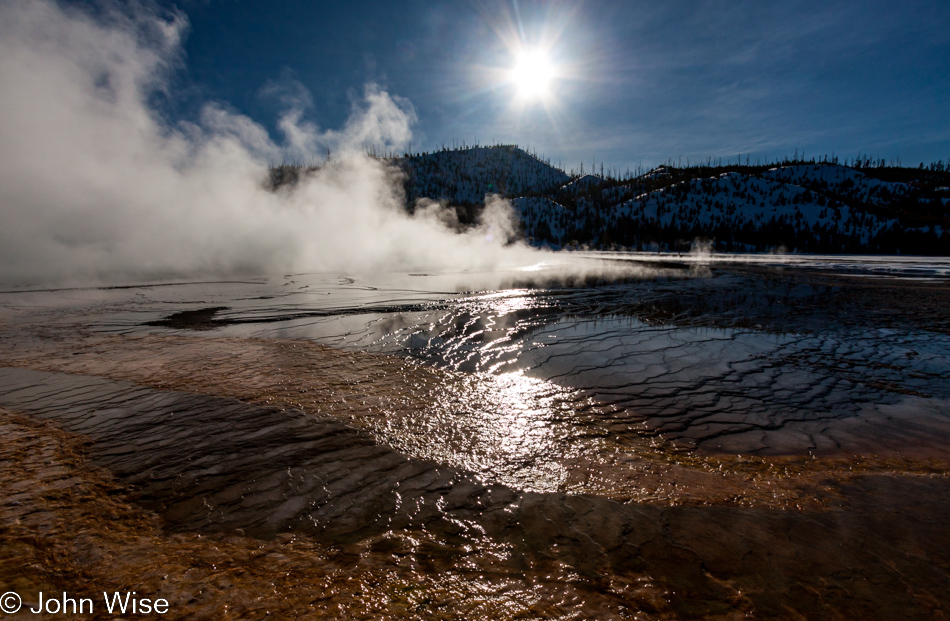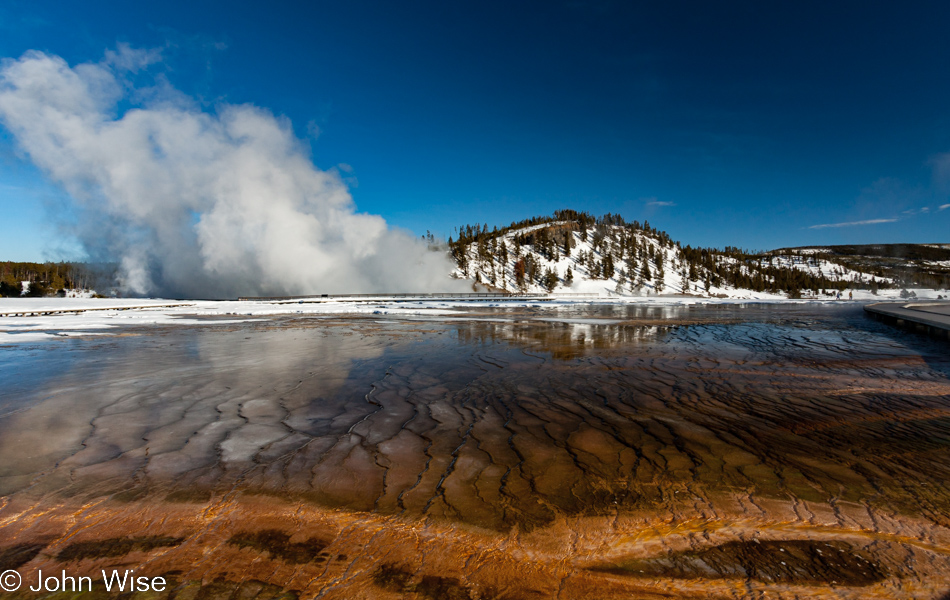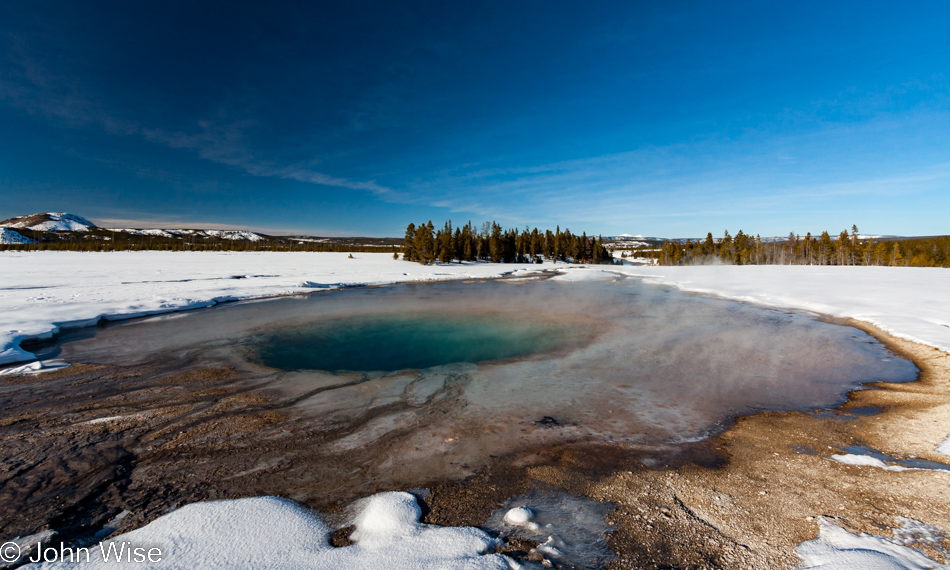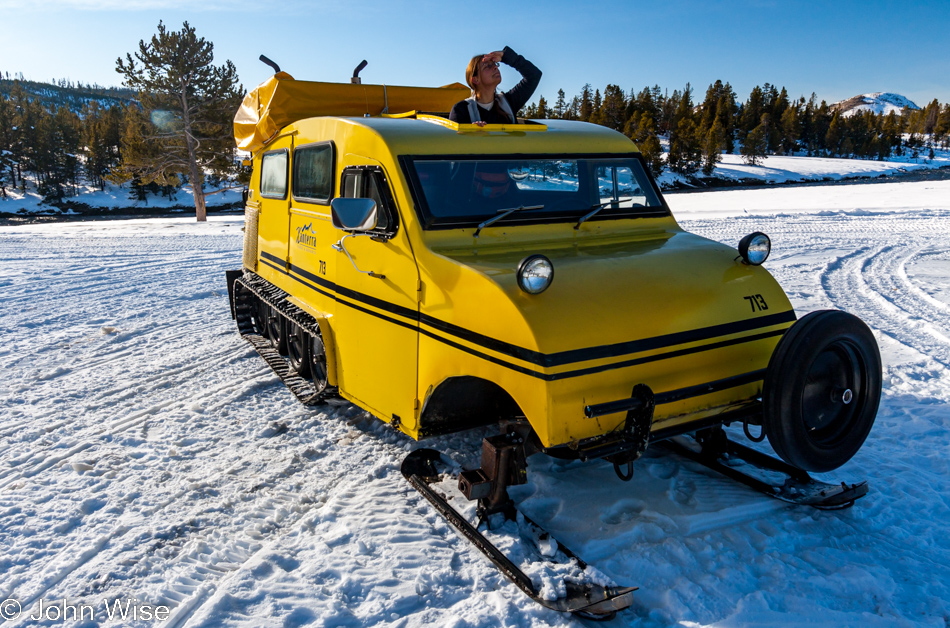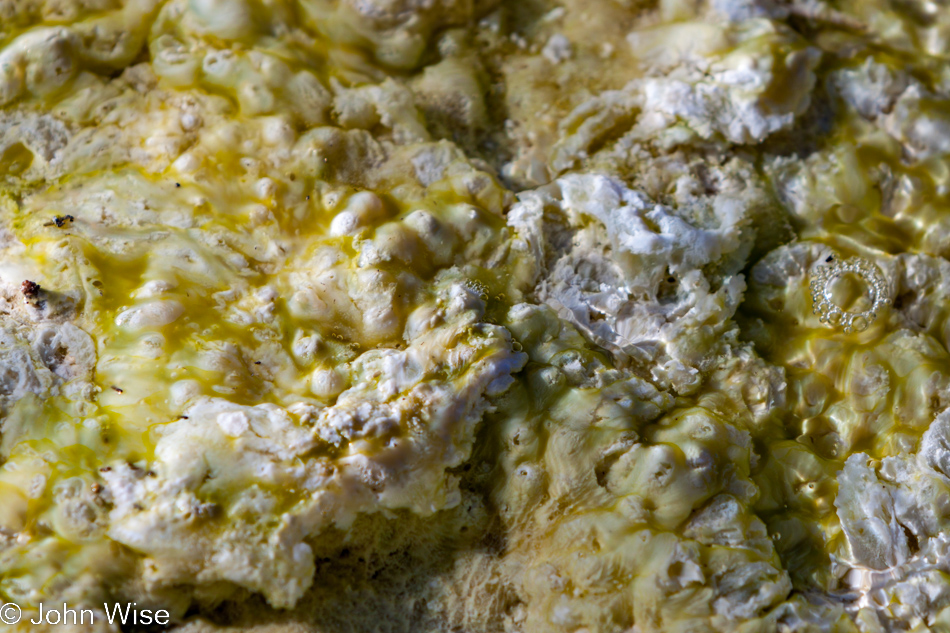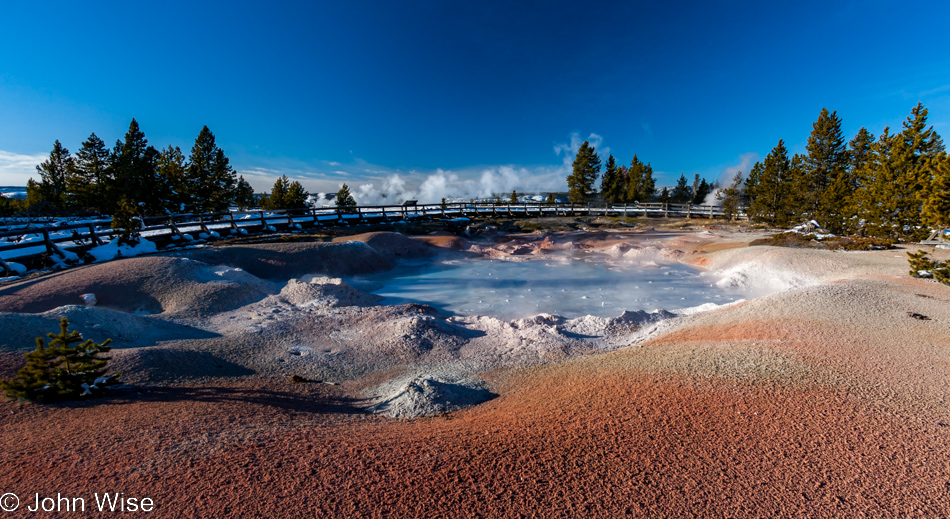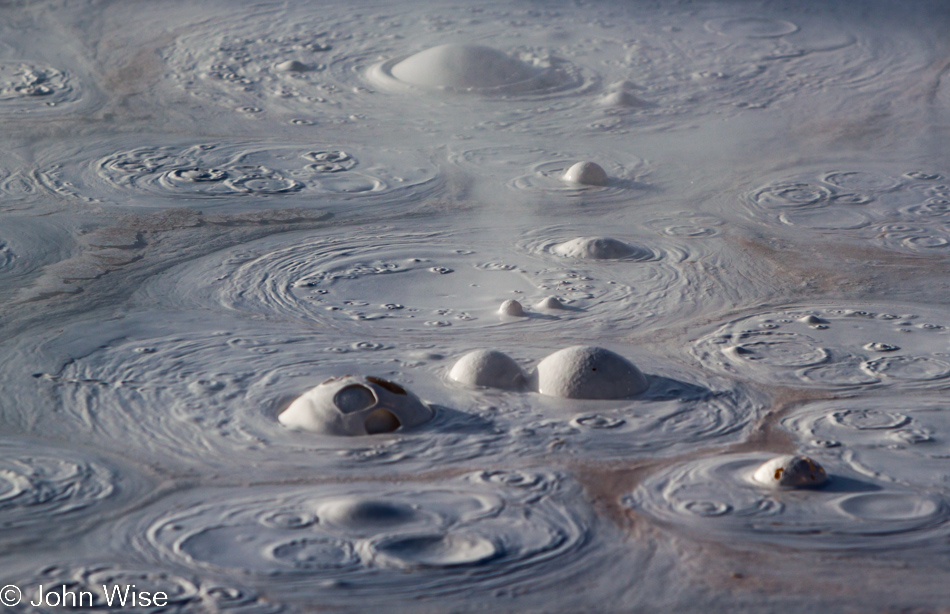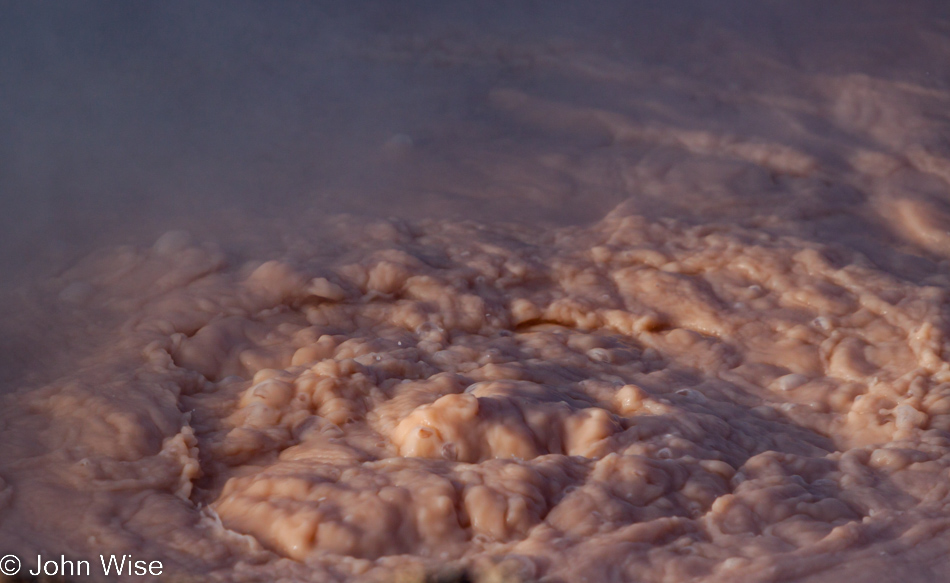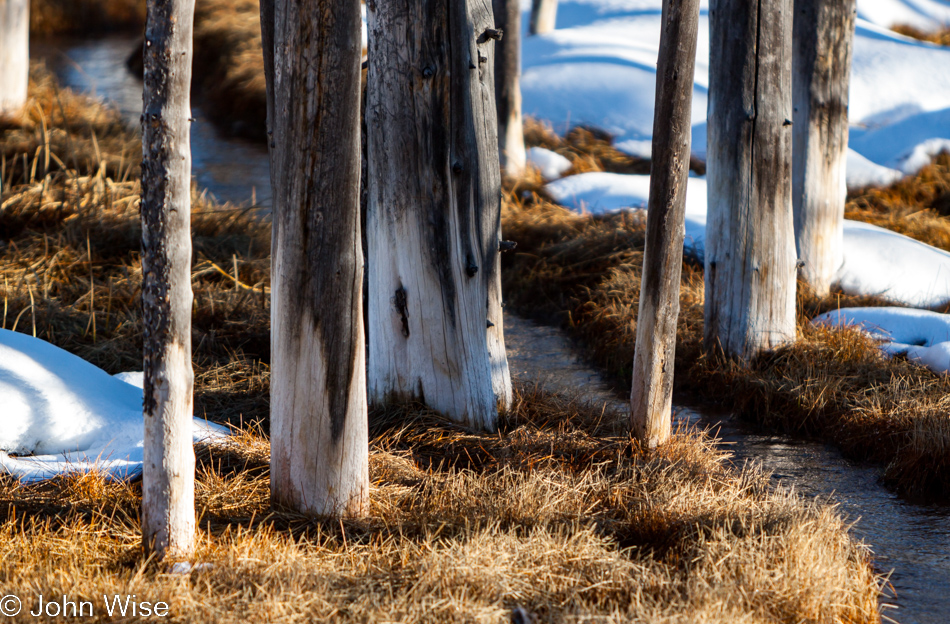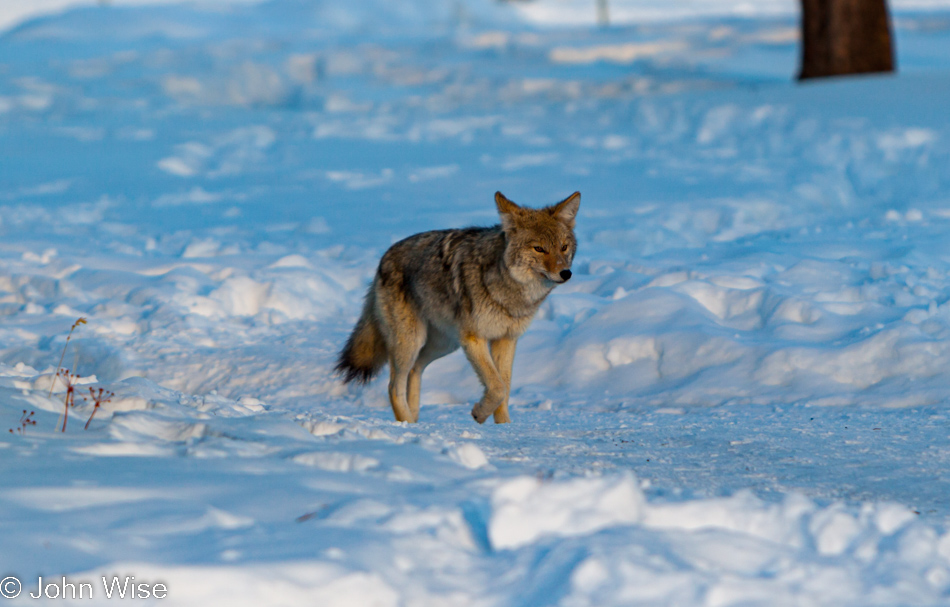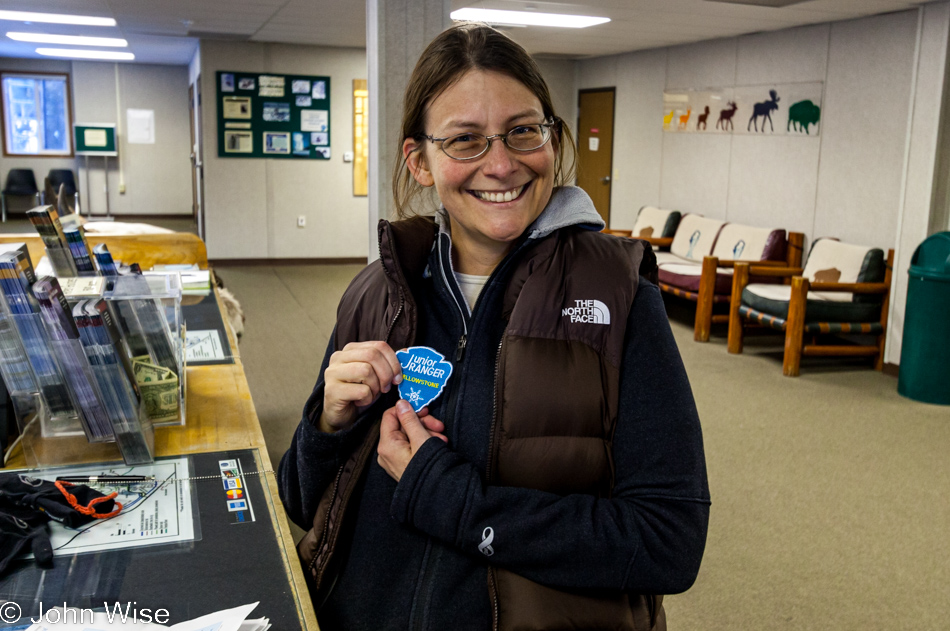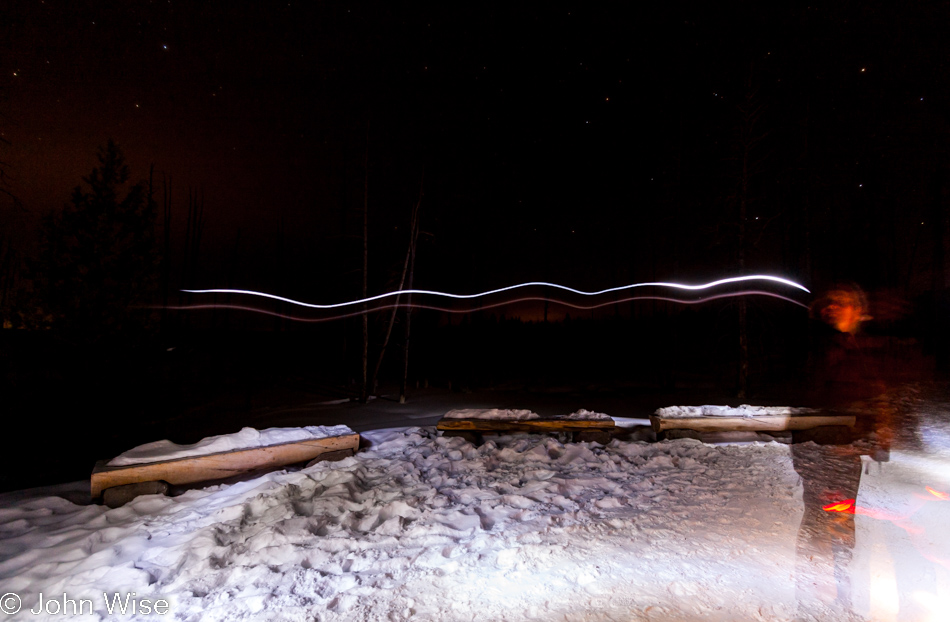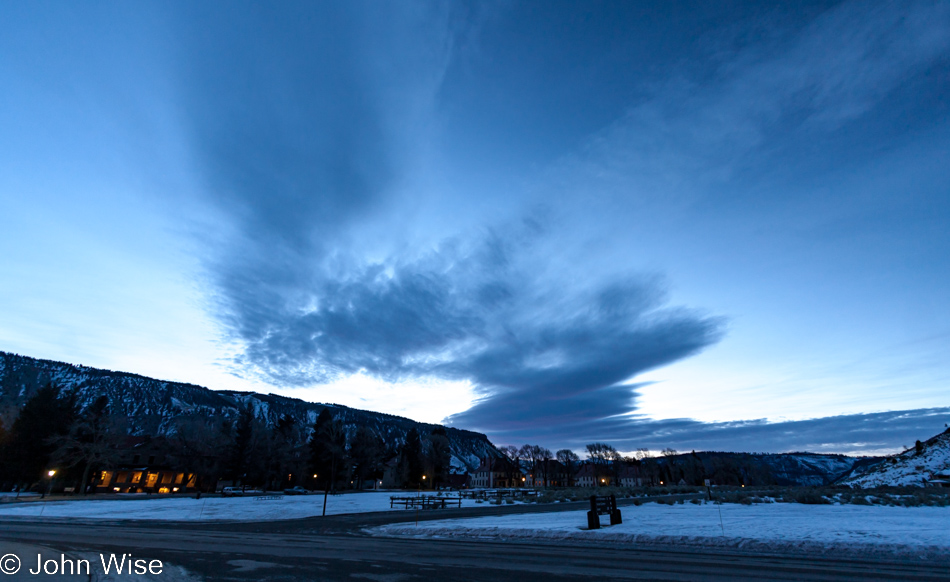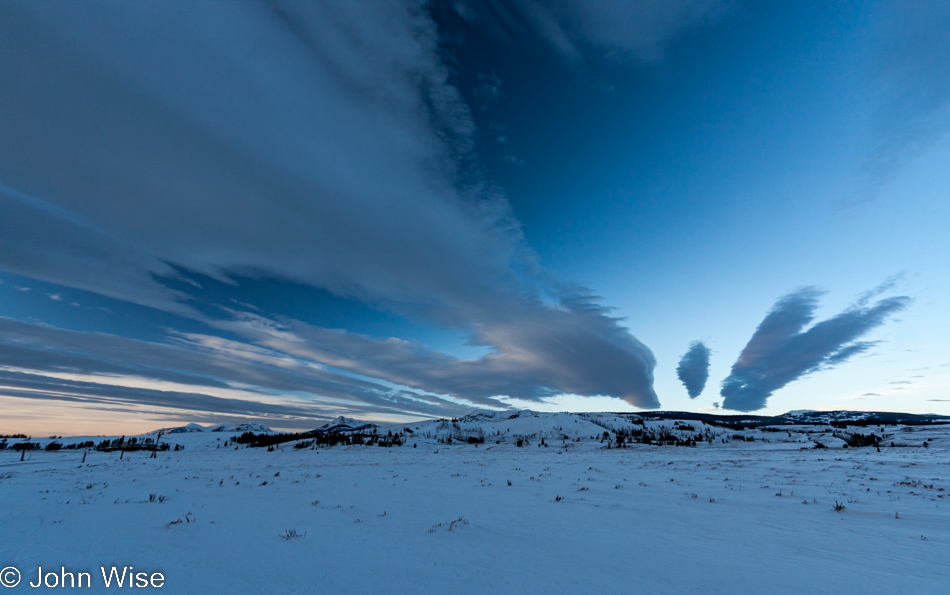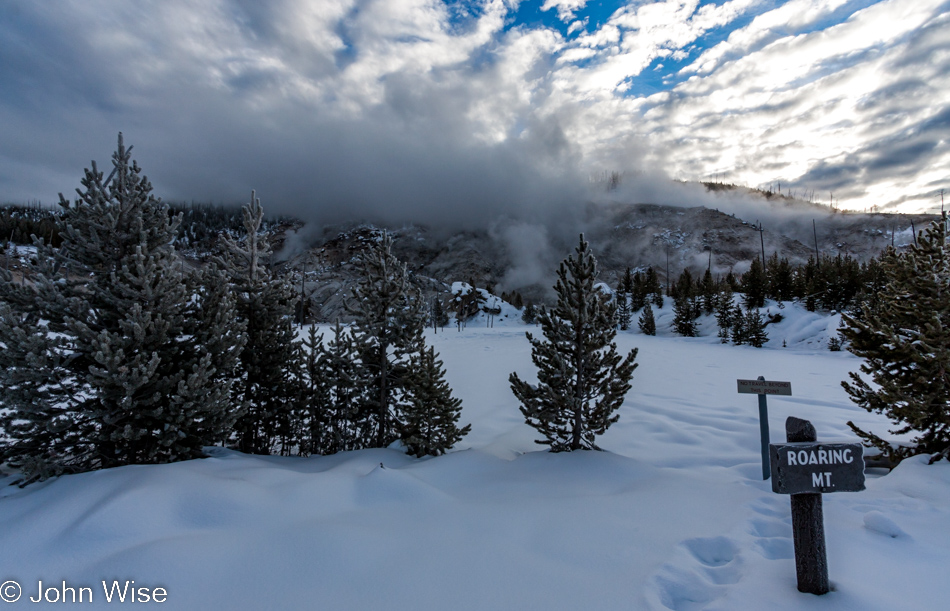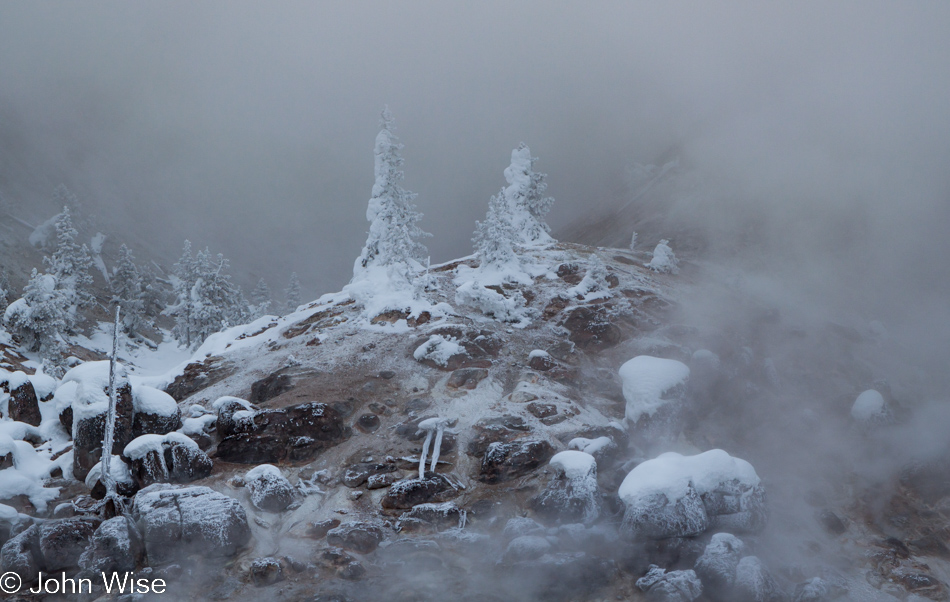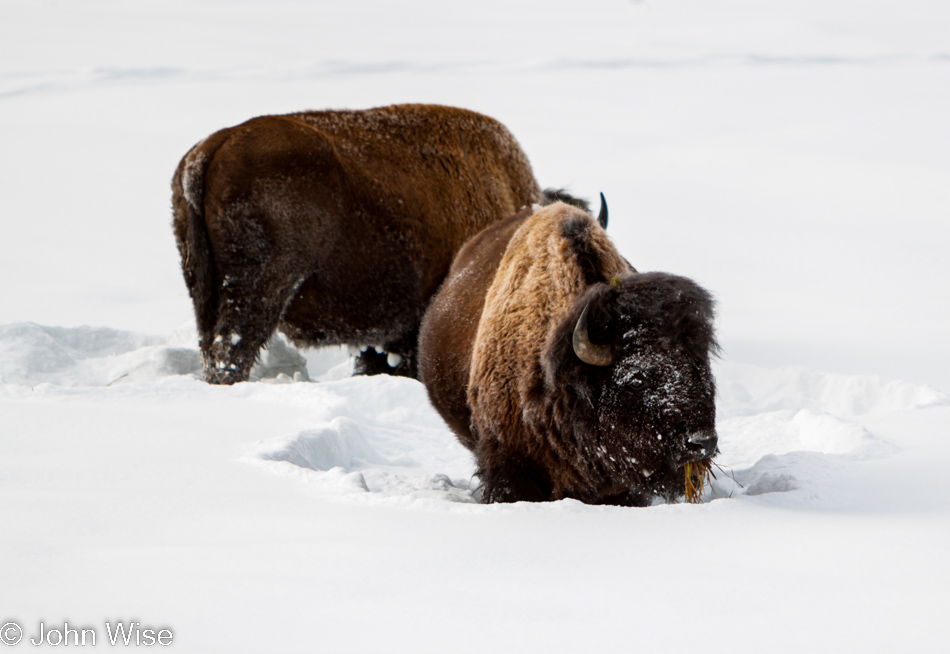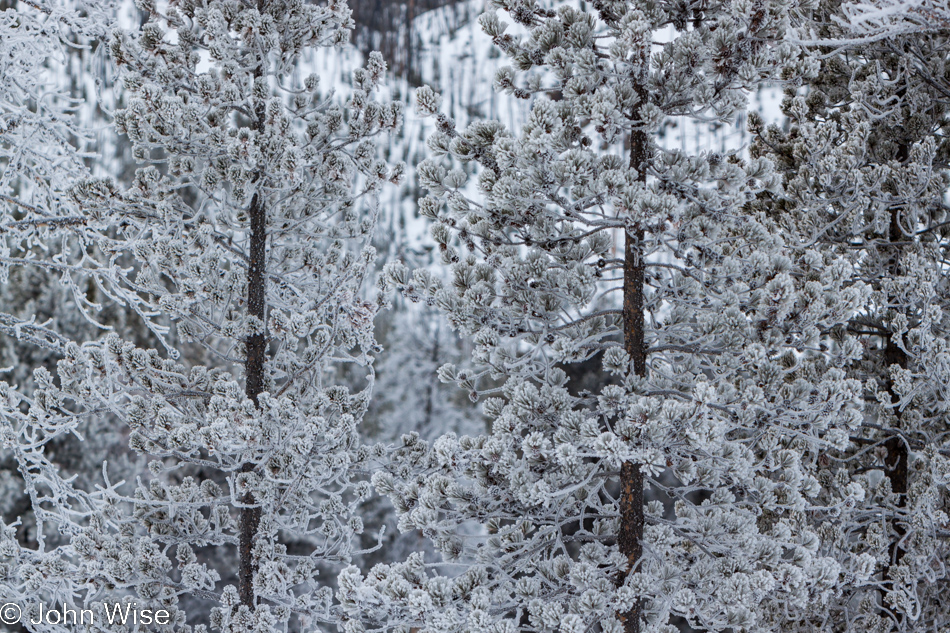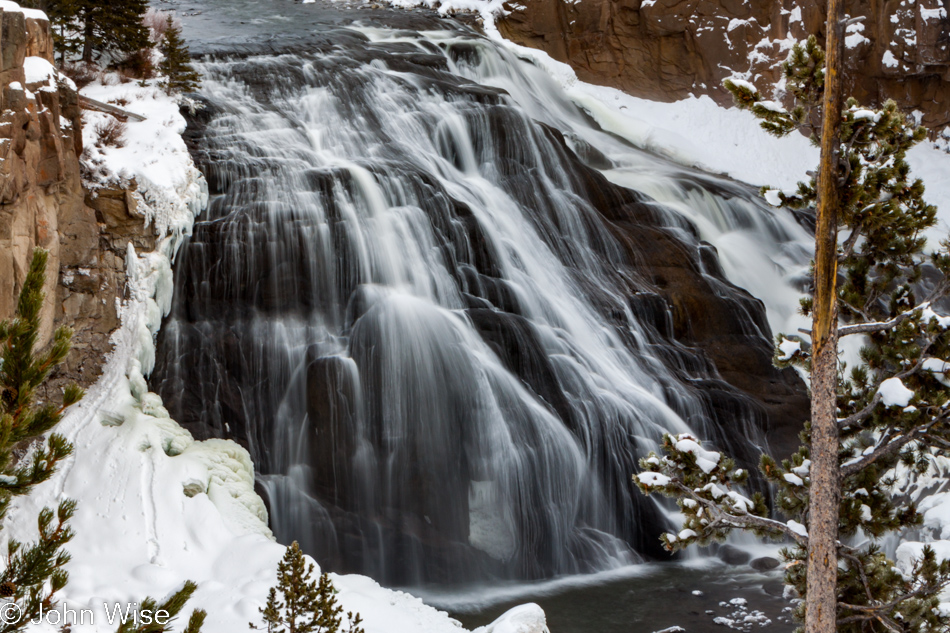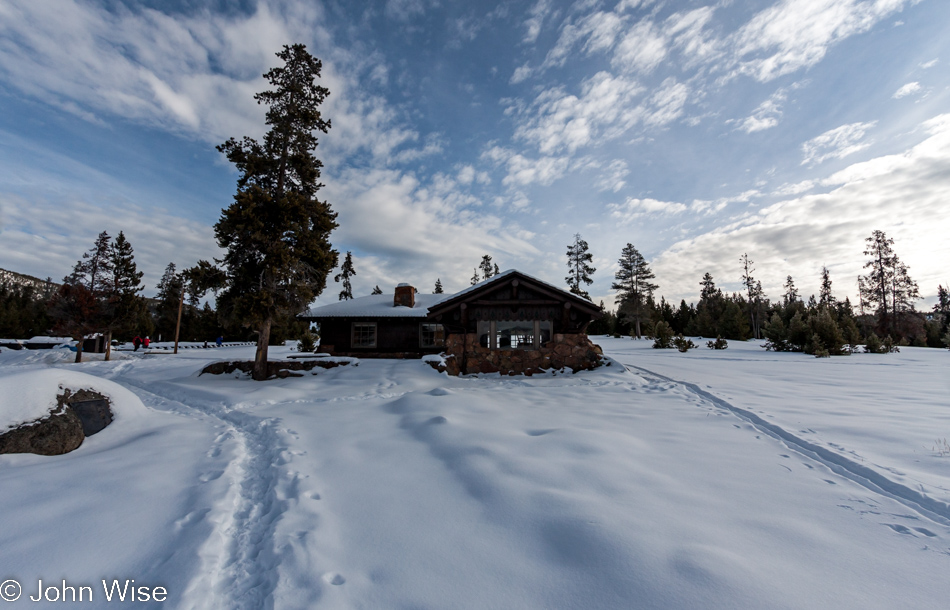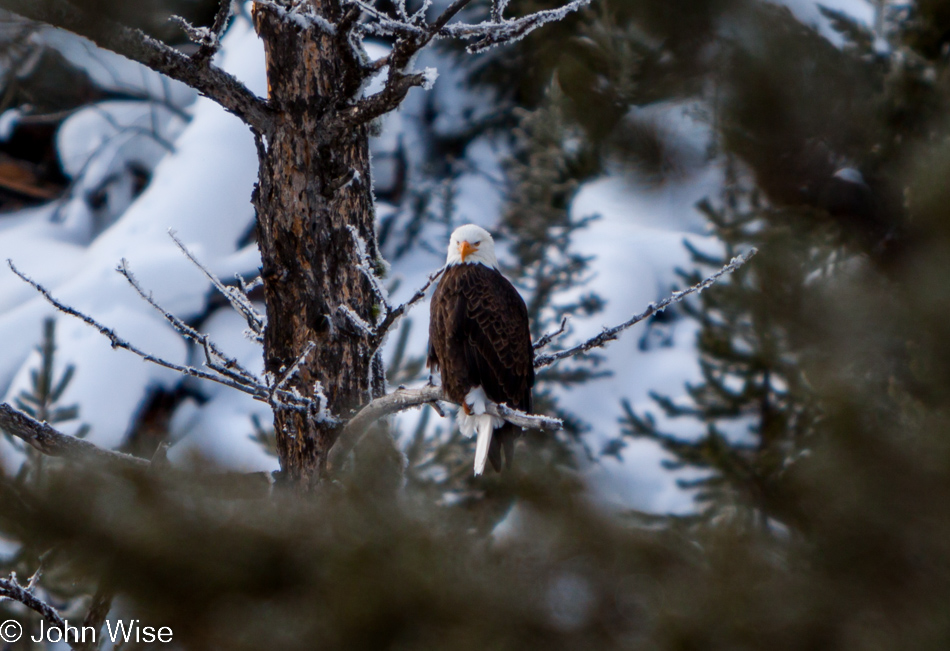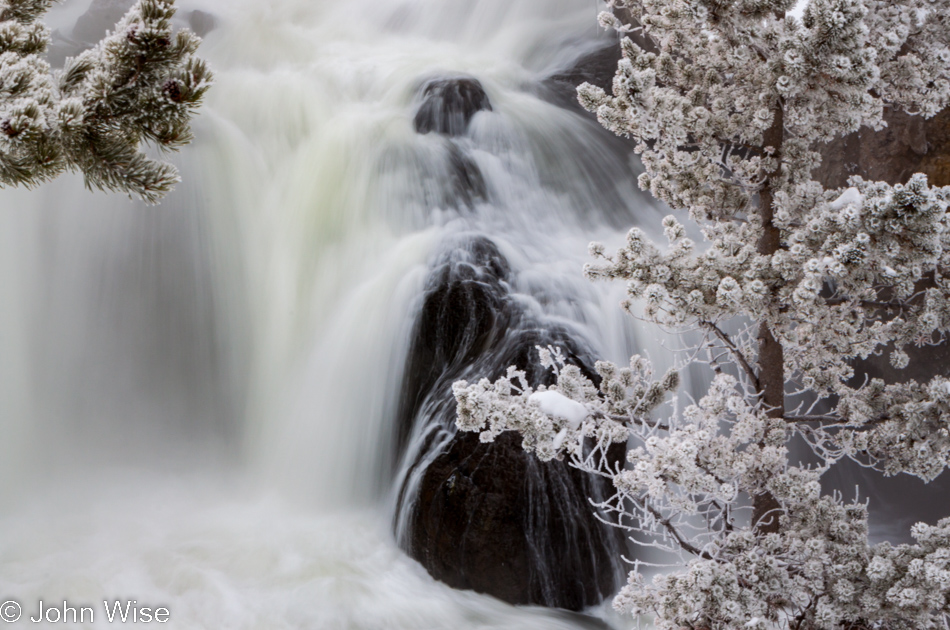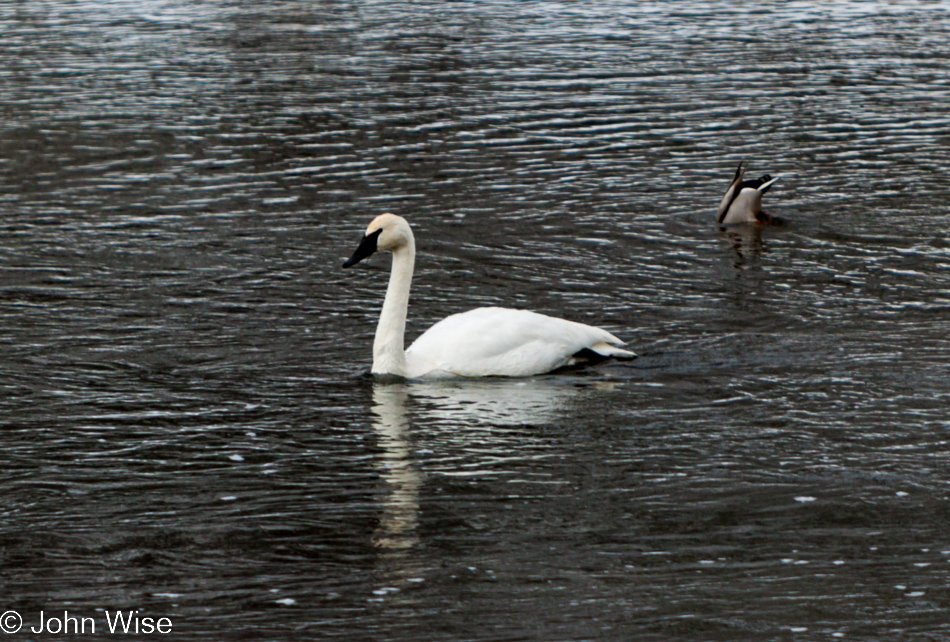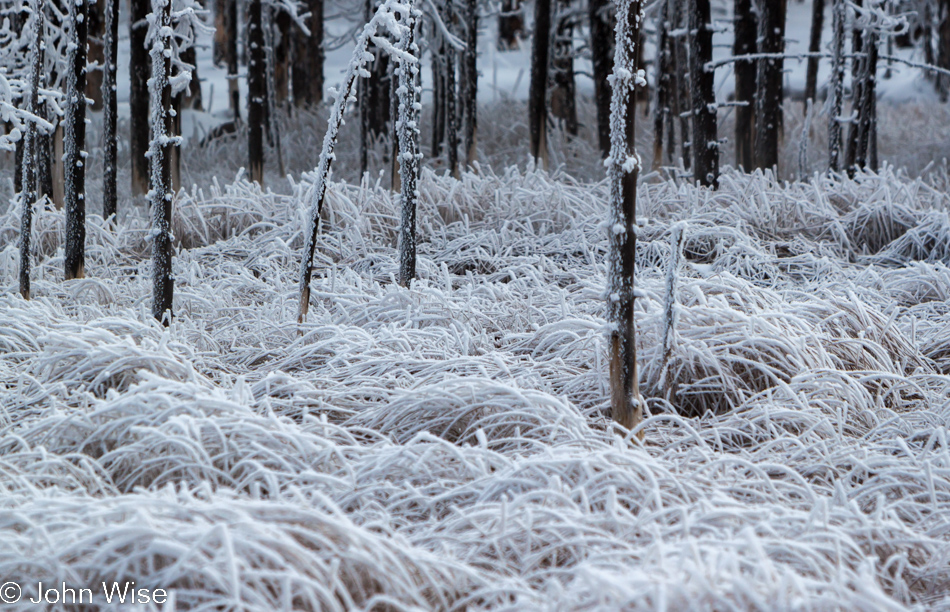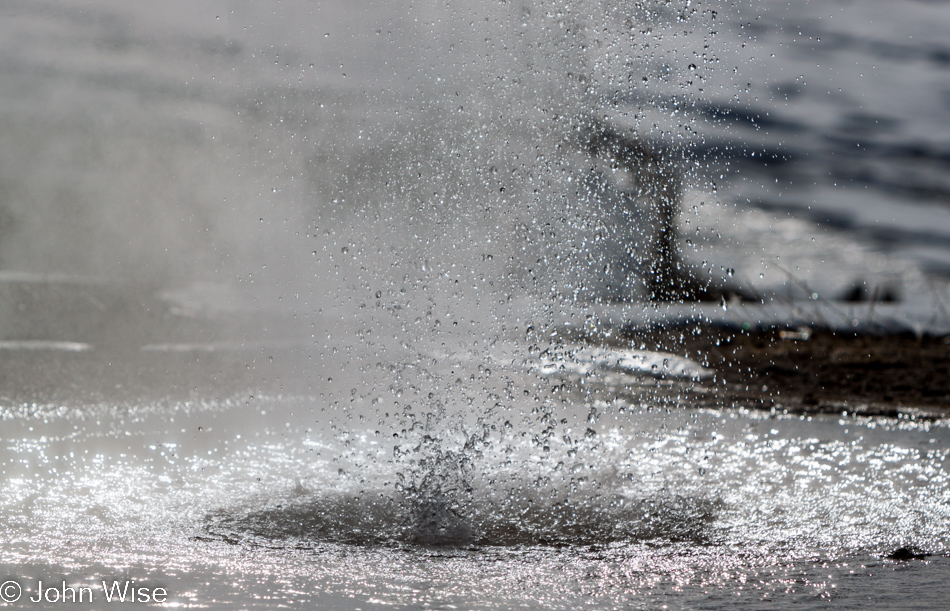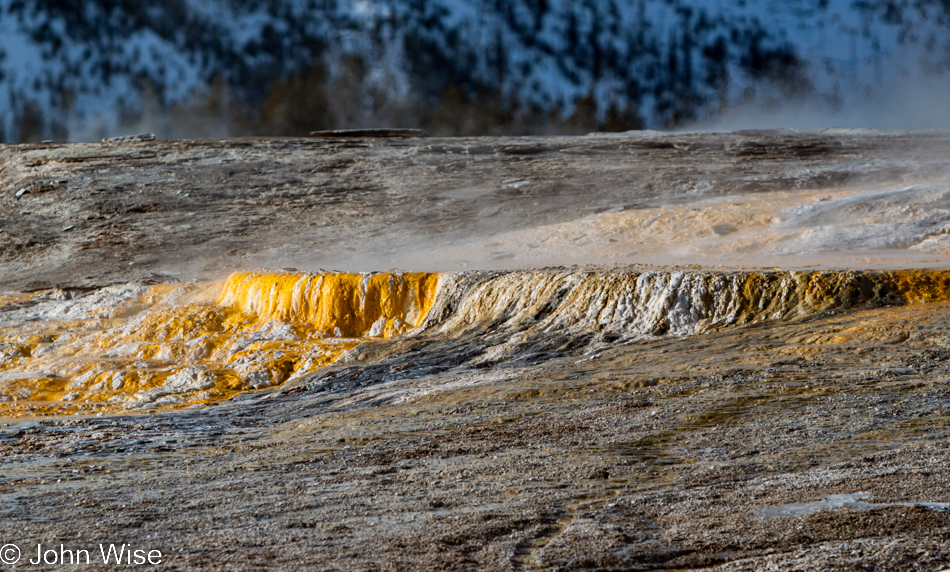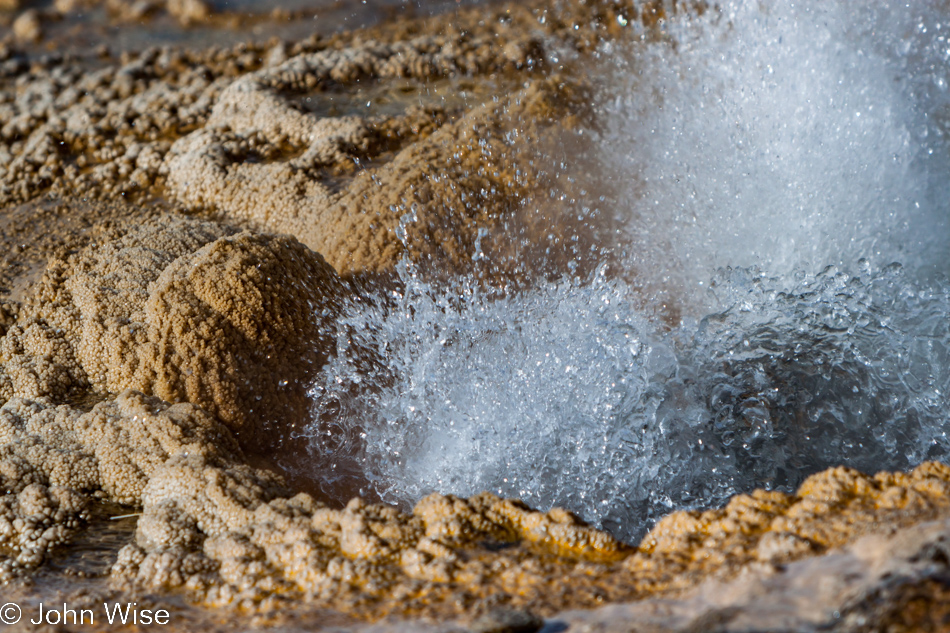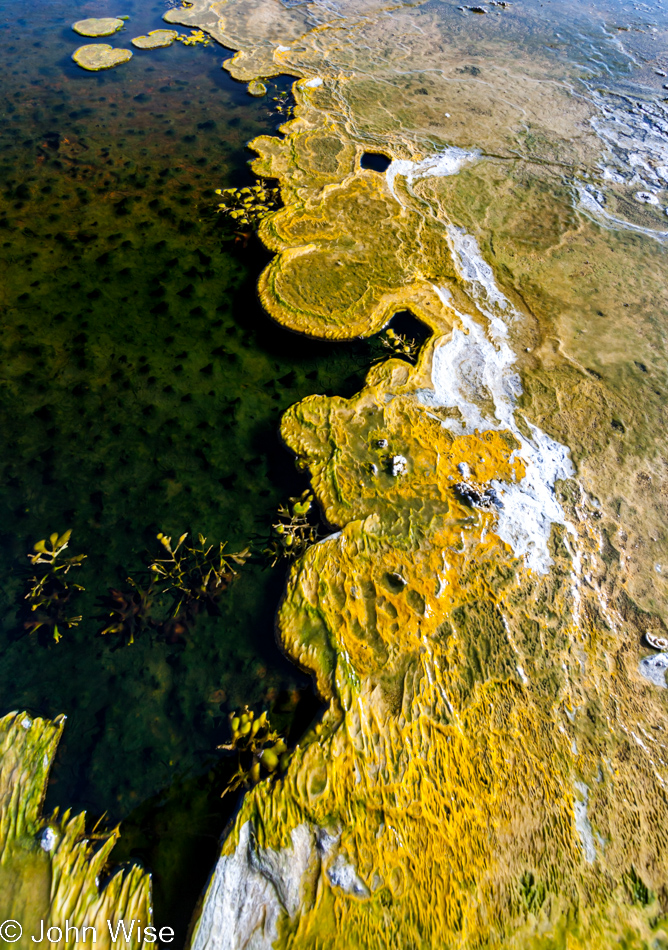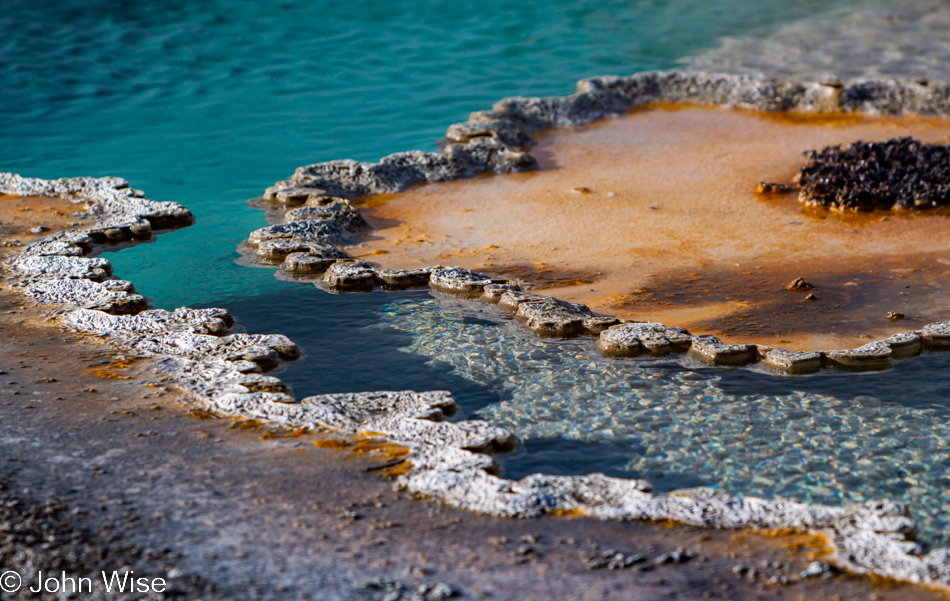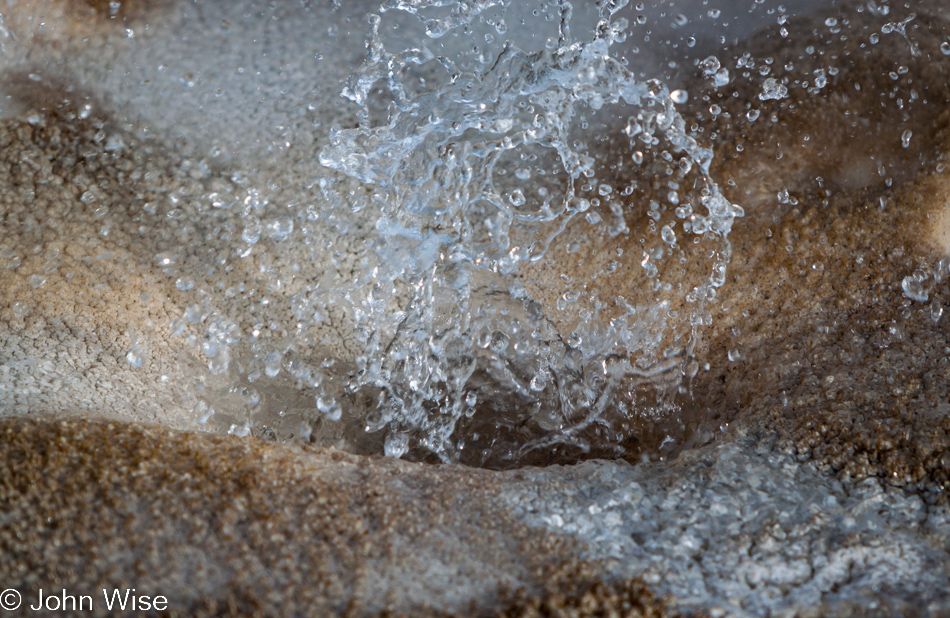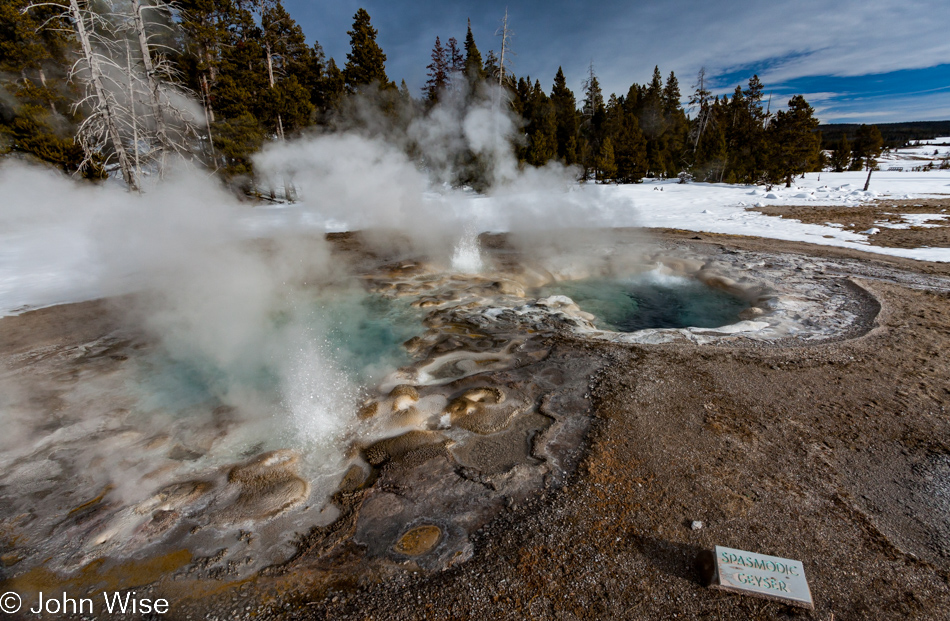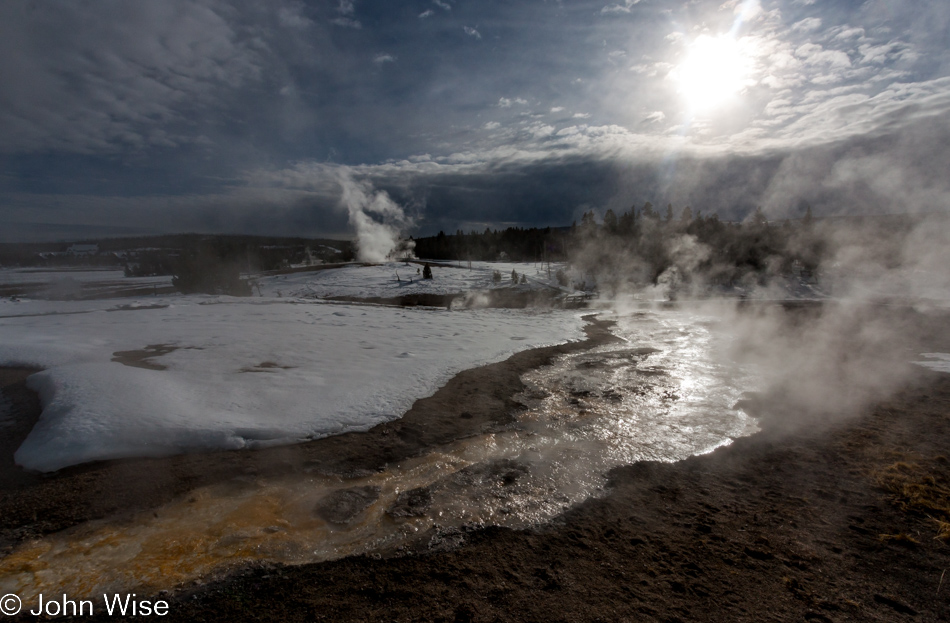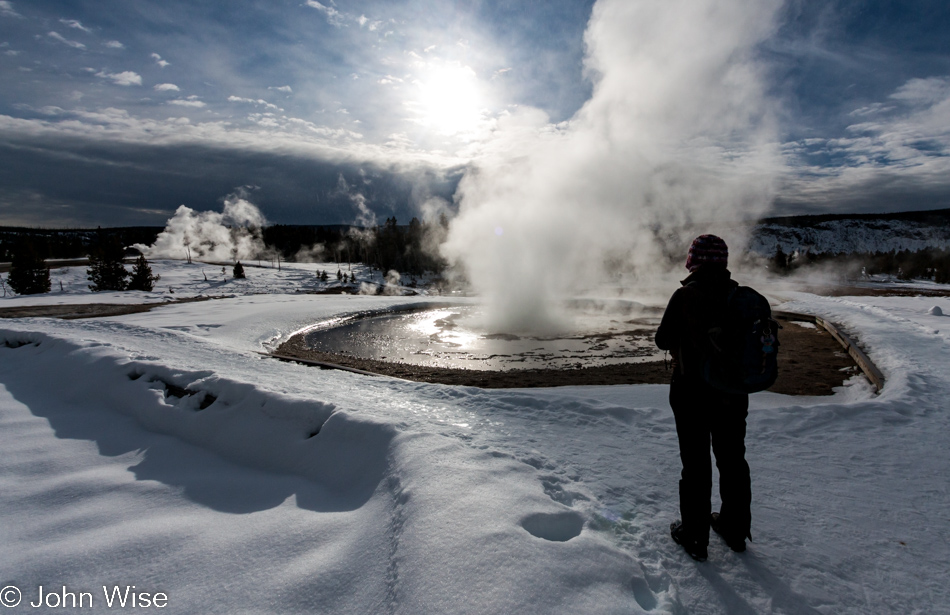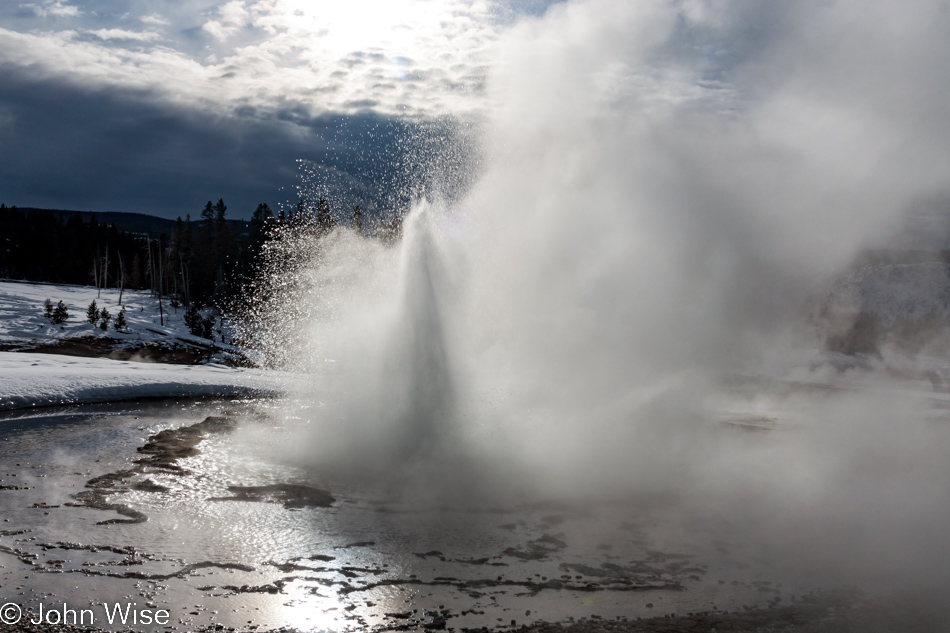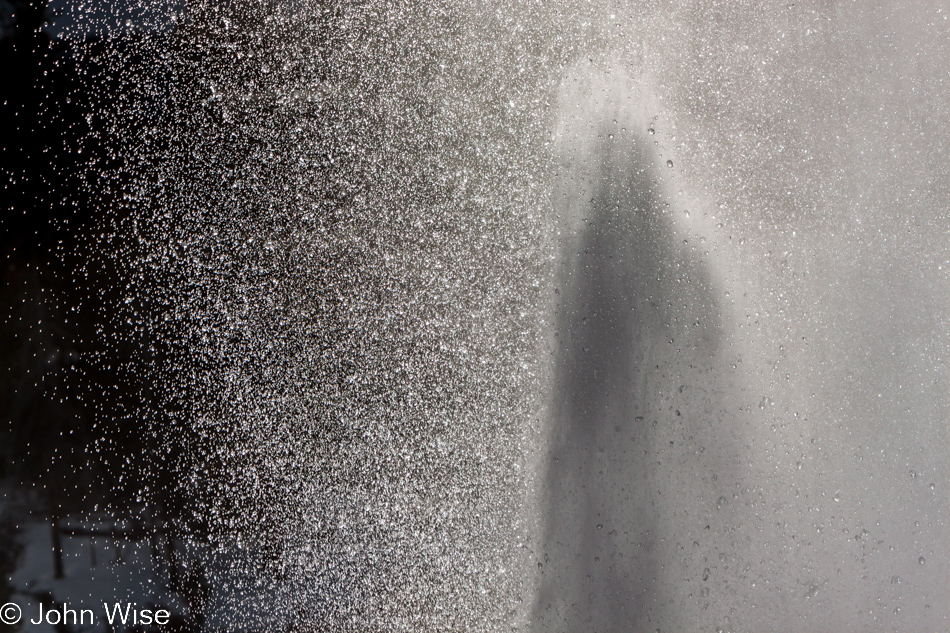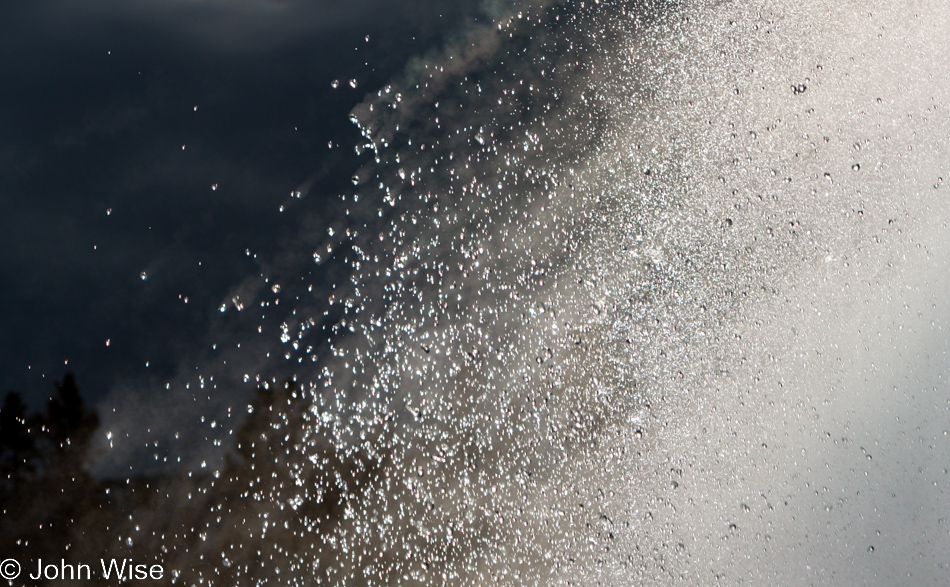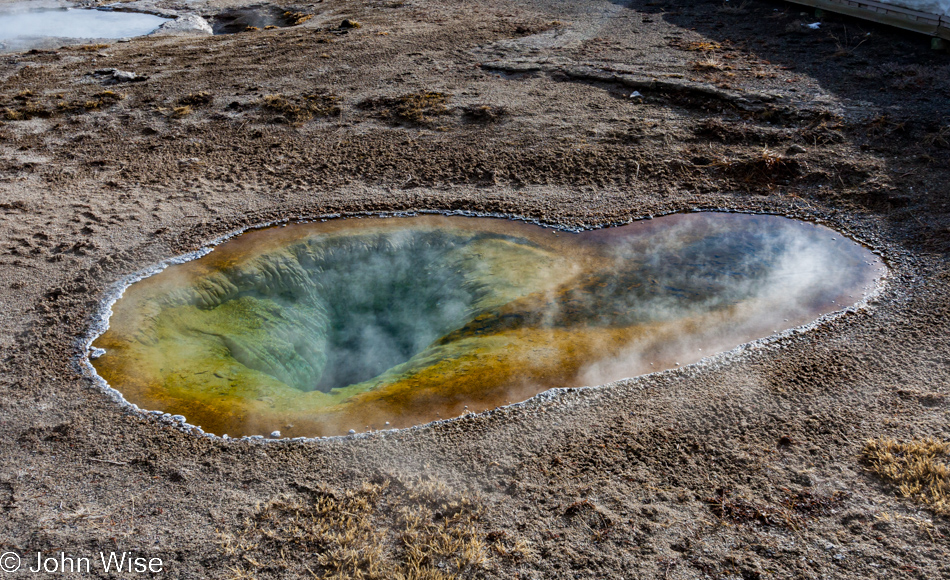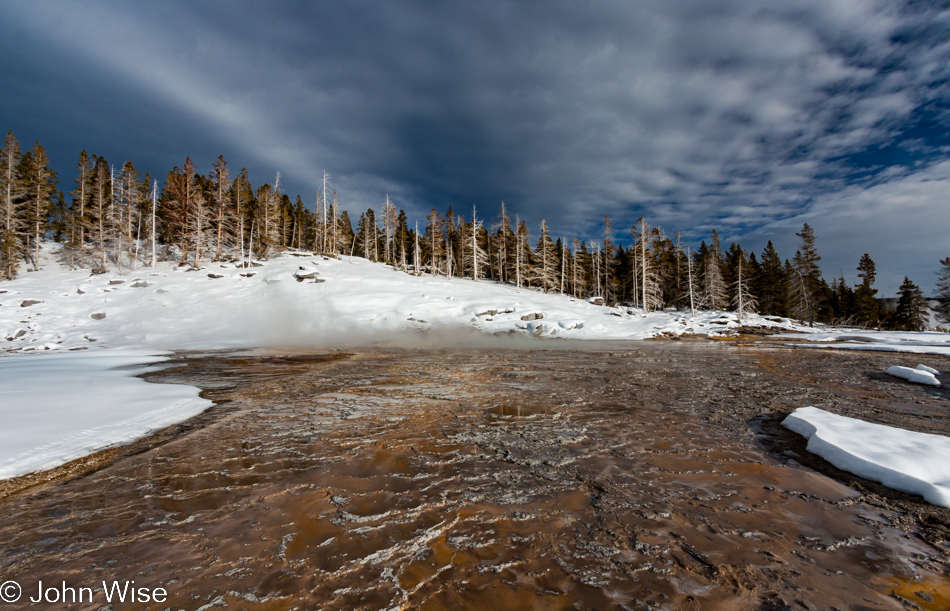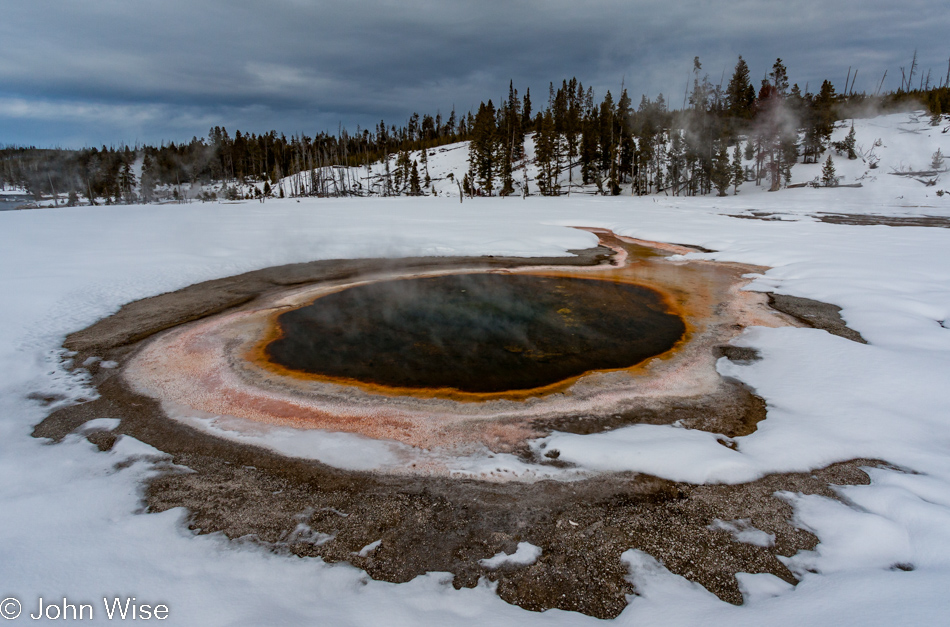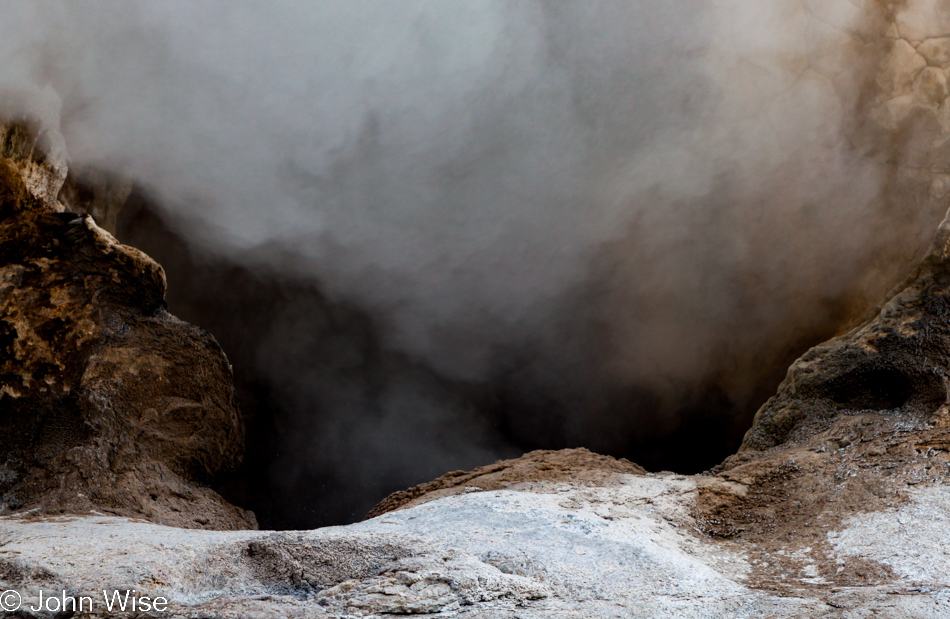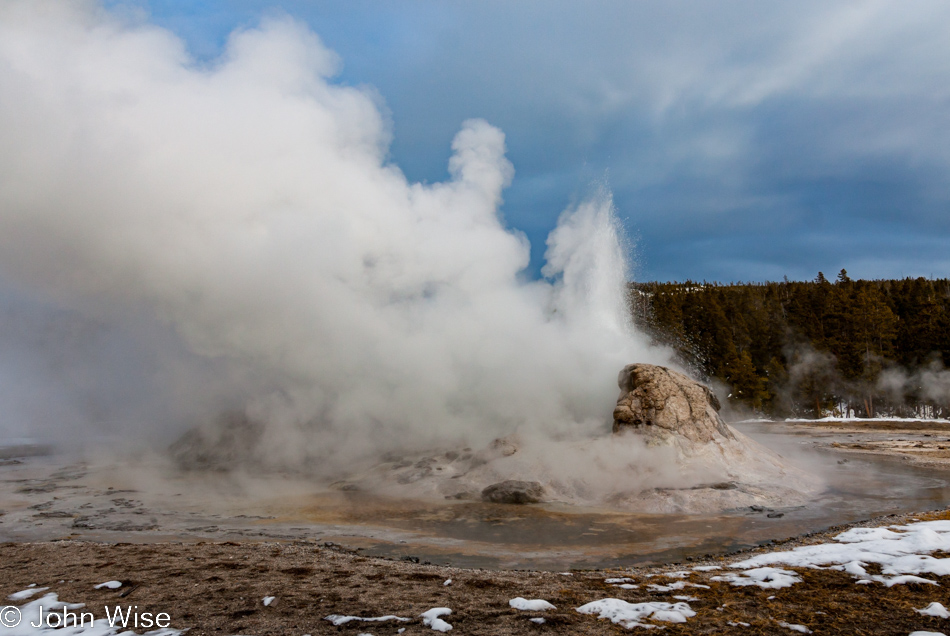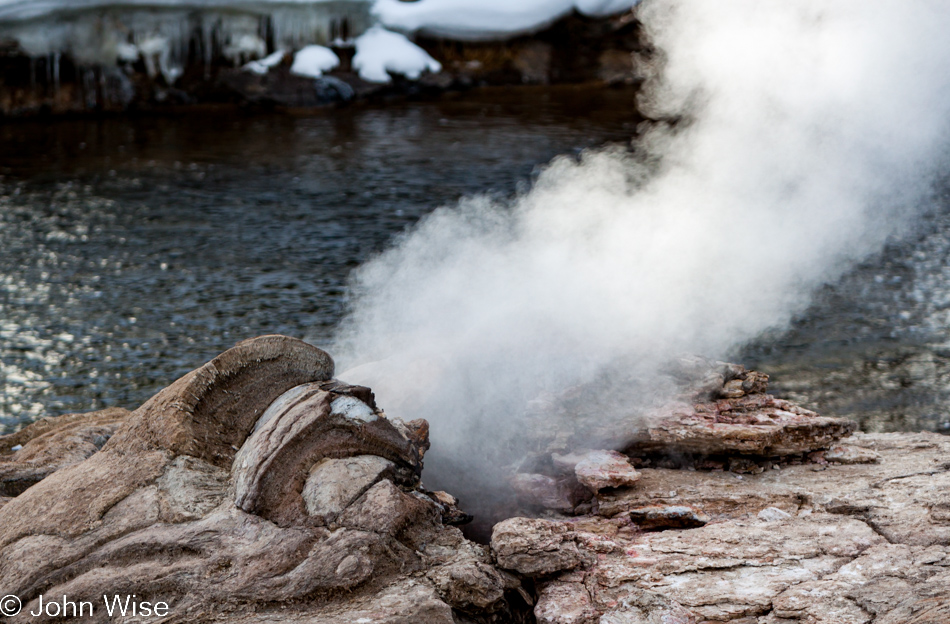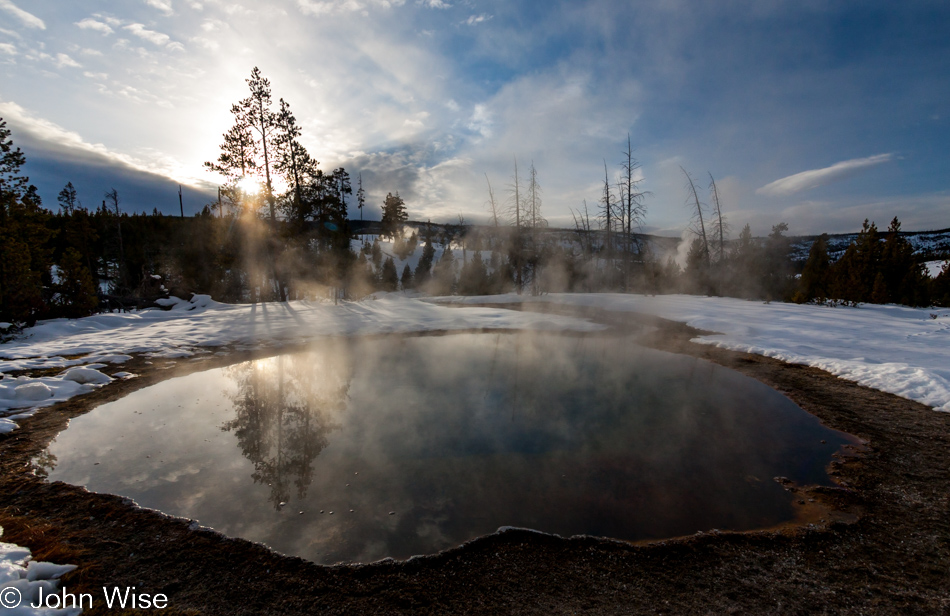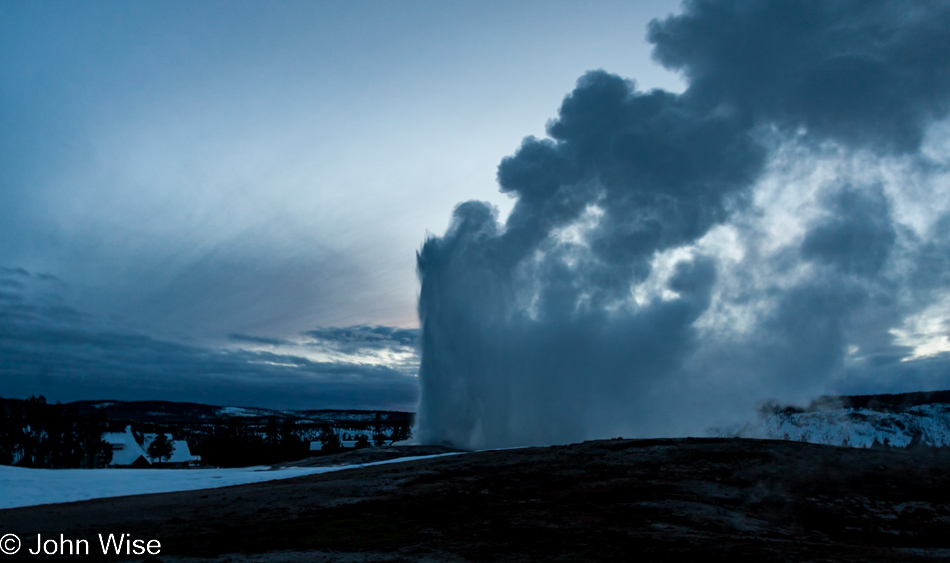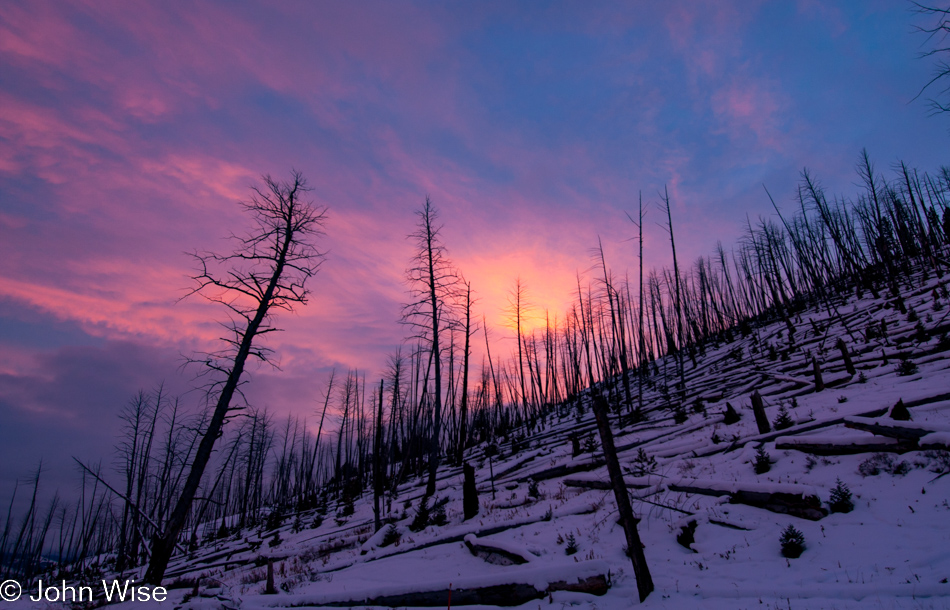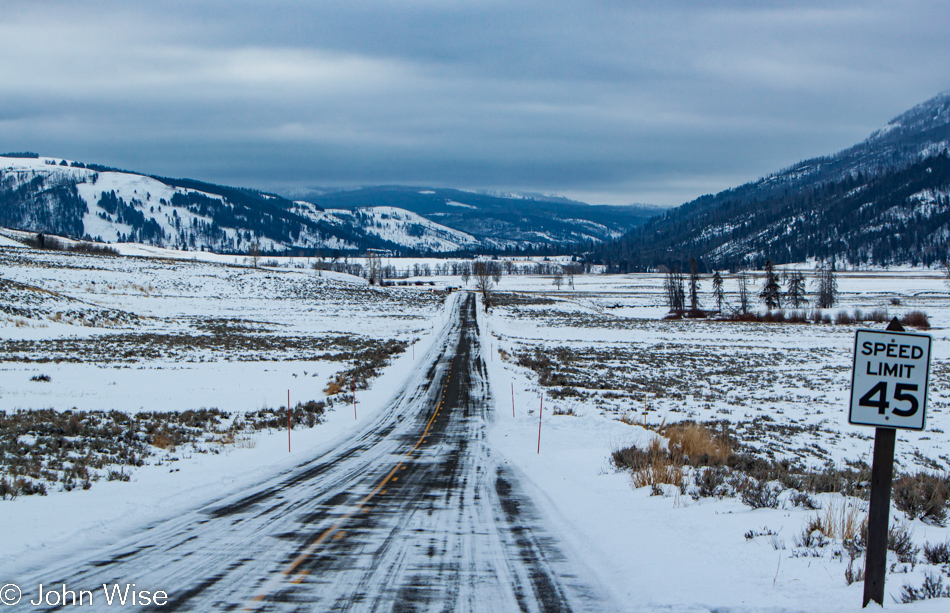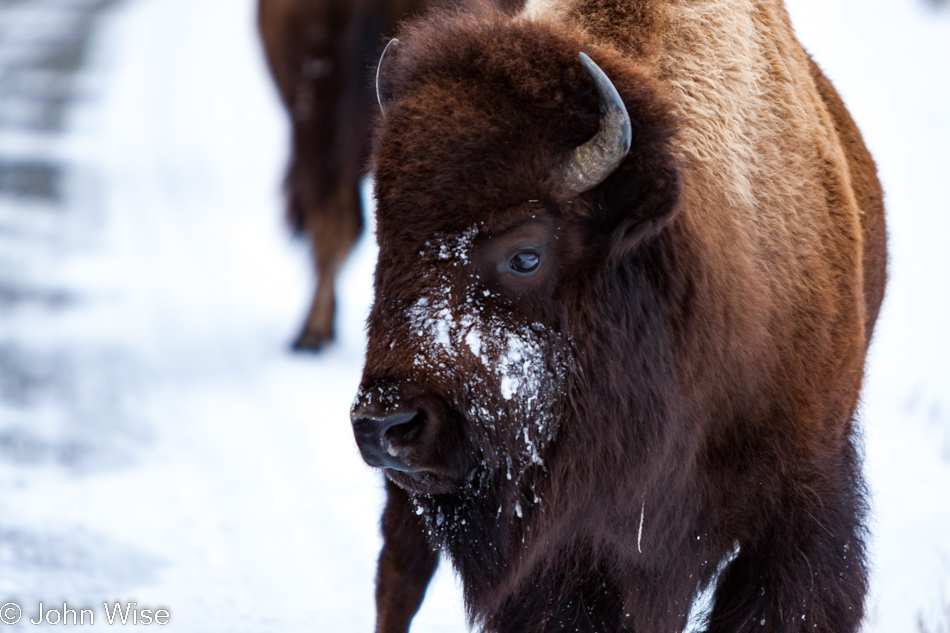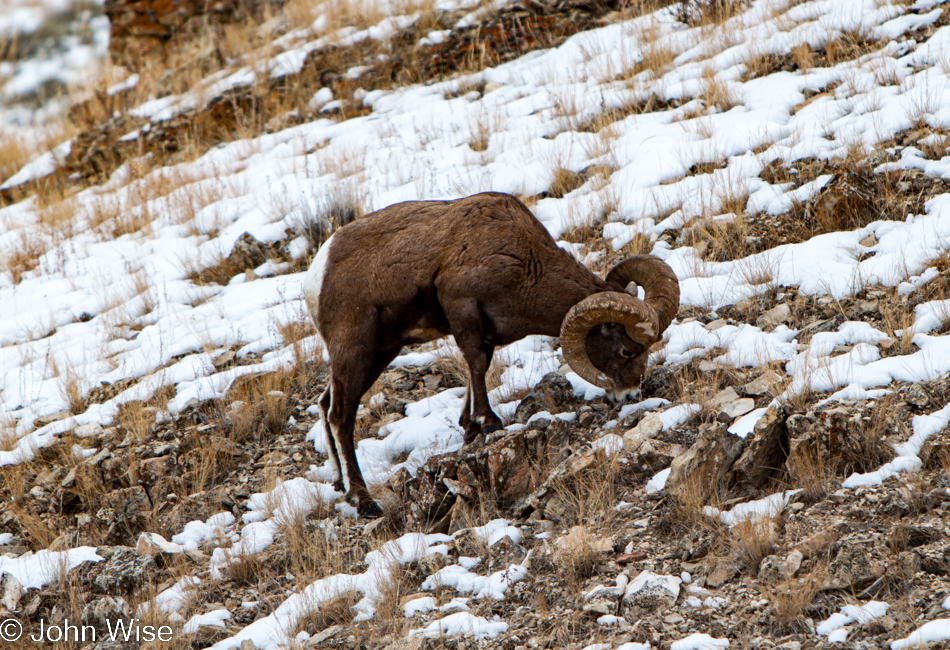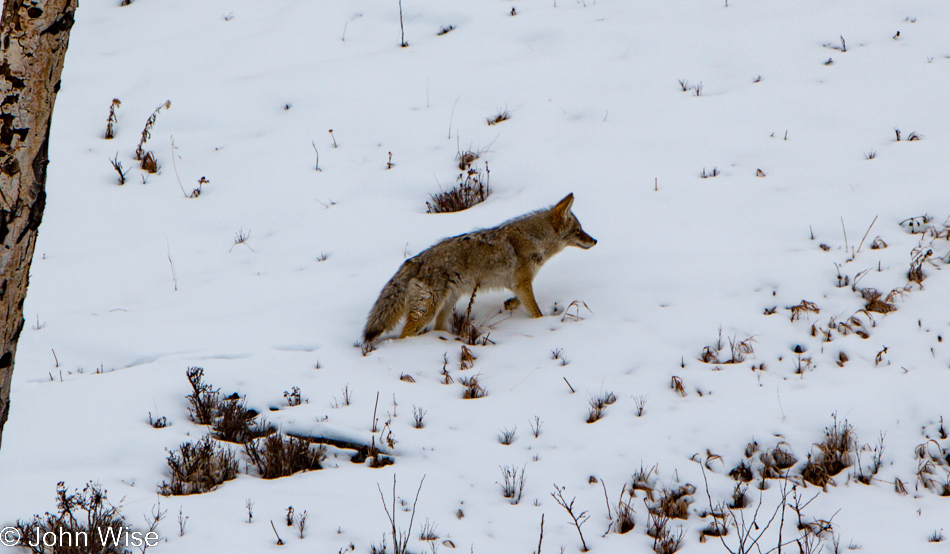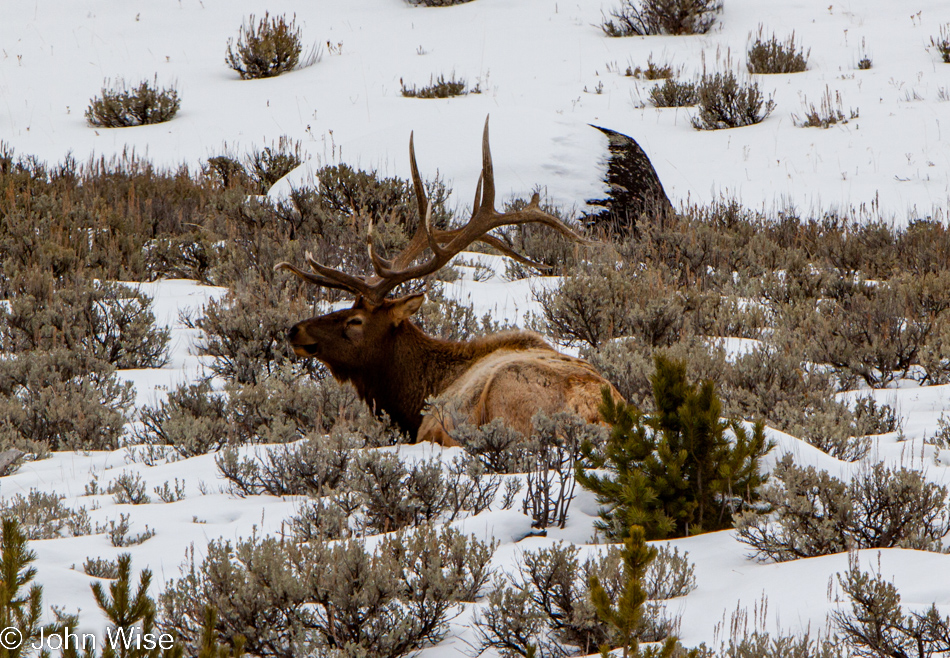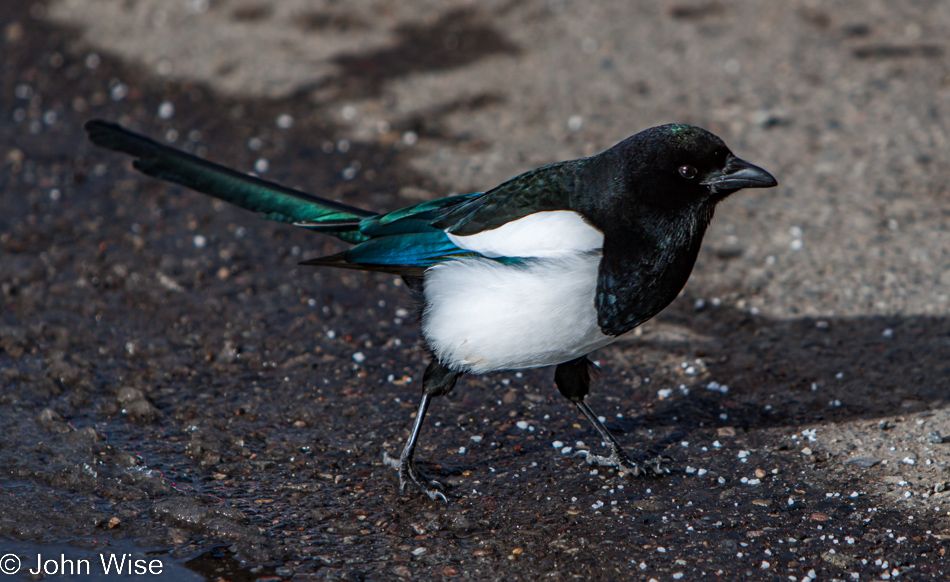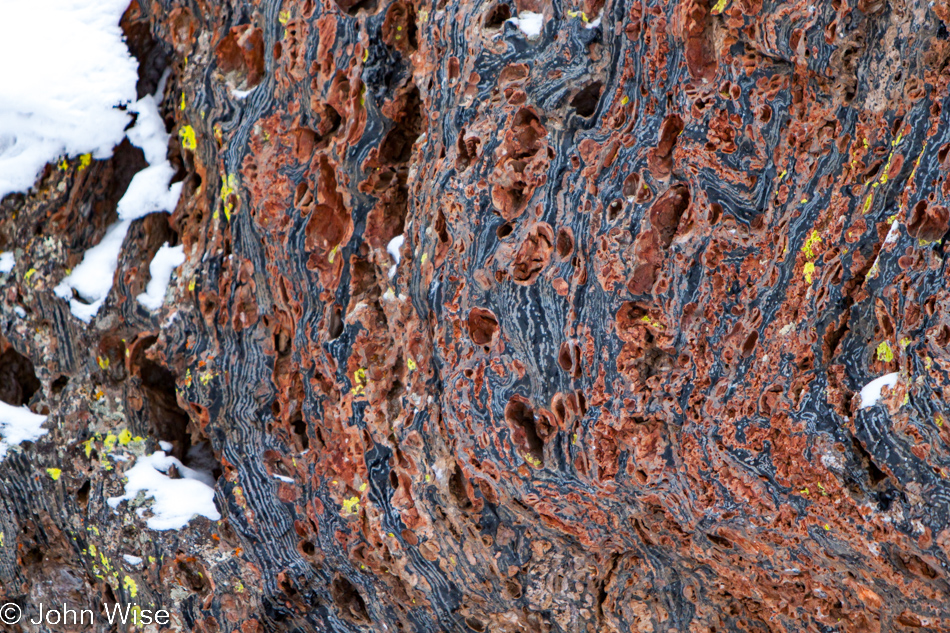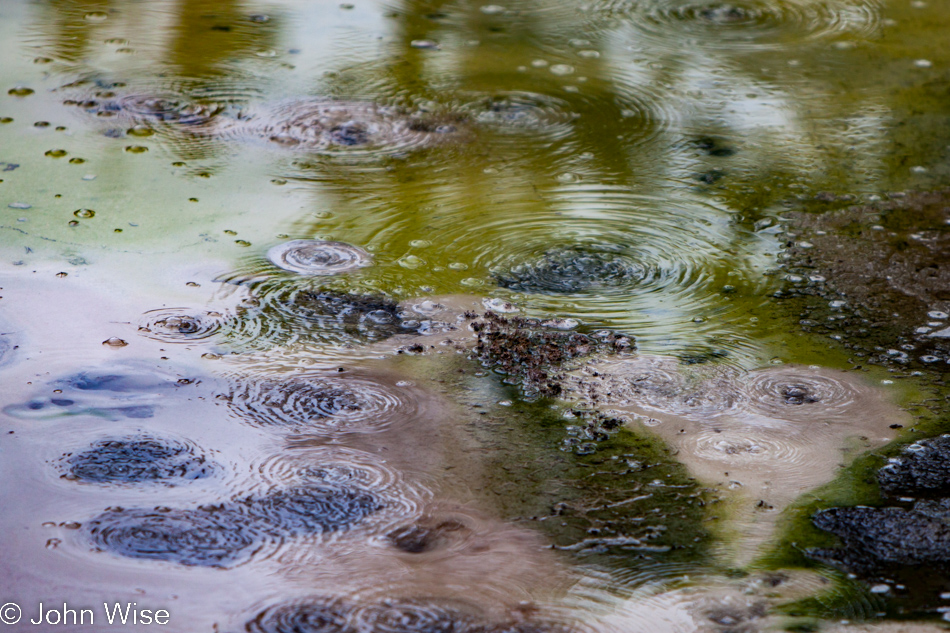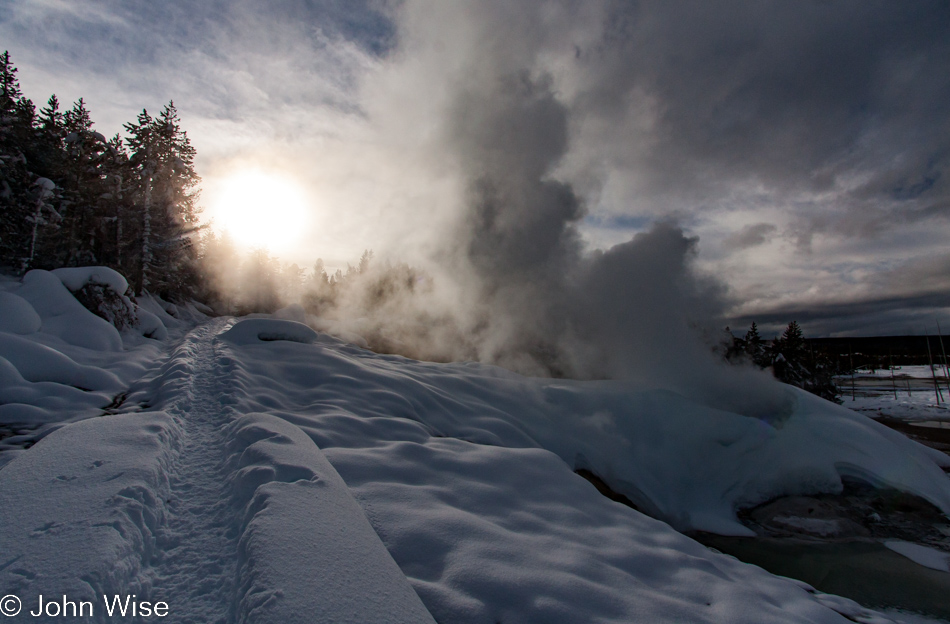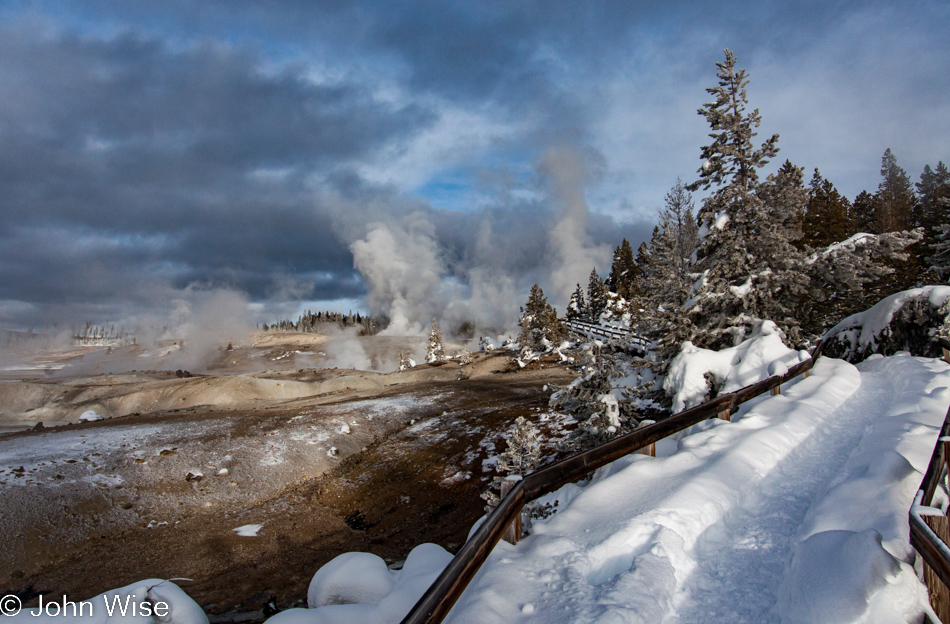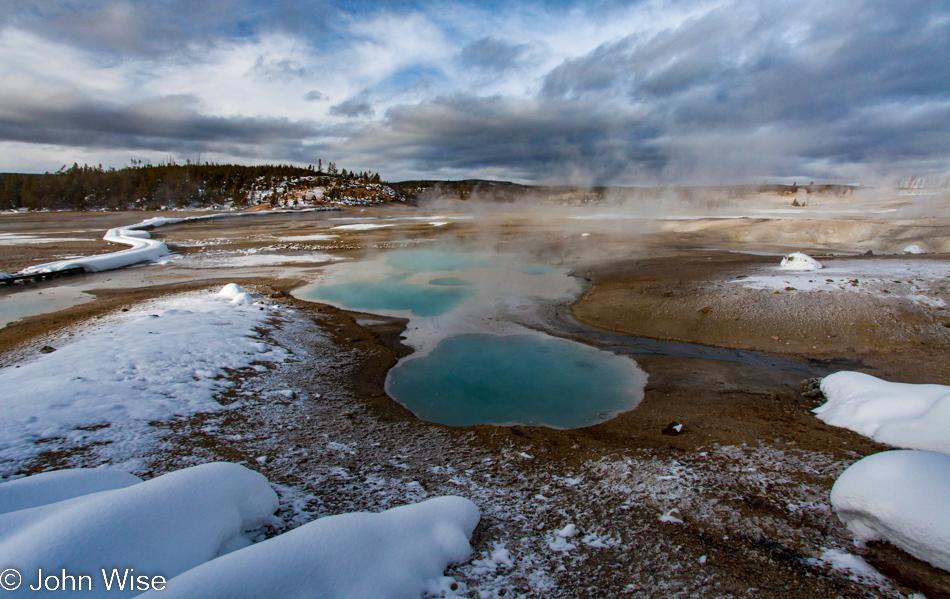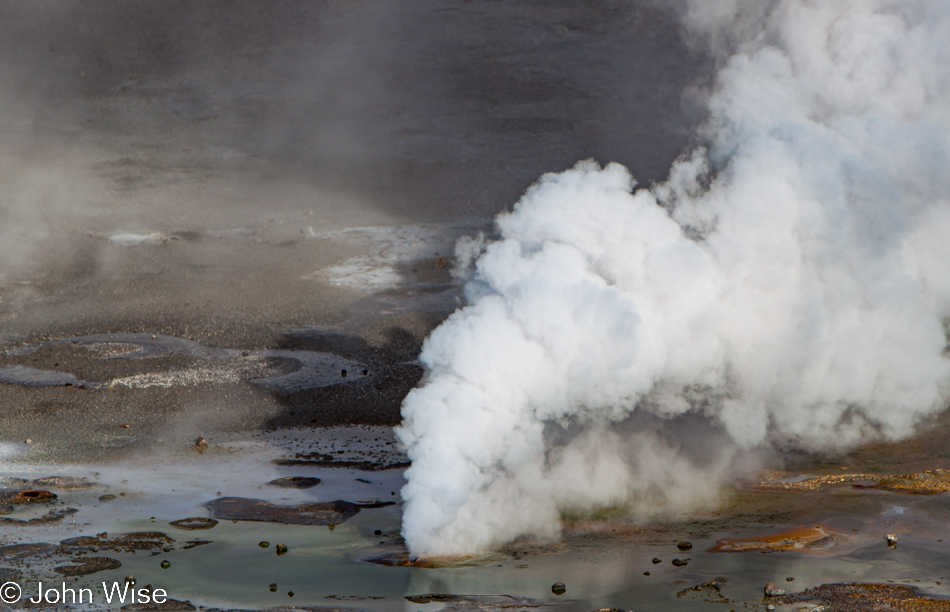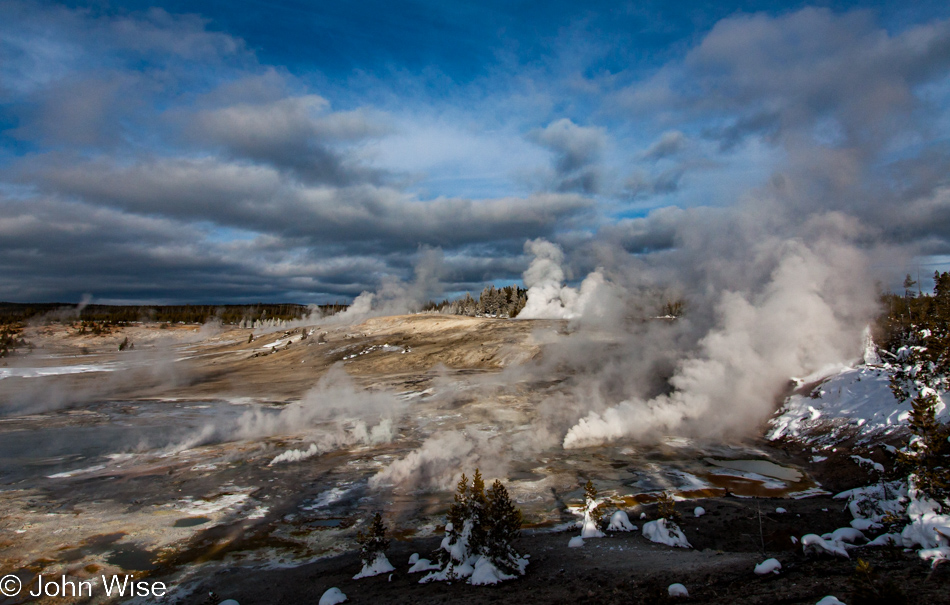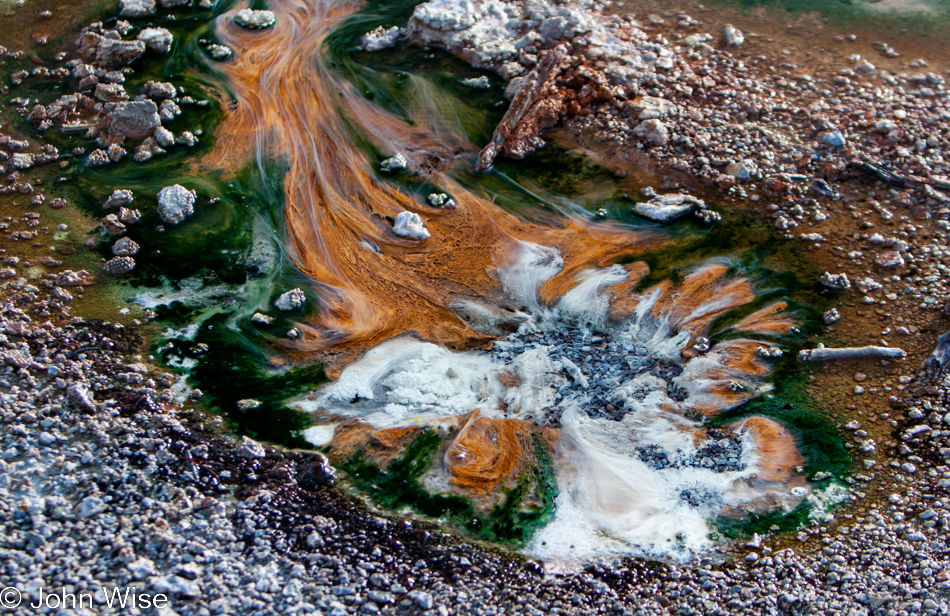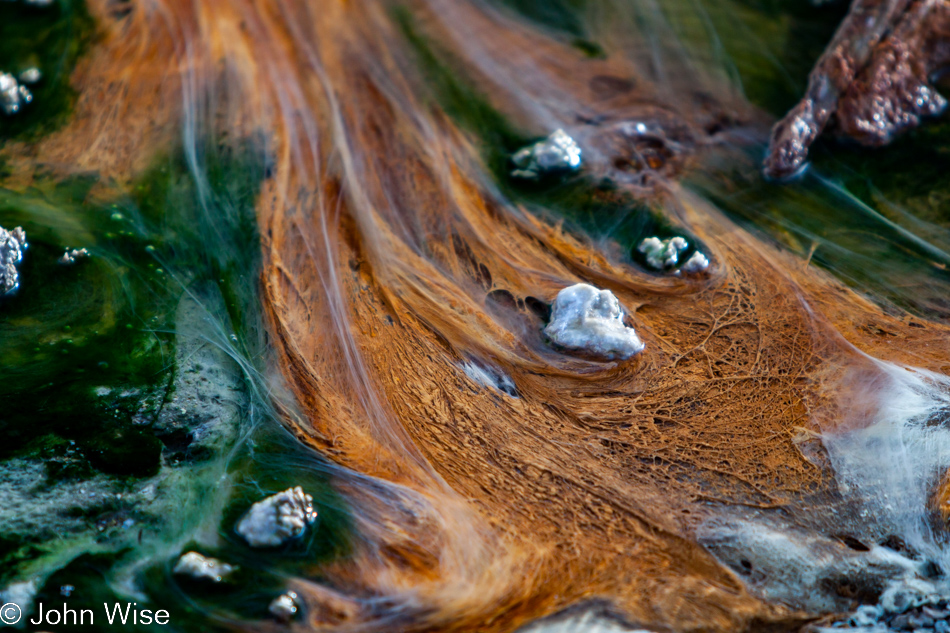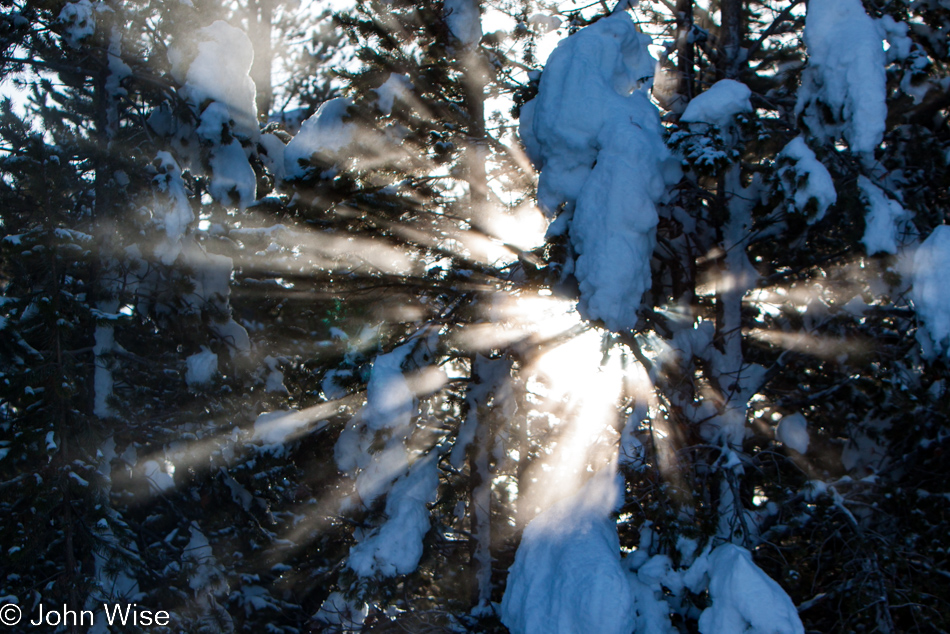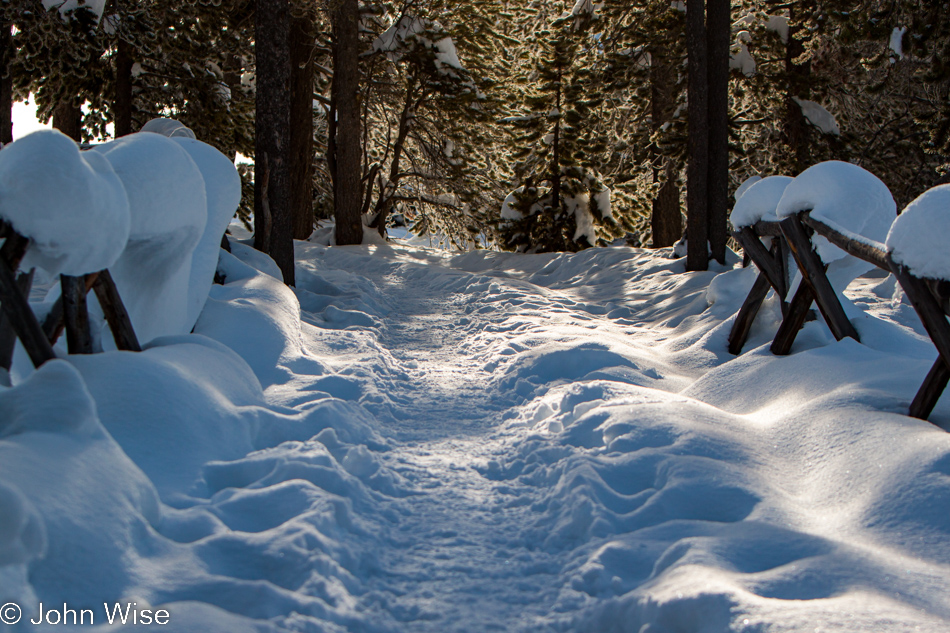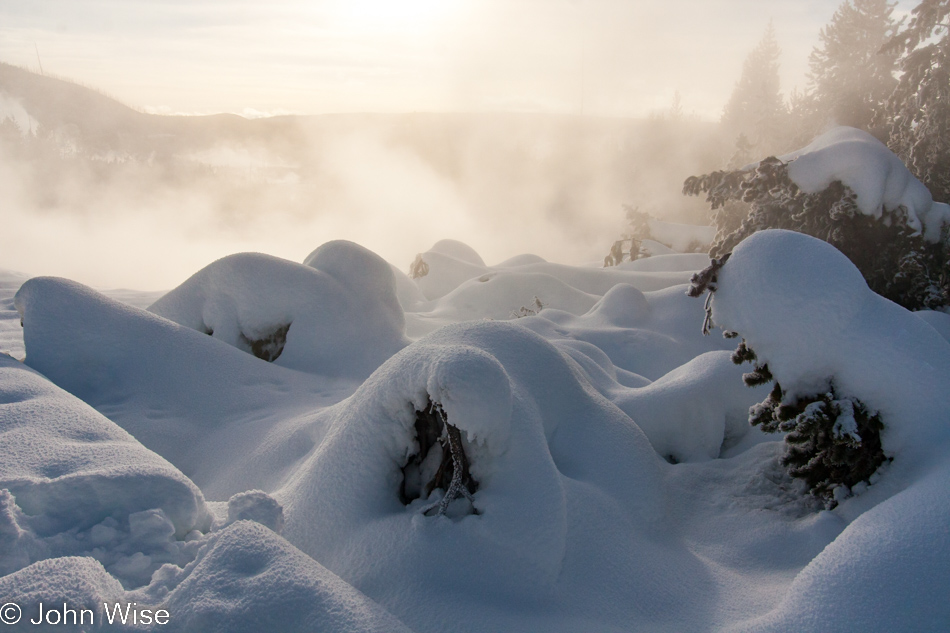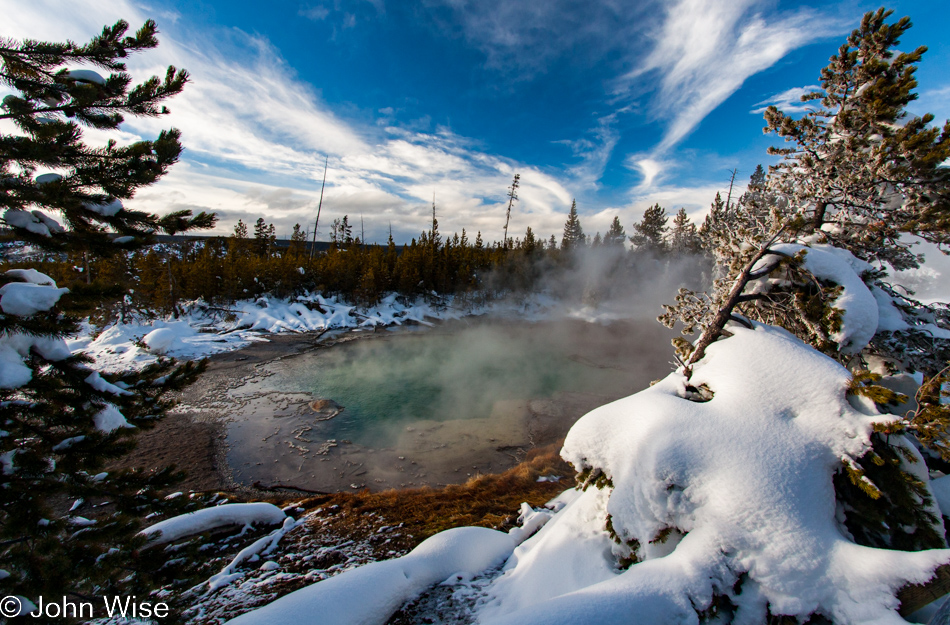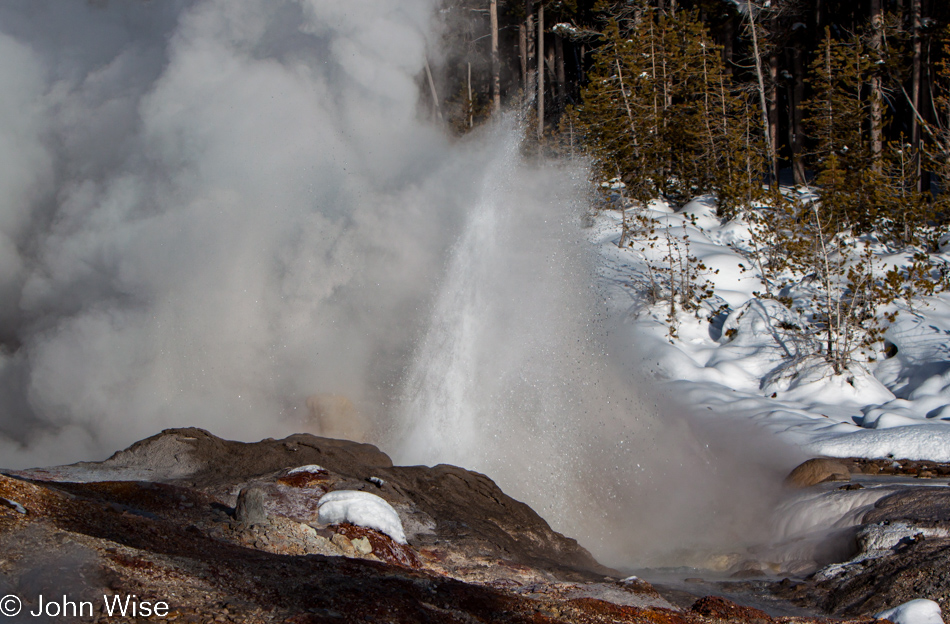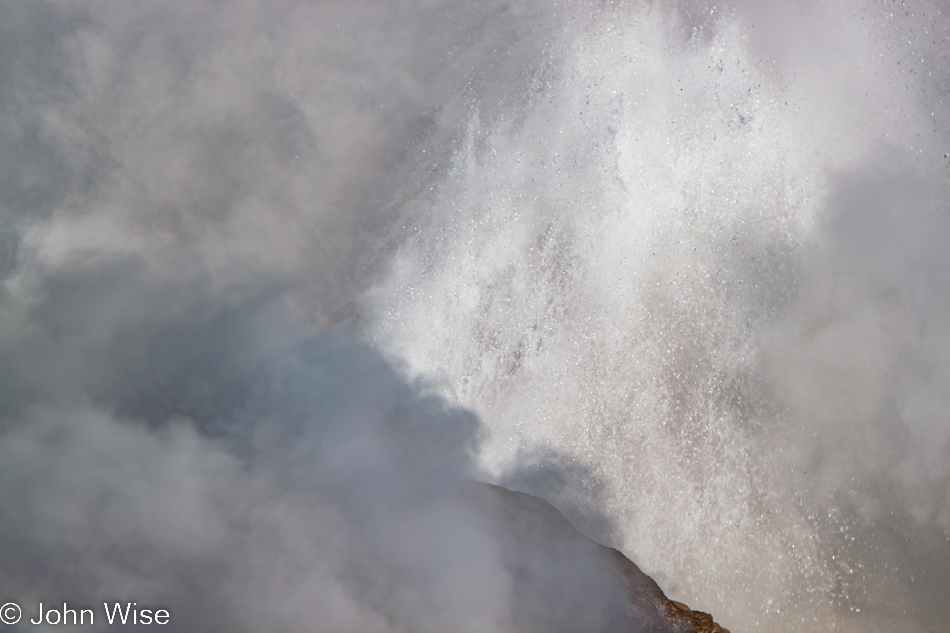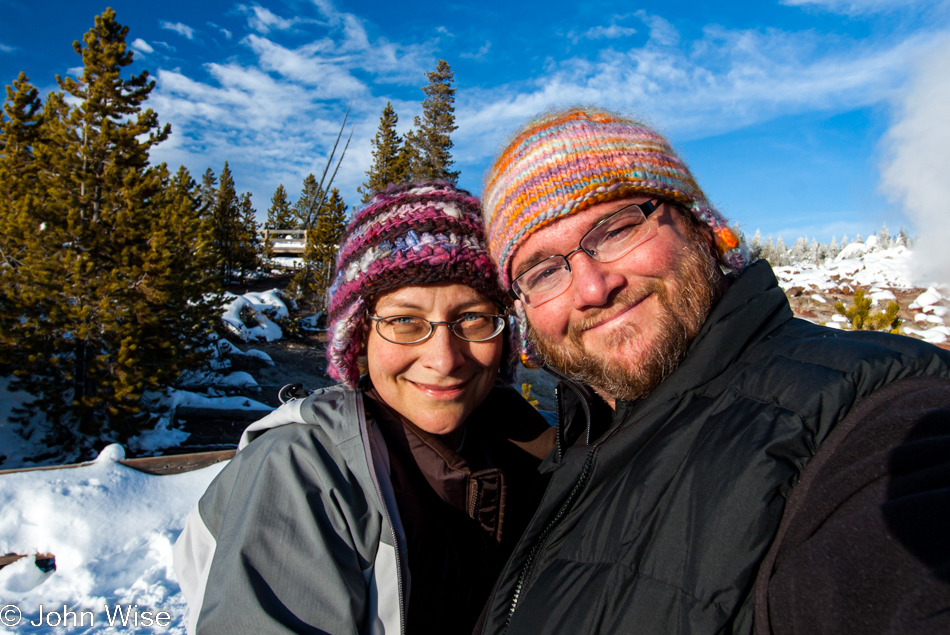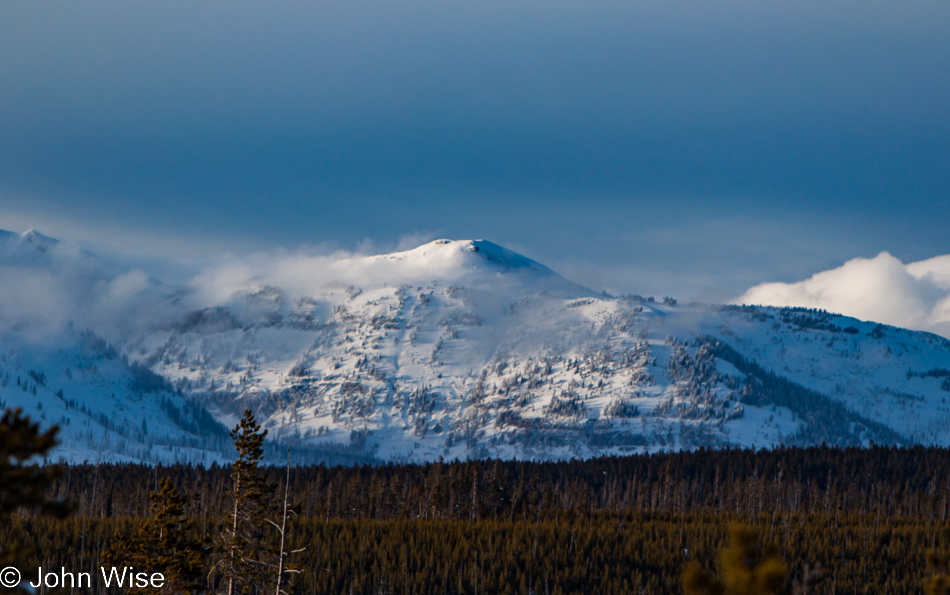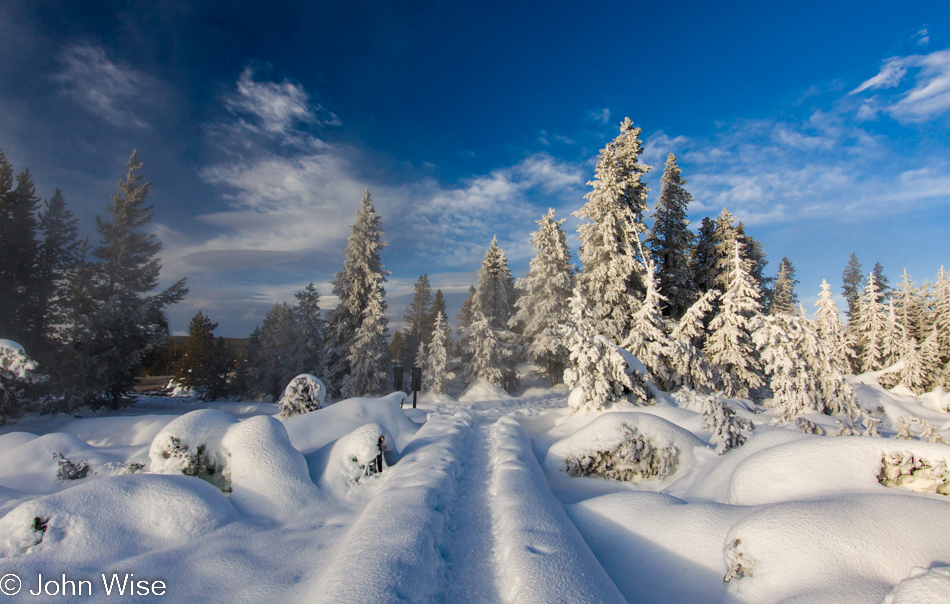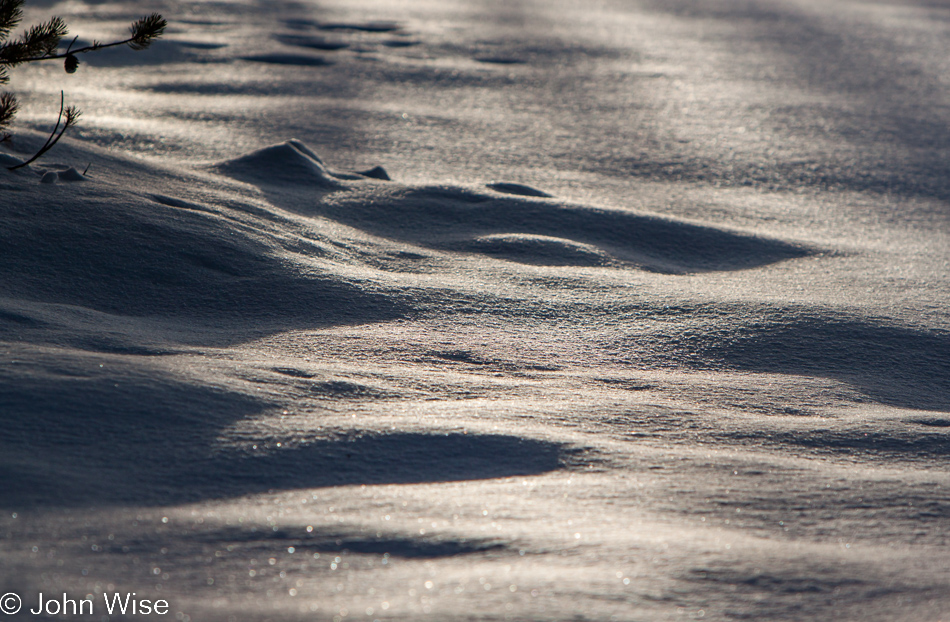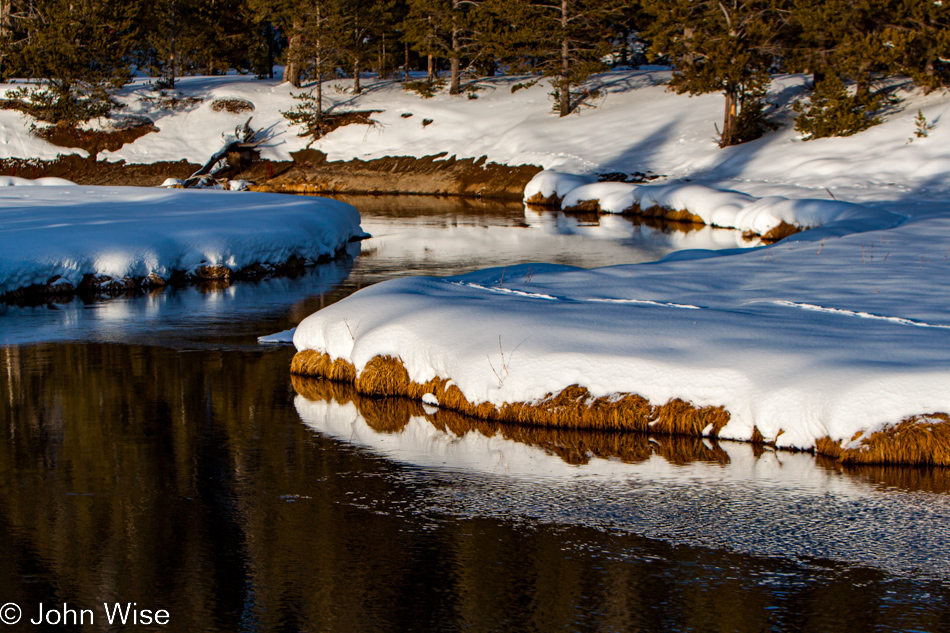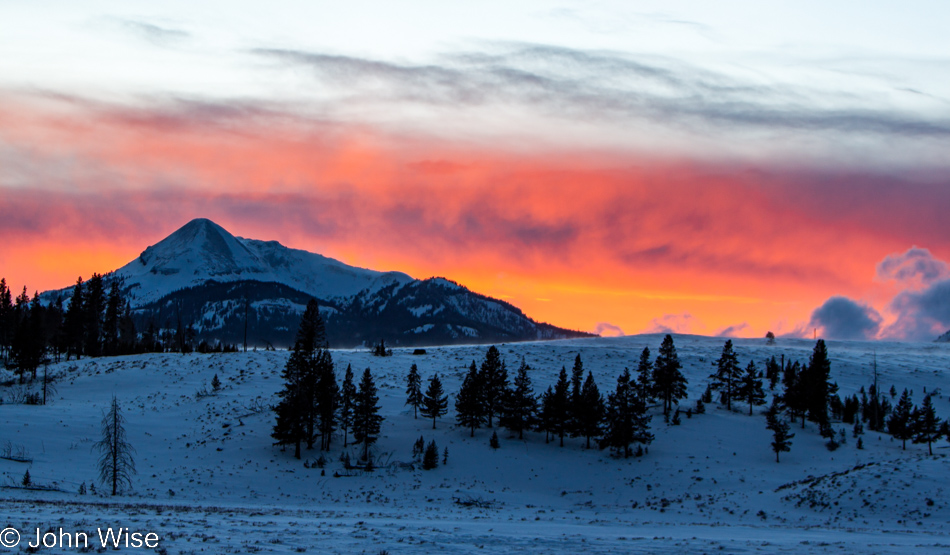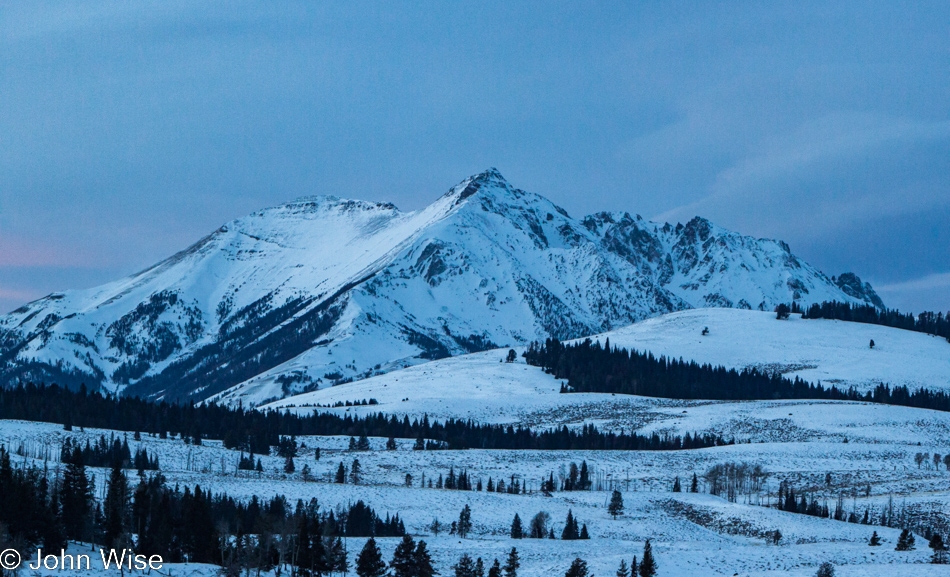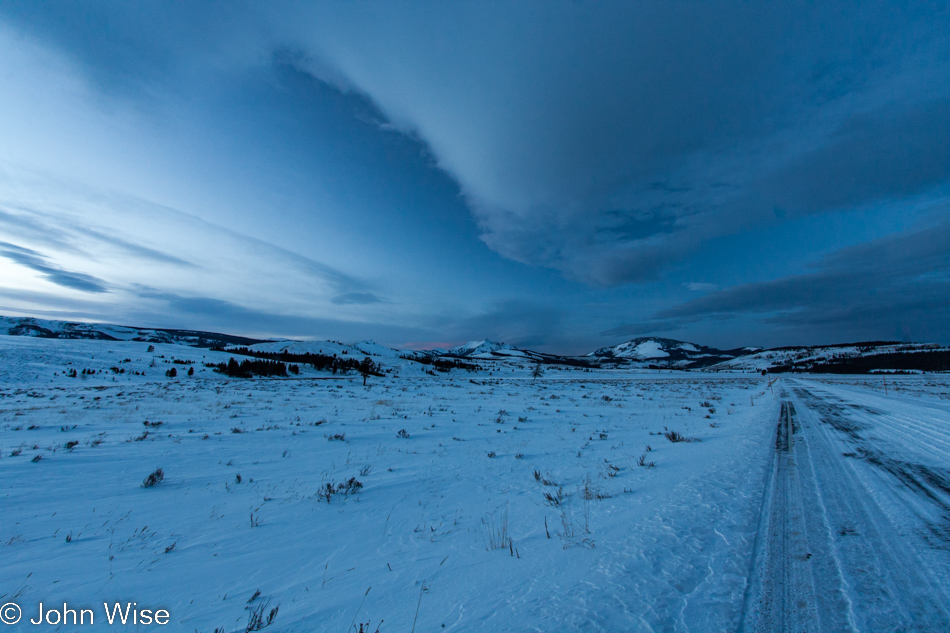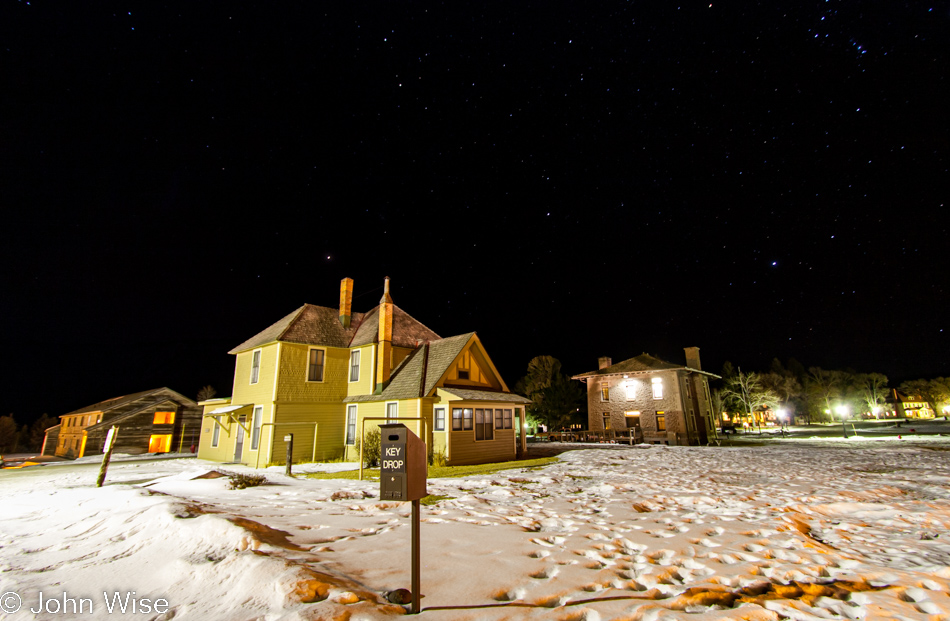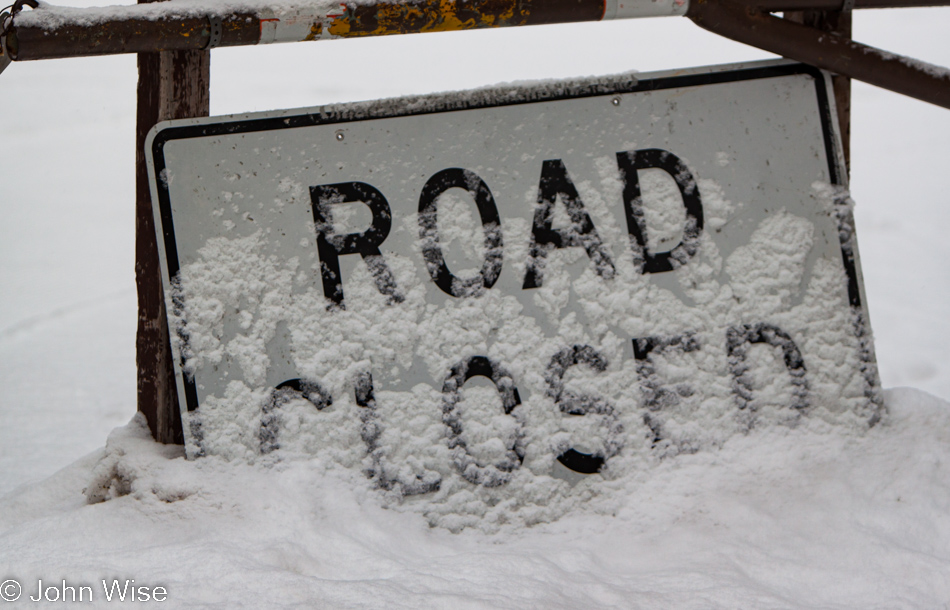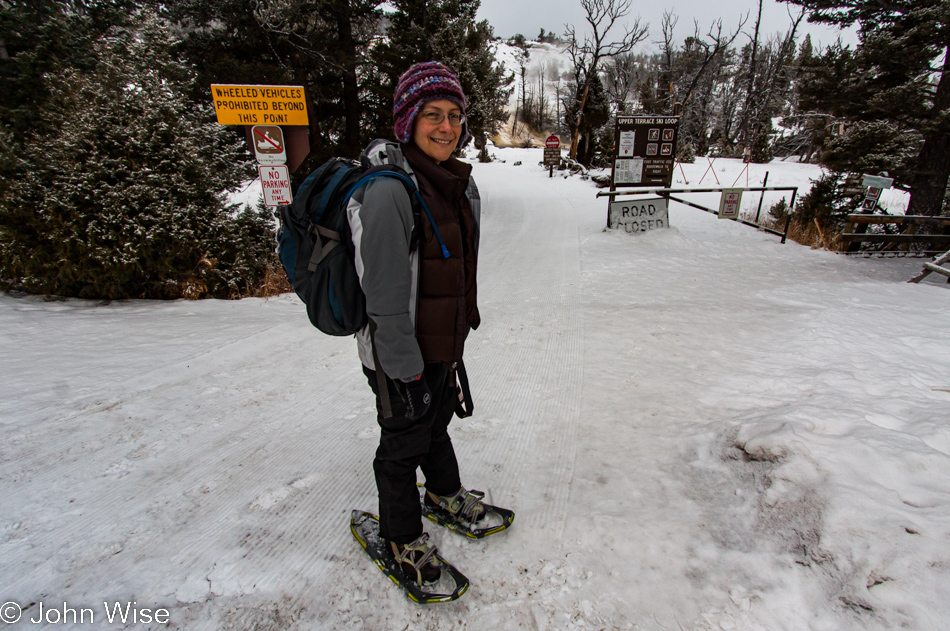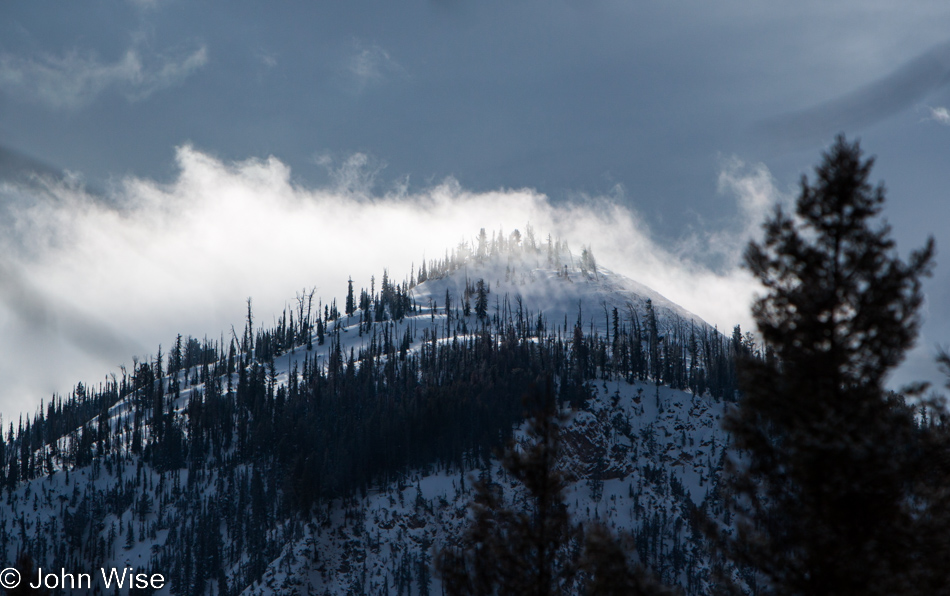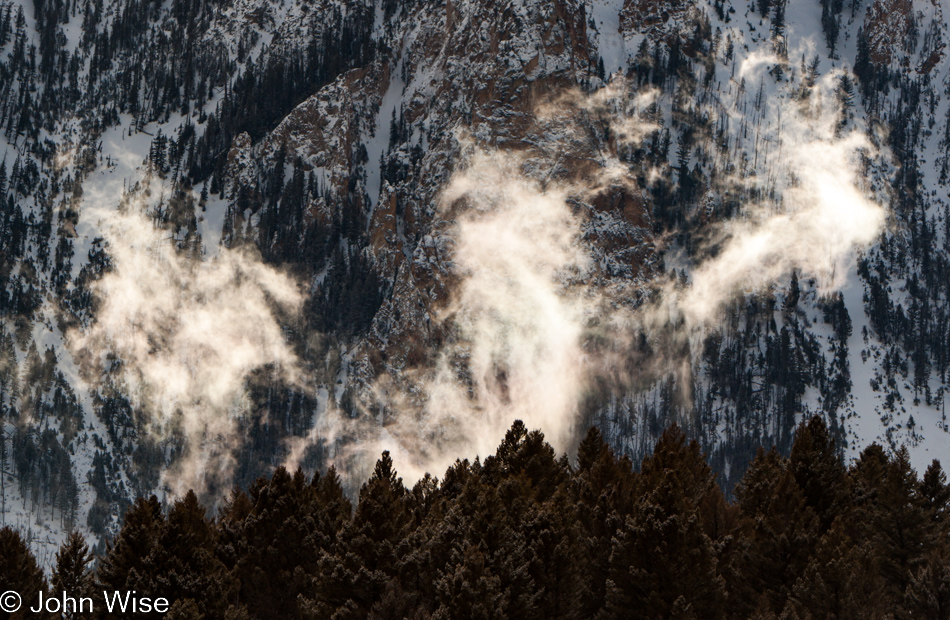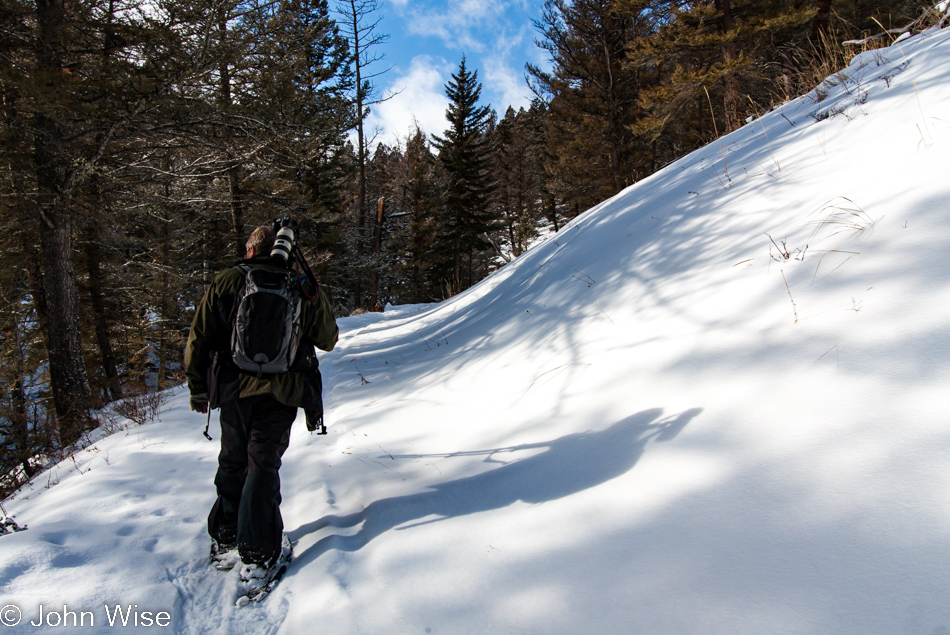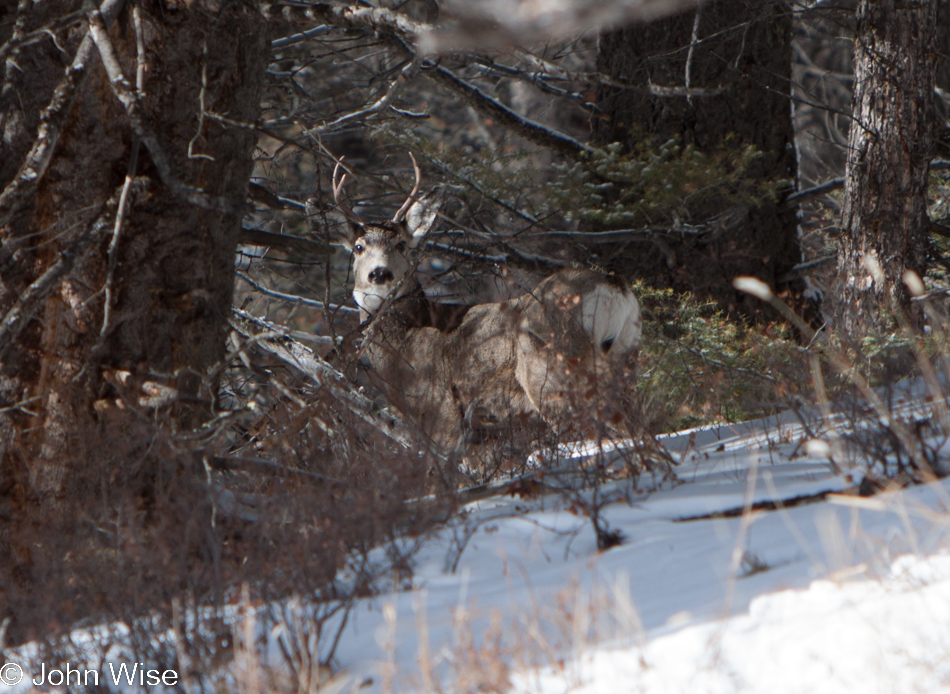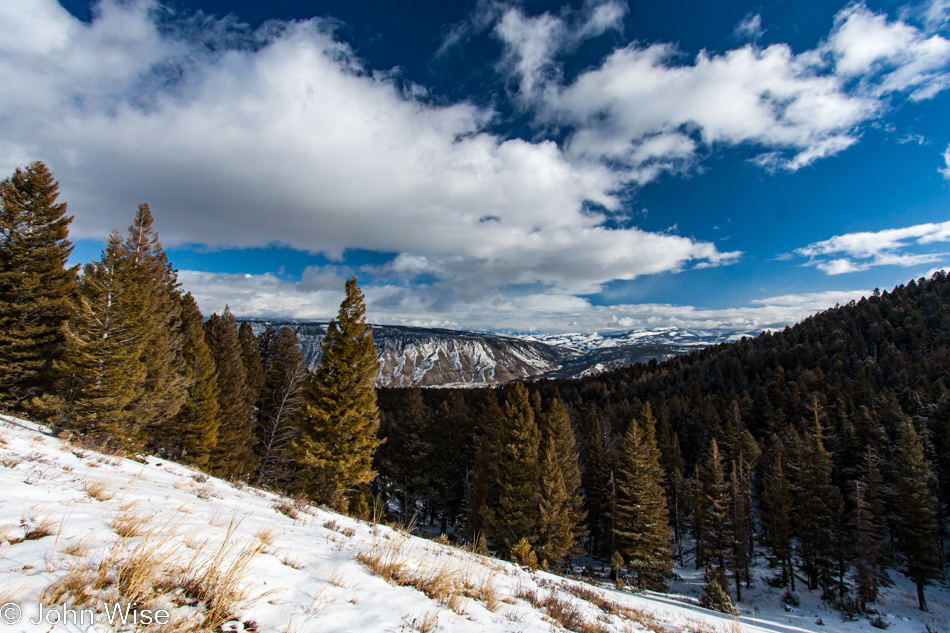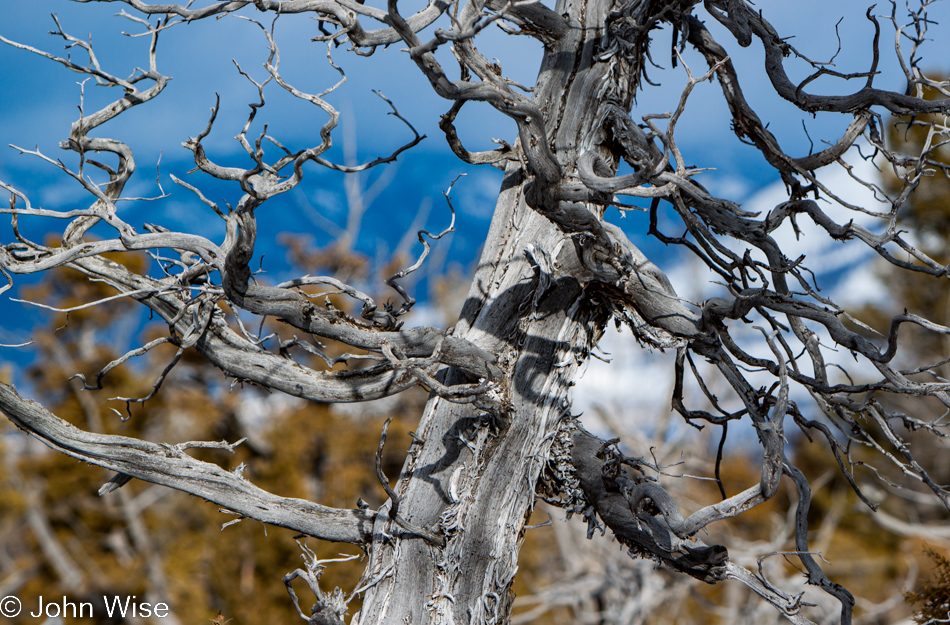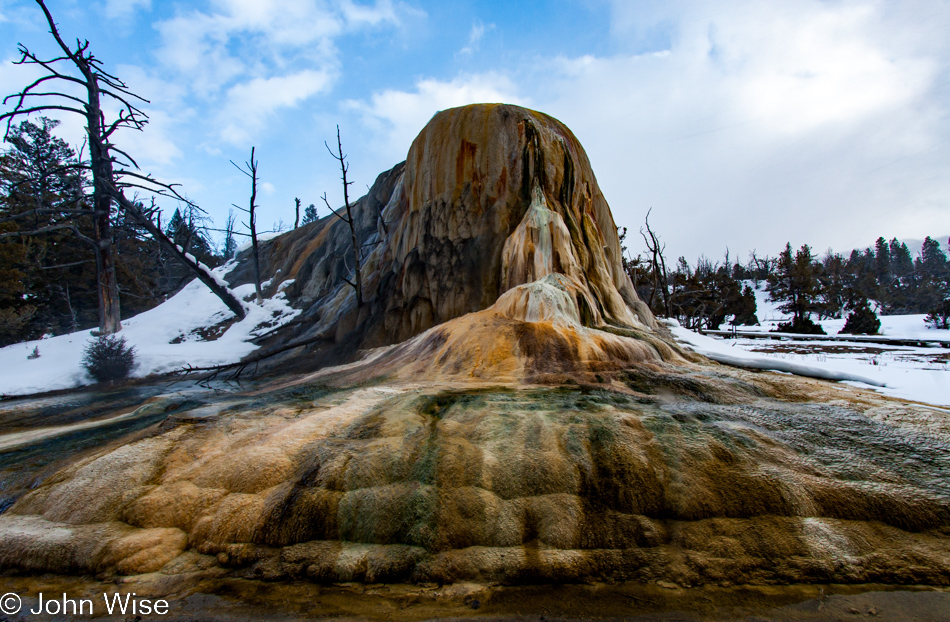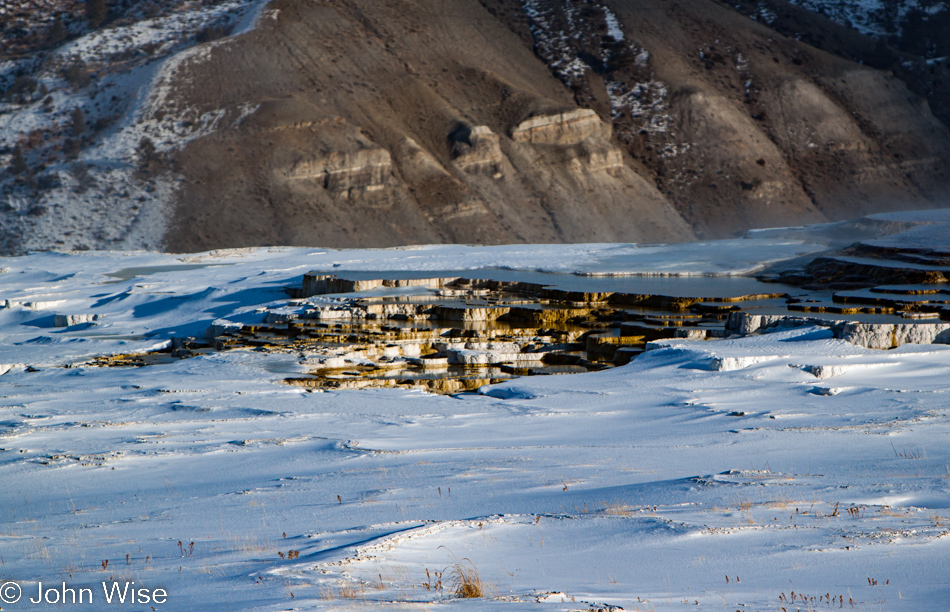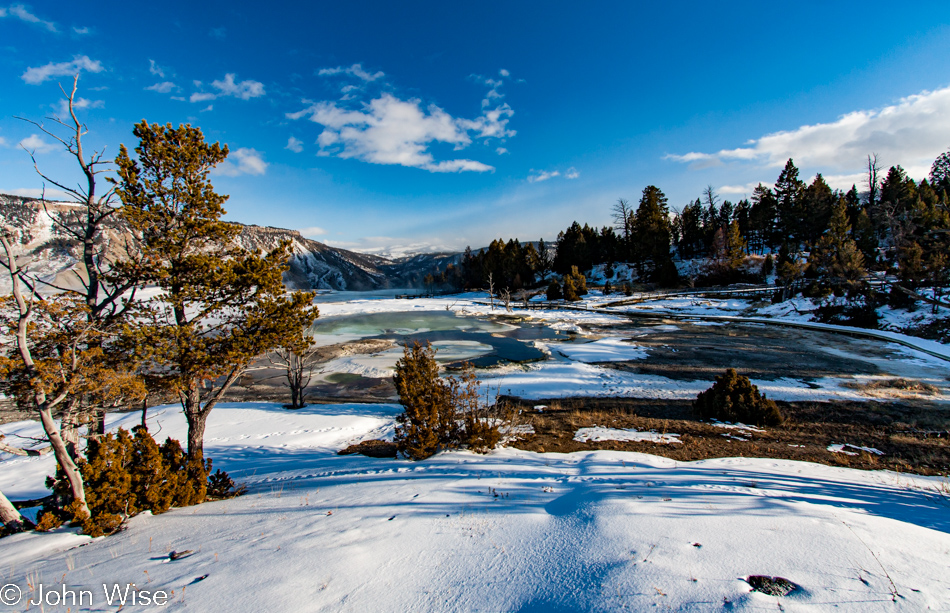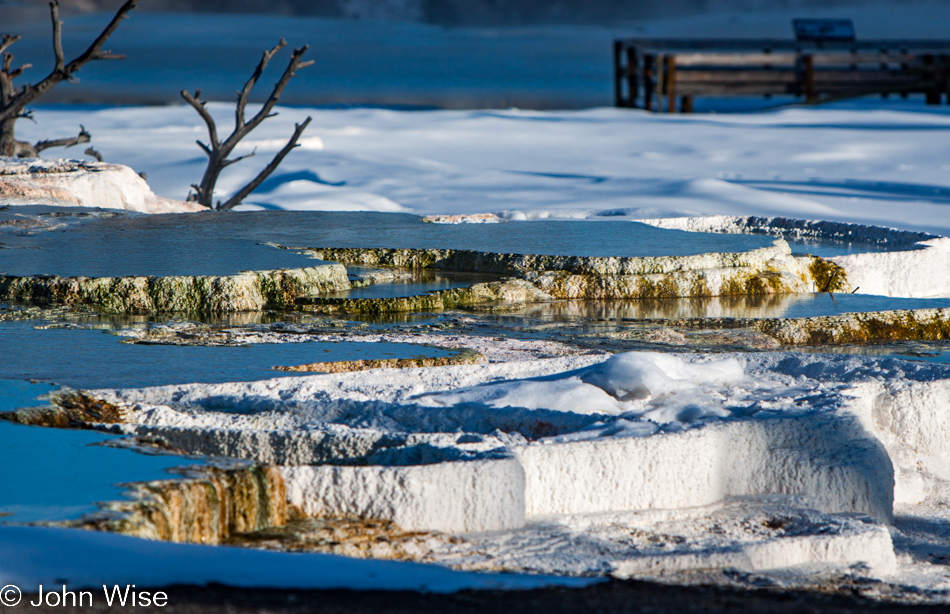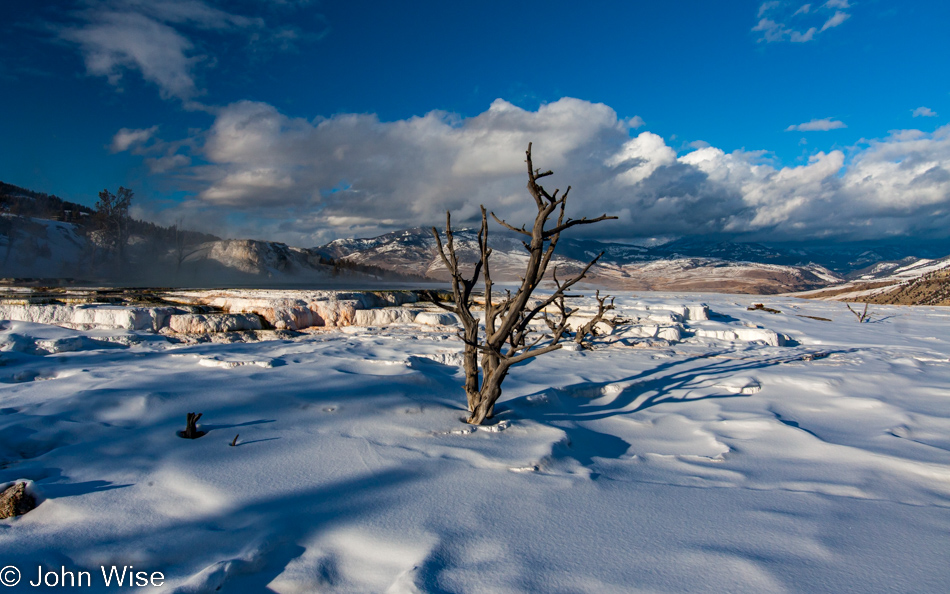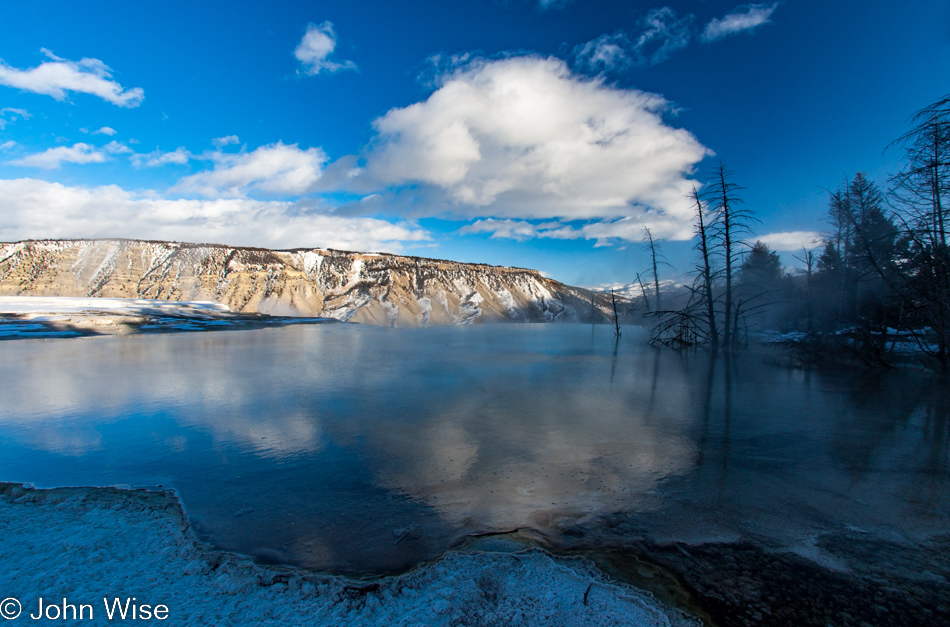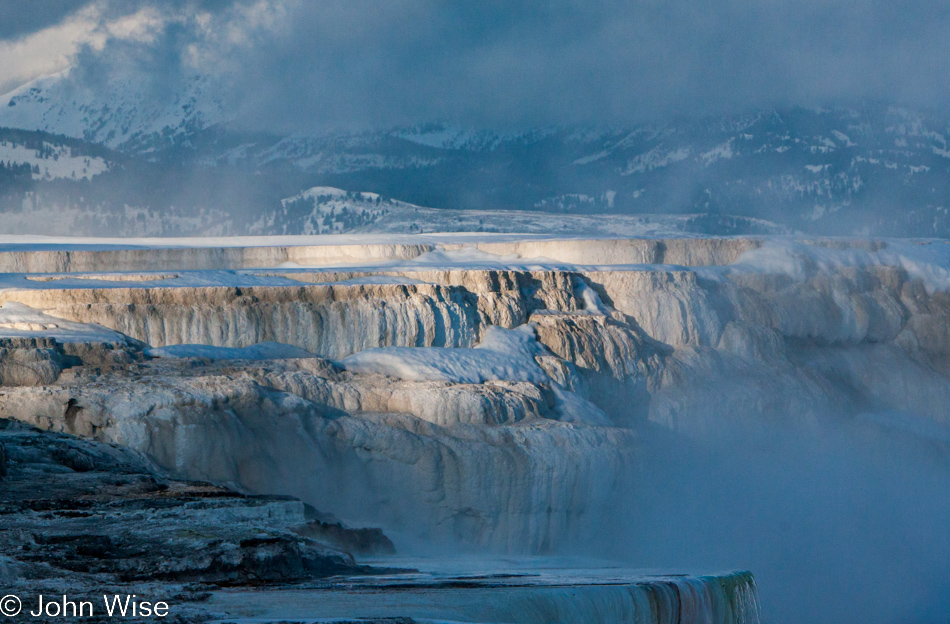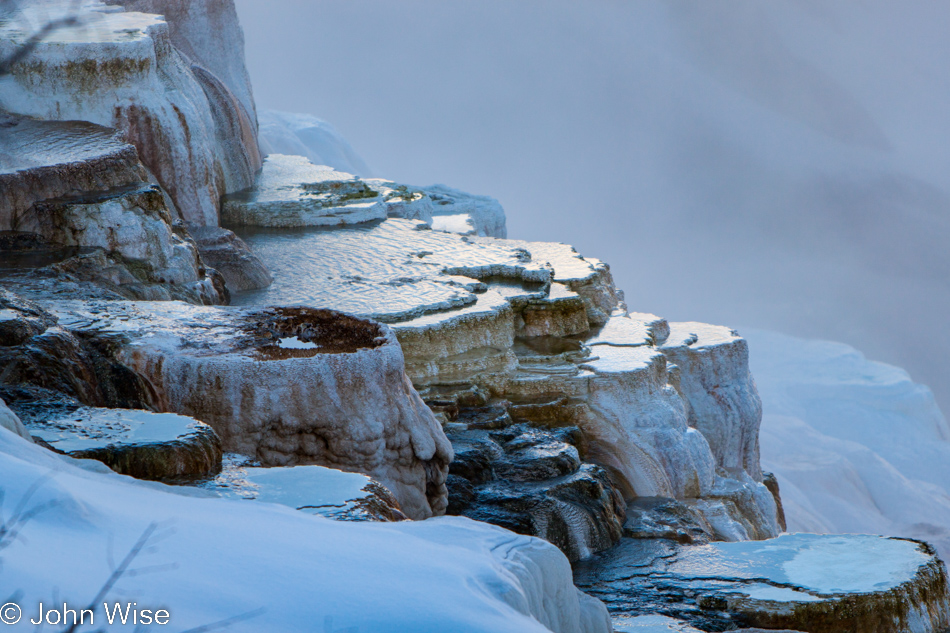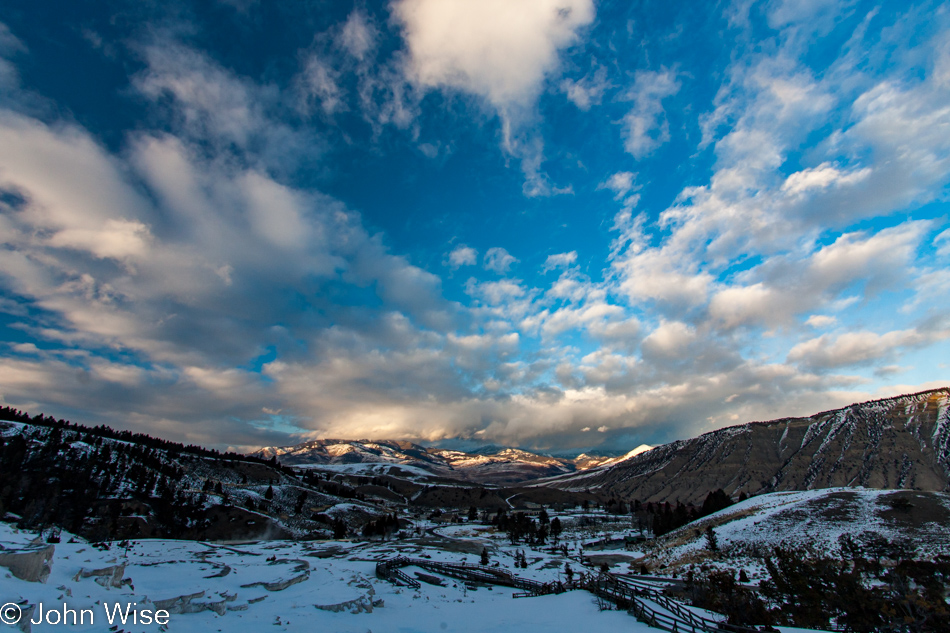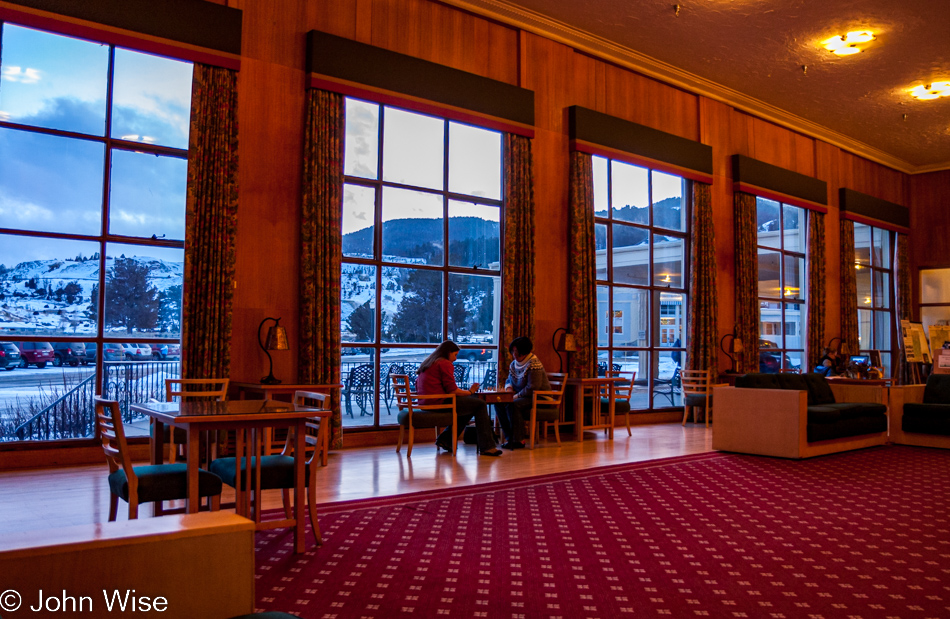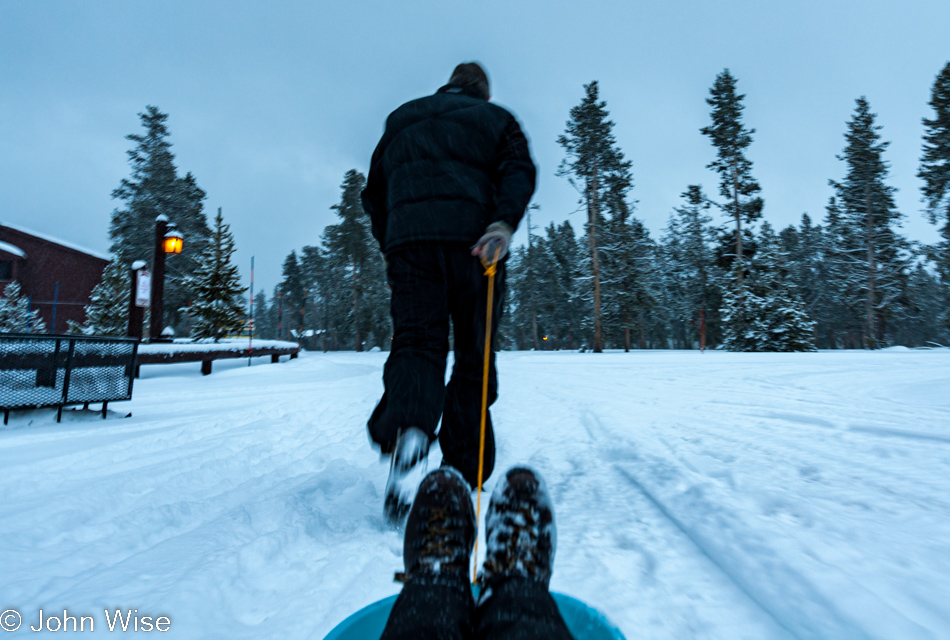
Finally, fresh snow has made an appearance. Overnight, two to three inches of the wintery cover added to the packed base which has progressively gotten crunchier since our arrival a week ago. The overall weather was not what was expected or forecast; it has been warmer and sunnier than we had imagined, and the park employees would wish for. After all, it is winter in Yellowstone, and at this time of year, everything and everyone operates on the snow, not grass and asphalt. Today is our last day in the park.
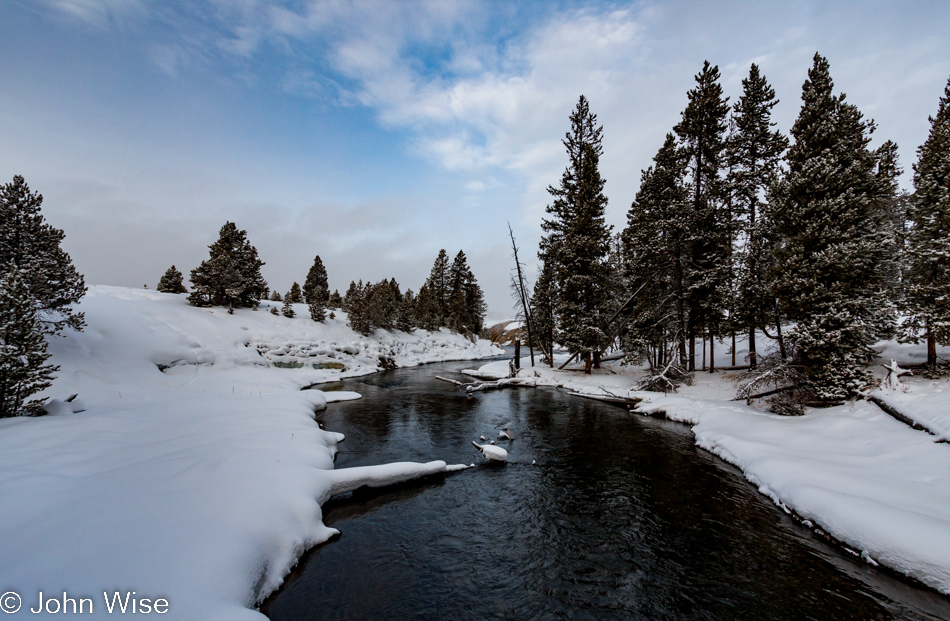
We are not in a hurry to do much of anything. With the new snow, we would have needed snowshoes to take the trail past Morning Glory Pool to Gem Pool and Pinto Spring, where last year we were amazed at bands of icy ribbons Caroline referred to as “ice bacon.” So, with Yaktrax stretched onto our boots we march out around Old Faithful to the bridge crossing the Firehole River.
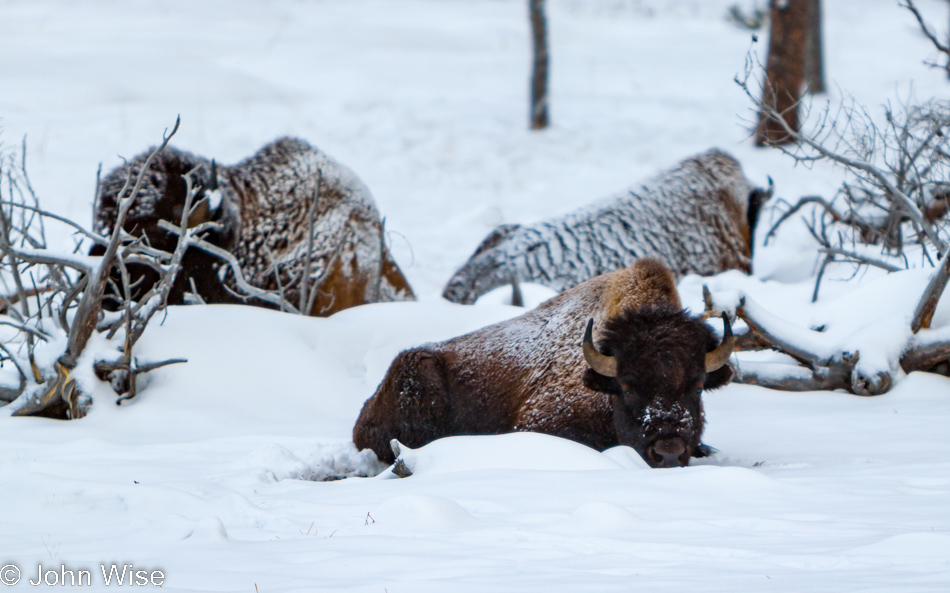
Turned out that had we been carrying the snowshoes with us, they wouldn’t have been put to much use anyway, as we got stuck behind the same herd of bison we had been watching yesterday. It was near Infant Geyser that we stopped to watch and photograph the snow-covered bison who were just beginning to move from their slumber. As they started to stir this early morning, they moved directly towards our trail and then up and over the boardwalk, stopping us in our tracks.
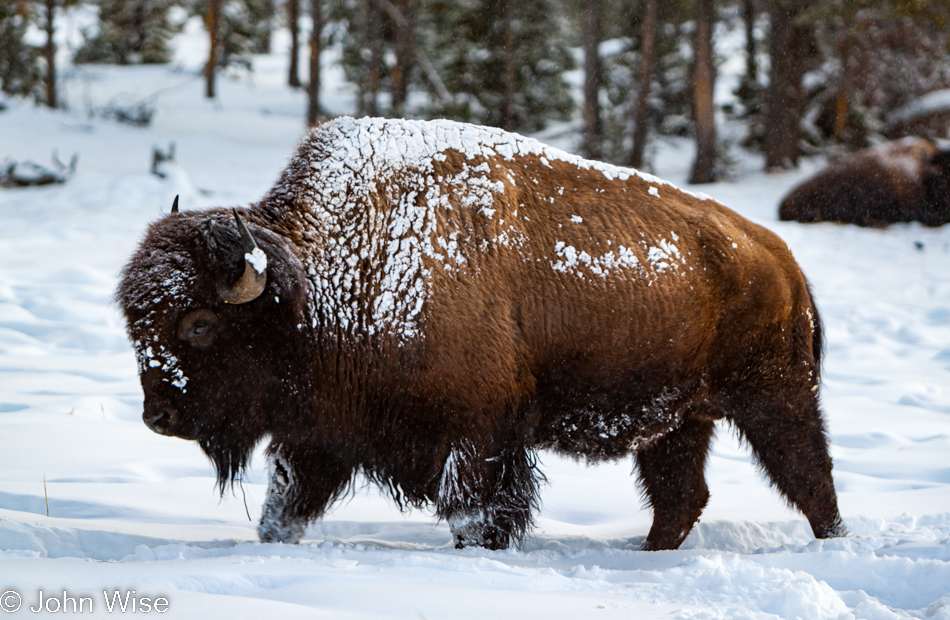
No matter, watching this small herd lazily stand up, stretch, and shake off sleep and snow while others raise their tails for a morning salute is immensely entertaining. We greatly appreciate our close encounter with these furry brown bison. As more of the herd disperses from the close-knit sleeping grounds, some are heading for the edge of the forest; others are walking over the boardwalk, and a few more pass over a hot spring, pausing to warm themselves in the steam washing over their thick coats and up large dark nostrils.
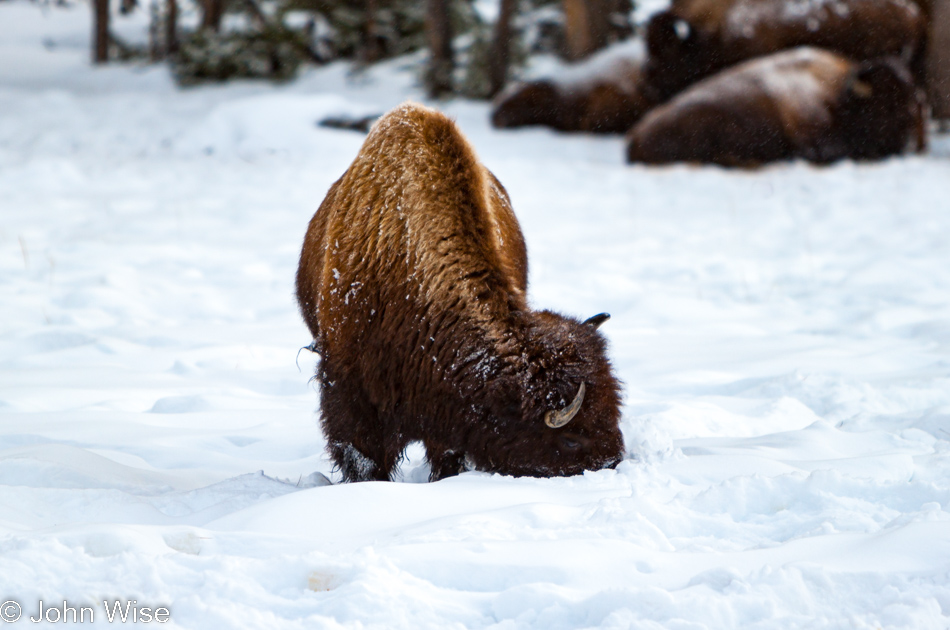
A bison walks out a few steps from the group and presses her head through the snow, swinging from side to side, making a clearing to look for still edible grass in her effort to break the fast. With snow less than a foot deep, her foraging attempt isn’t quite as impressive as the large male we had seen on the Lonestar Geyser trail last year as he stood in snow reaching up to the bottom of his chin, his head disappearing in the deep powder on his hunt for food.
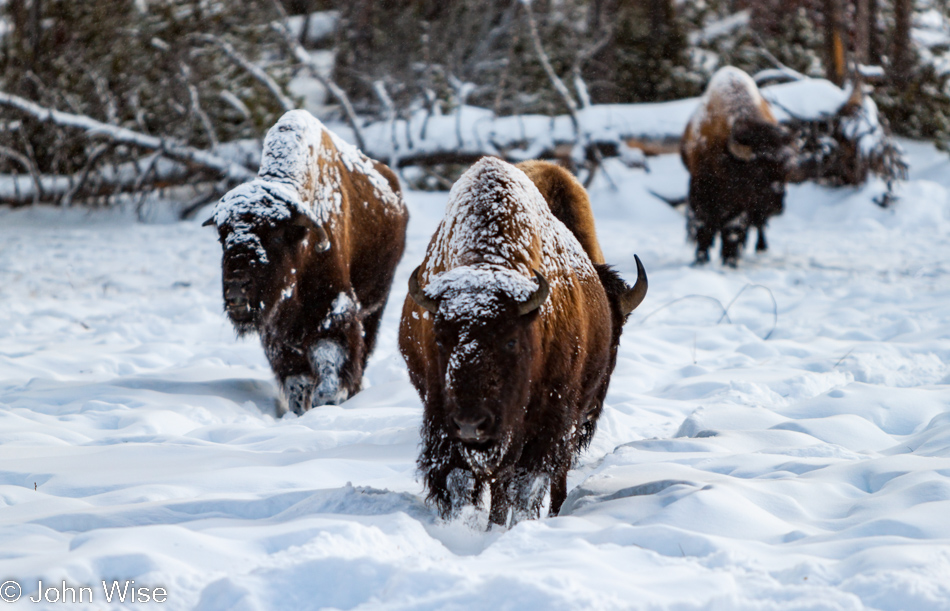
Stragglers slowly rise from their snowy beds and bear down on us as we smartly back away. This is going to take a while. A park ranger who emerged from the forest near the boardwalk warns a man on the other side of the herd that he is too close and to move away. Three or four steps were not adequate, and the ranger admonished him to move further. The wait continues.
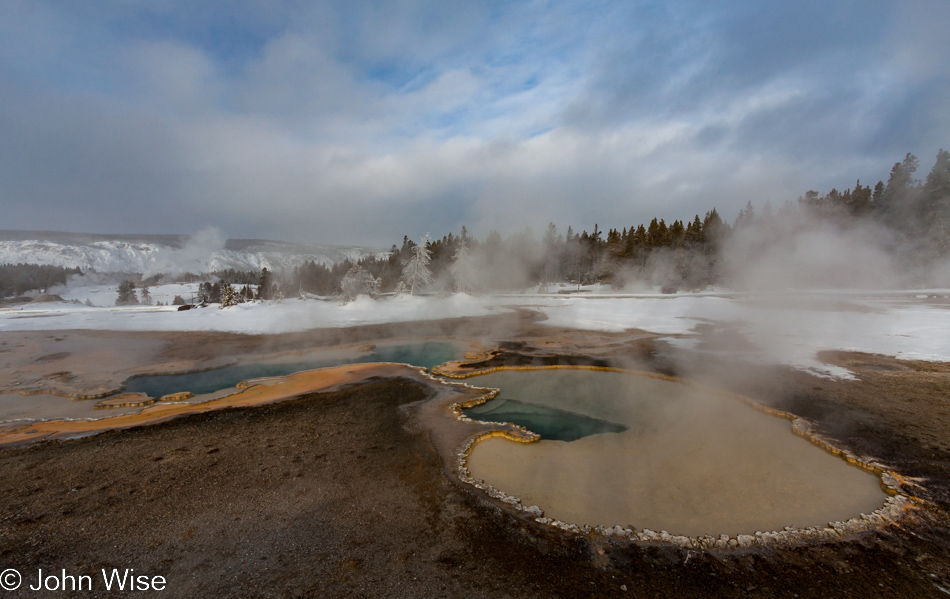
We have some hours to go before our snow coach arrives to spirit us back to Mammoth Hot Springs; turning around now would put us back at the hotel with little to do. We wait. Not that bison are not fascinating to watch, but after watching them awaken, shake, have a morning constitution, eat, meander, stand around, and indulge in a steam bath, we start to get antsy and want to walk about, too. The quiet Doublet Pool deserves to be gawked at; we oblige.
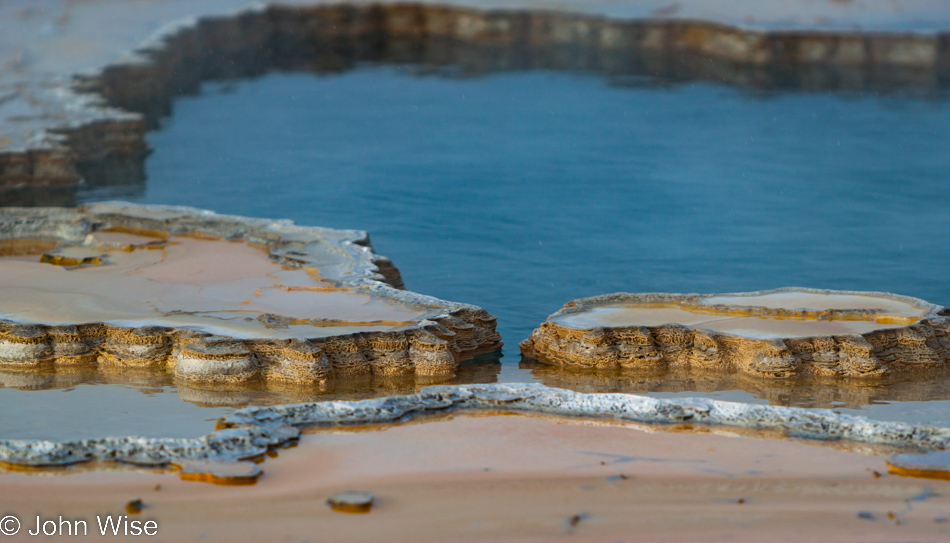
The thumping and pulsing we heard and felt yesterday are not returning to Doublet. Waiting behind the bison, we have ample opportunity to trace the outline of the pool and note the colors. Some other people joined us at the bison jam, but their patience was not nearly as strong as ours; after ten or fifteen minutes, they turned and went back. We look at bison, look at Doublet, back to bison, back to the pool, look at the steam, look at bison, and so our routine plays out. As a light snow begins to fall, the sun at the same time is off again, on again trying to peek through clouds.
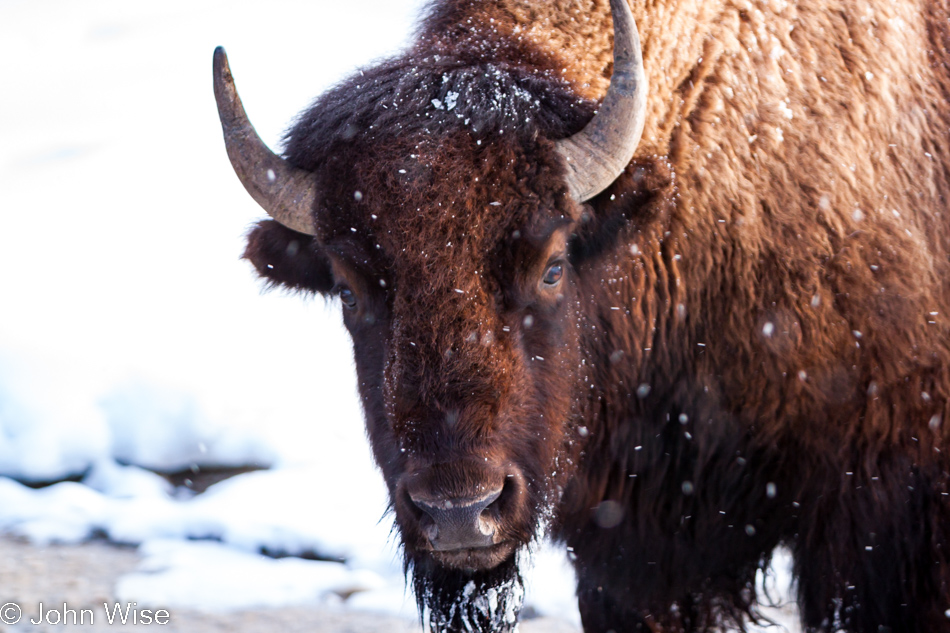
The last bison to get moving was a smaller one. Not a calf, but maybe a juvenile; then again, it may have been a smaller animal due to its serious injury. Its right front leg was broken, the hoof dangling just above the surface of land and snow below it. This tenacious bison stumbled over to join the herd, not able to put an ounce of weight on the damaged leg. She would move two or three steps, collect herself, and eke out a few more painful limping steps to move closer to the group that must be her family. Time paused while this poor creature inched along.
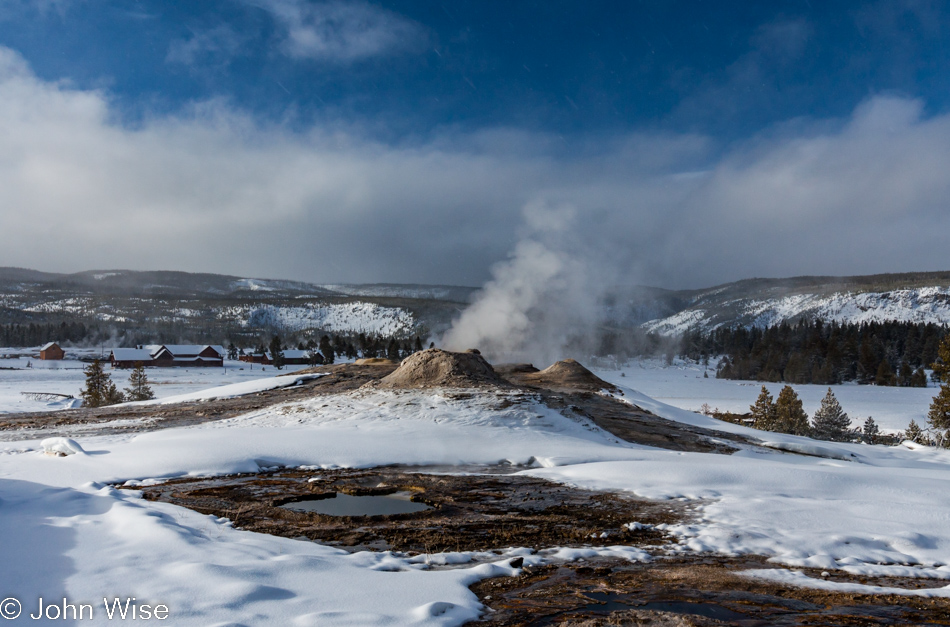
Finally, a break, and we make tracks down onto the segment of the boardwalk that enters the edge of the forest alongside the Firehole River. We didn’t get far before we were startled by a bison hidden behind a tree just feet from the trail. For the next fifteen minutes, we wait patiently, but this bison seems to have found some tasty morsels and is content to linger. We are not and begin to cut a path into the forest on the other side of the trail through knee-deep snow, over and around fallen trees. At the point we are about to cut left, the bison starts to move towards the river, letting us backtrack through our steps and continue our way north on the boardwalk.
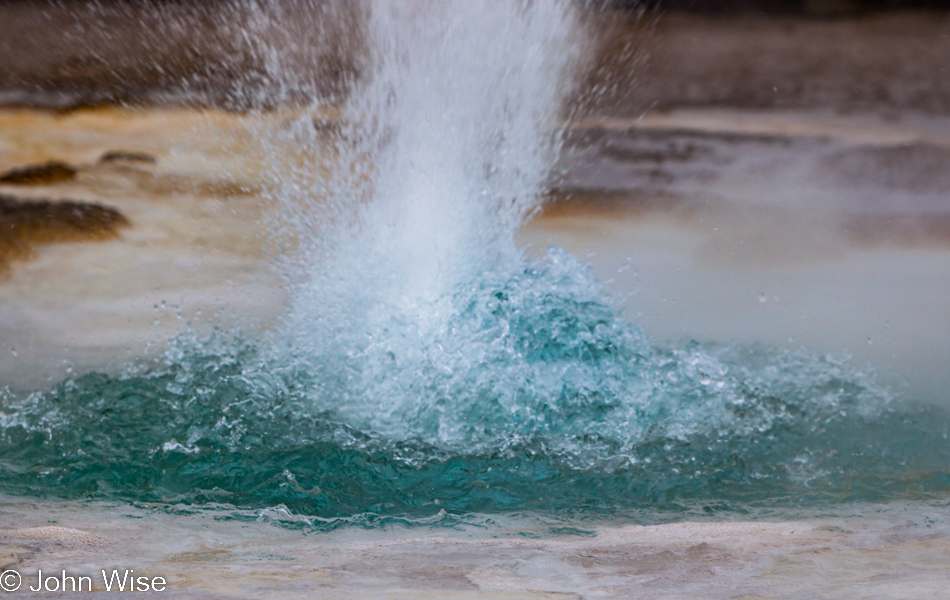
Some of the trees are frosty; some have a new coating of snow that hasn’t yet blown off. The diamond dust we saw here last year was not to be found here this time We walk on, looking at nothing in particular and everything all at the same time. Northward, we go with the umpteenth stop at Sawmill Geyser to watch it erupt. Refusing to stand here an hour snapping another thousand photos, we satisfy ourselves with just a few minutes of ogling.
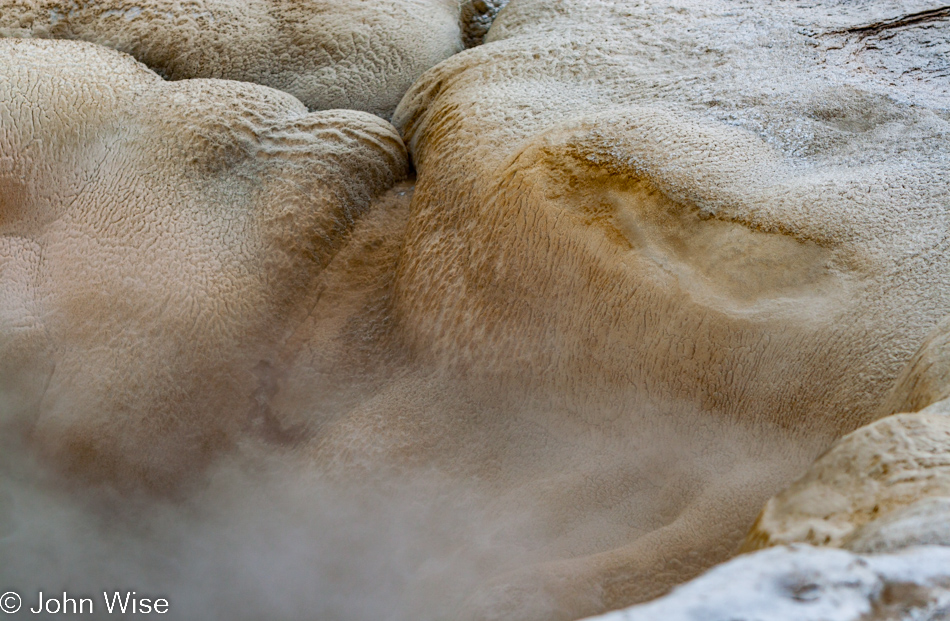
Spasmodic is quiet again today. That does not imply anything less than amazing, though. The ever-changing dynamic landscape of evolving art is like a constant transitioning painting being created for the observer instant by instant, with flairs of water and steam rippling forward only to be drawn away, revealing the canvas, which itself is only another layer upon a deeper canvas. The entire panorama is alive, contorted, and brilliant under a radiant sun, mysterious and elusive under a gray sky. Superficially, I may have understood the idea that Yellowstone will never appear the same between two visits, but it wasn’t until this visit that I truly began to appreciate how to discern that these differences can be observed from day to day, hour to hour, even minute to minute. How long does it take for us to see that Old Faithful is more than a geyser of water shooting into the sky on a somewhat predictable schedule? How long does it take a man or woman to see more than the pool of water or the color of a rock? Why are we so easily overwhelmed by the new and so slow to find reflection and appreciate unknown qualities that may lie just before us?
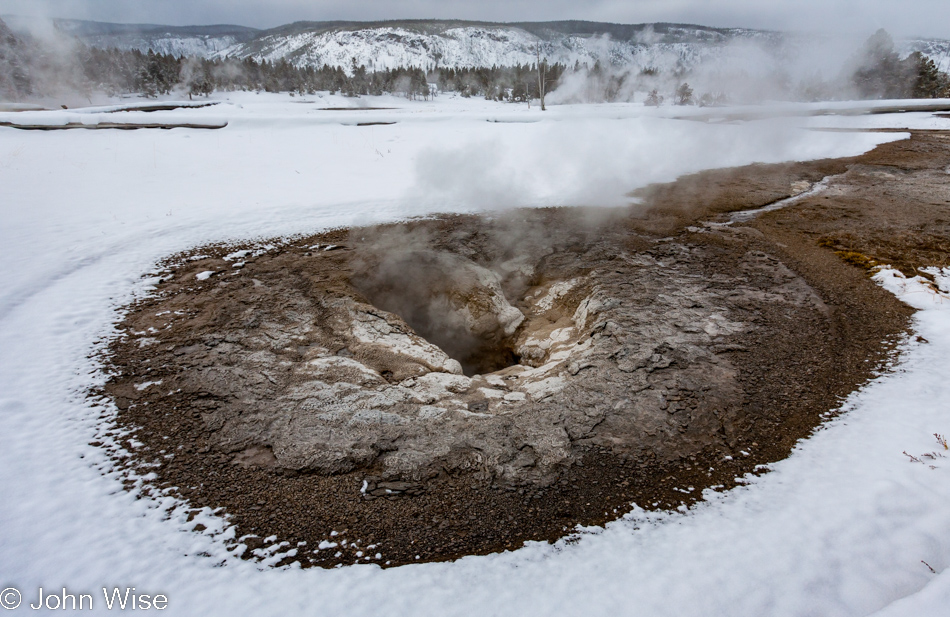
Here is the empty Oval Spring with light puffs of steam rising from below. Would you stop to have a closer inspection? While erupting hissing thermal features surround you, does a gray, brown, and tan seemingly lifeless crater warrant your attention? What if this hole-in-the-ground was full of rapturous aqua waters frothing and gurgling with belching gasses, creating a column of water splaying the surroundings? Anyone would likely stop then, but I have to now. I want to understand how this drab vent has all the splendor to have been included in the magnificent display here in Yellowstone.
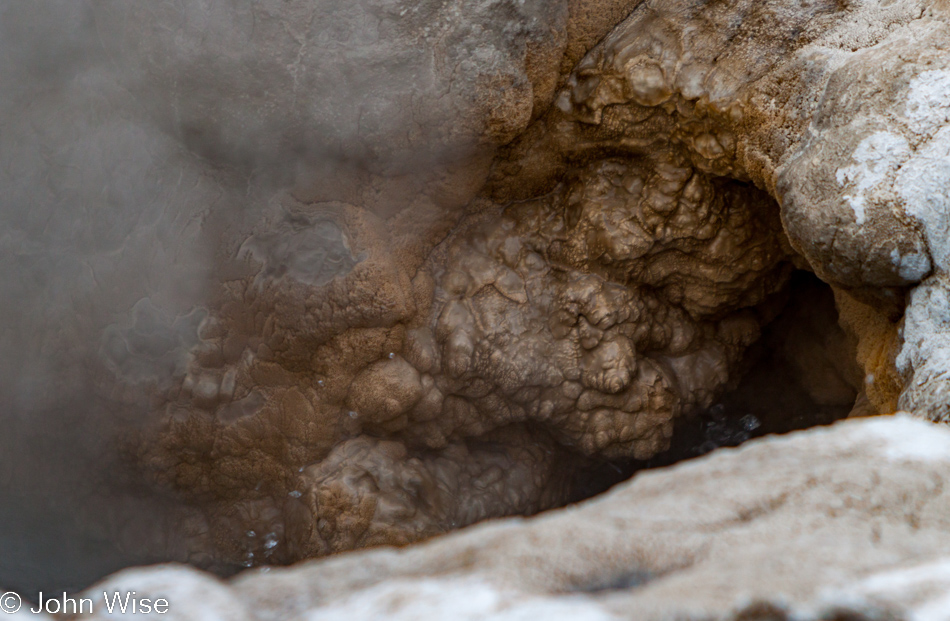
Up close, through the steam, deep in the crater, a wall of damp bulbous rock growths is glistening, moistened by the steam and the occasional spurting water. Looking at the details of this spring, my eyes start to reveal the beauty that my impatience might have ignored otherwise. From the boardwalk, we are only offered a limited vantage point from which to capture the essence of the thing we would like to experience, the compromise a necessity brought on by humankind’s desire to destroy through carelessness or the collection of a souvenir or memento to take home. And still, with the knowledge of how this can bring ruin upon the world and its beauty around us, there are those who will throw coins, sticks, or other debris into these “things” that have taken hundreds of our lifespans to create and only the flick of a wrist to stop the rest of us from enjoying.
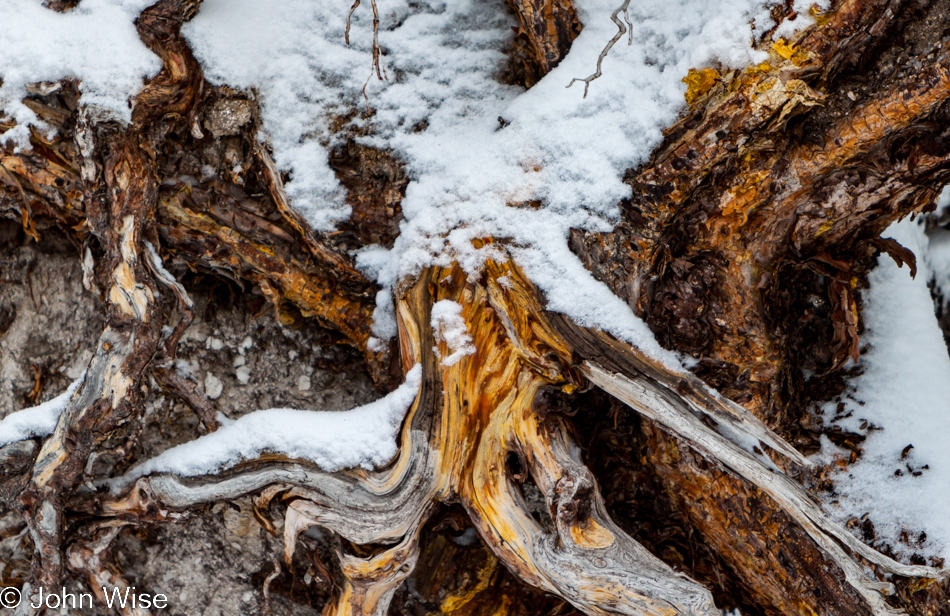
On another side of the boardwalk, a tree with snow-covered gnarled bare roots plays second fiddle to the surrounding beauty. The patterns on display in nature’s museum shame the greatest of man’s museums, and yet only a fraction of the number of visitors will ever visit a national park in comparison to how many people will pay a visit to a climate-controlled building featuring the works of man and woman. Eight and a half million people will pass the Mona Lisa this year; I may be the only soul to recognize this root and find the art inherent in what Mother Nature has created for our delight.
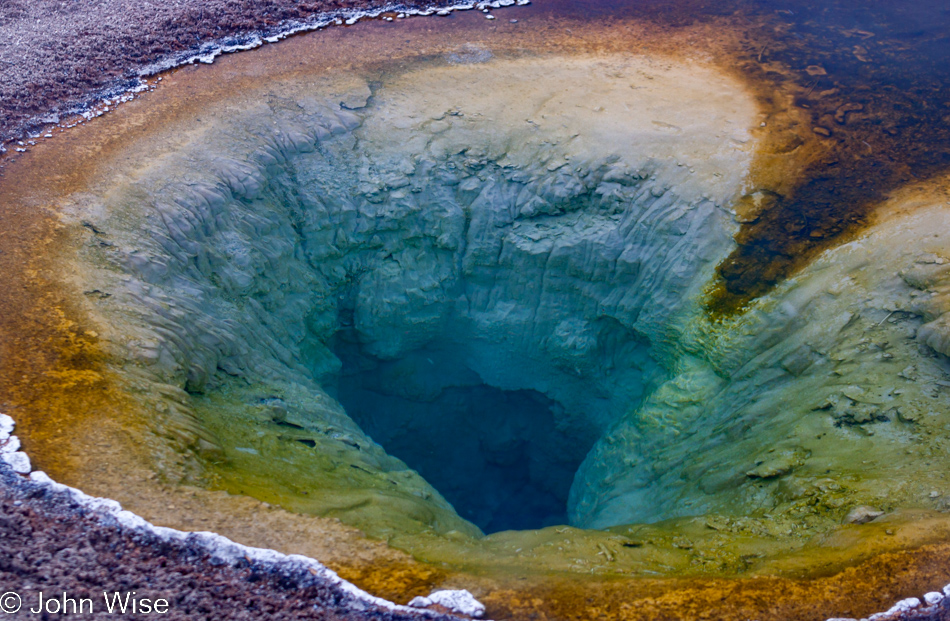
Yesterday, the colors of the Belgian Pool were vibrant; today, they are muted under a gray sky. Without the sun to dance across its surface and illuminate the steam, stillness prevails, letting me see more. Sure, the colors of the pool in the sun are a spectacle we all desire to have captured in our photographs of this terrific place, but it is alone in this quiet, under a calm, overcast sky that contemplation and attention to detail are allowed to mount. From the angle I stood yesterday, the pool didn’t seem that deep; today, I find intrigue, not knowing to what depths this darkening blue center might descend.
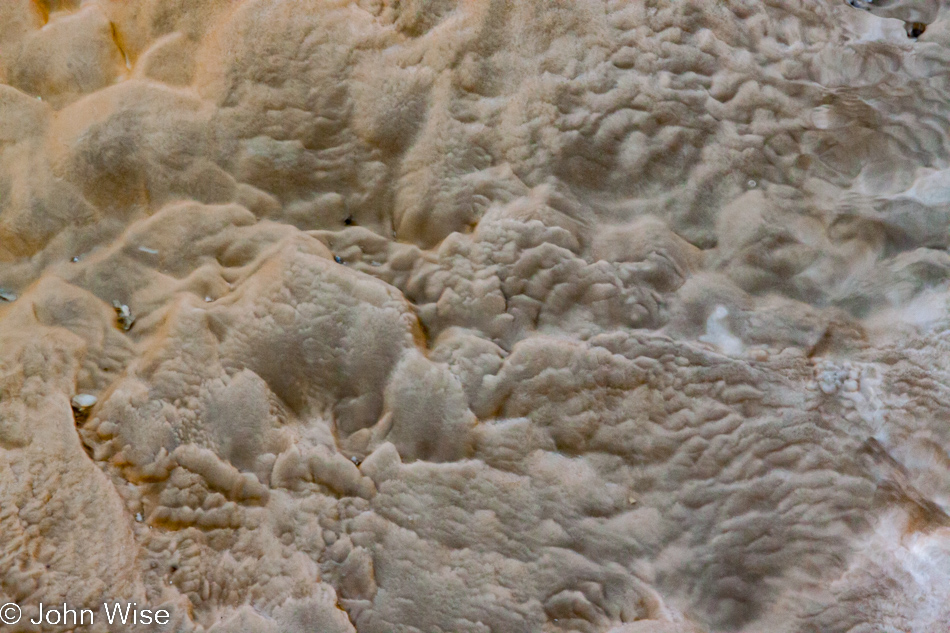
What is this? One thing is certain: we are looking at the surface below the water of either a geyser, a bacteria mat, or the edge of a hot spring. My memory fails me as to where precisely I was standing and what in particular I was looking at. Entranced, maybe I must have found this small detail just off the boardwalk, and while down on hands and knees, I became acquainted with this landscape of jutting mountains, deep crevasses, and precipitous cliffs.
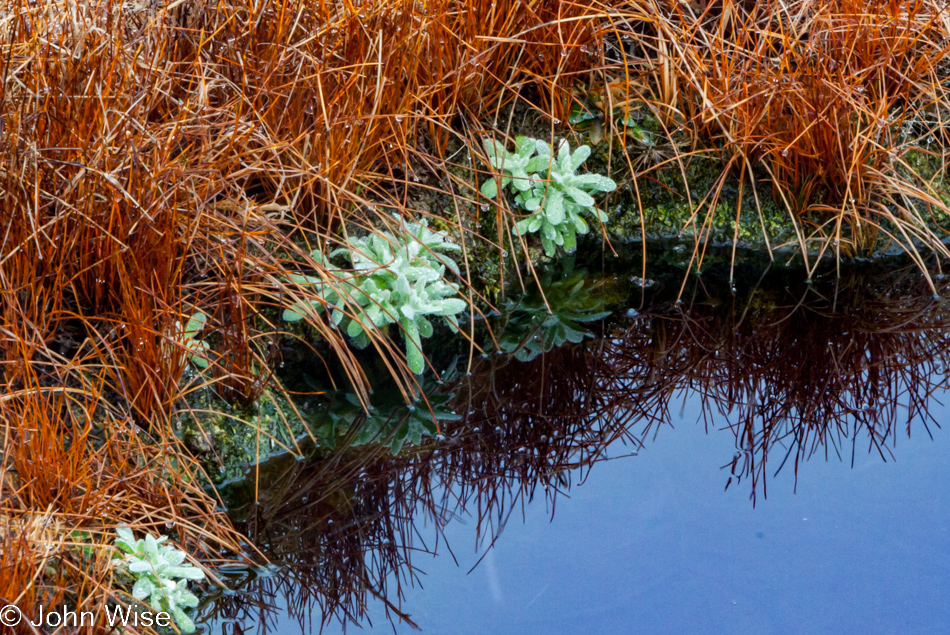
Winter, even amongst the freezing air and snow-covered earth, can be an illusion. Here, next to the seasonally dormant grasses, fresh green life clings to the edge of warmth and light in a bid to deny winter its grip on the environment. These contrasts in survival must be a part of that wonderment that propelled those early visitors from the Eastern United States to recognize the importance of such a place and then toil in their efforts to help create the world’s first National Park.
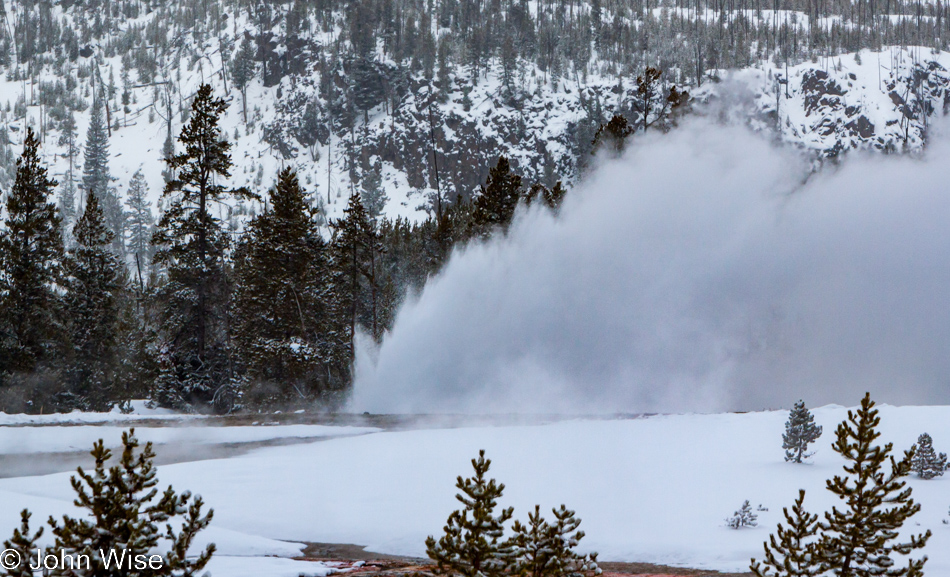
Thar she blows! Daisy is a spoutin’, gone and blown her top. Two days ago, we waited patiently, if waiting fifteen minutes could be considered patient, for Daisy to erupt – we moved on. From afar today, we look west to see the geyser going full steam ahead. Even if we were to put our butts into run-for-it mode right now, we would not arrive geyser side for an up-close view of Daisy’s majesty, and so we pause to enjoy it from where we stand.
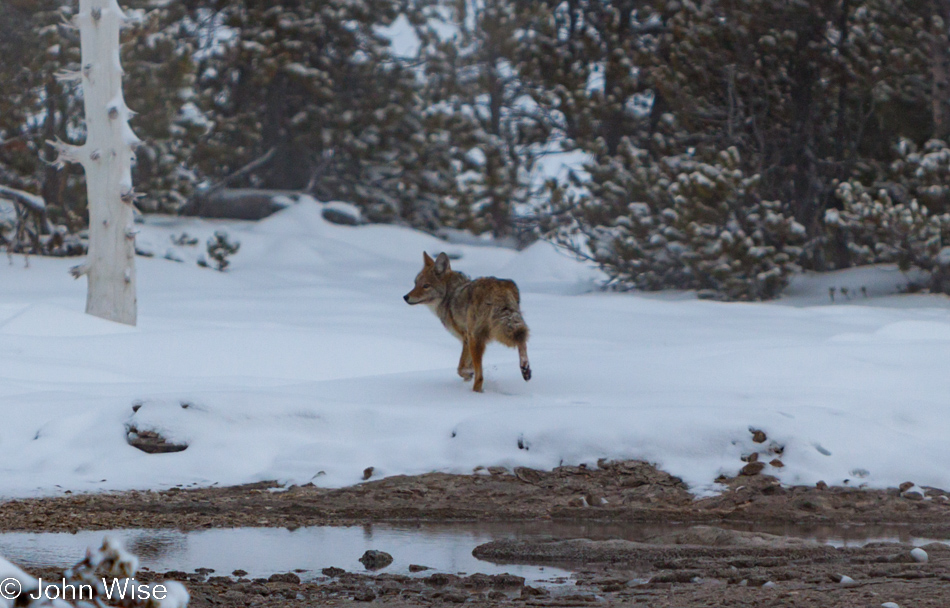
We race by Grotto; nature is summoning Caroline to take care of business. Also racing by is a coyote. The lucky coyote only needs to raise a leg or squat with nary a care as to who might be witnessing this necessity; then again, the lucky coyote doesn’t require the doffing of four layers of protective clothing to expose the essentials required for finding relief. In an instant, the coyote was out of view, going in the same direction we were traveling; maybe our paths would cross again.
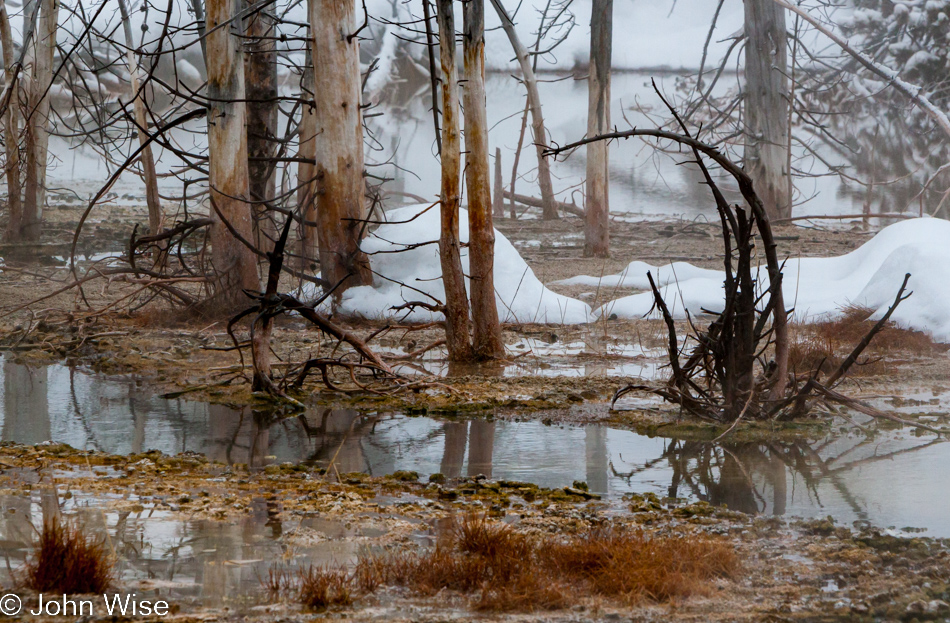
Steam and grass, water and snow, ice and mud, hoof prints and bird calls, all of this in one place. I want to return in spring, in summer, in fall; I want to be here every day to see how it all changes. I need to capture the rising and descending water, the turning of plants from brown to green, the migration of birds, the explosion of colors, and their subsequent fading to prove to everyone that the earth is indeed alive and is a master of creation, architecture, and building greater than the all of the combined efforts of us puny little people. Where has our sense of awe gone that our daily actions don’t reflect our compassion for preserving a planet that gives us all that we so irresponsibly take from it without offering every concession possible to allow it to remain healthy and intact?
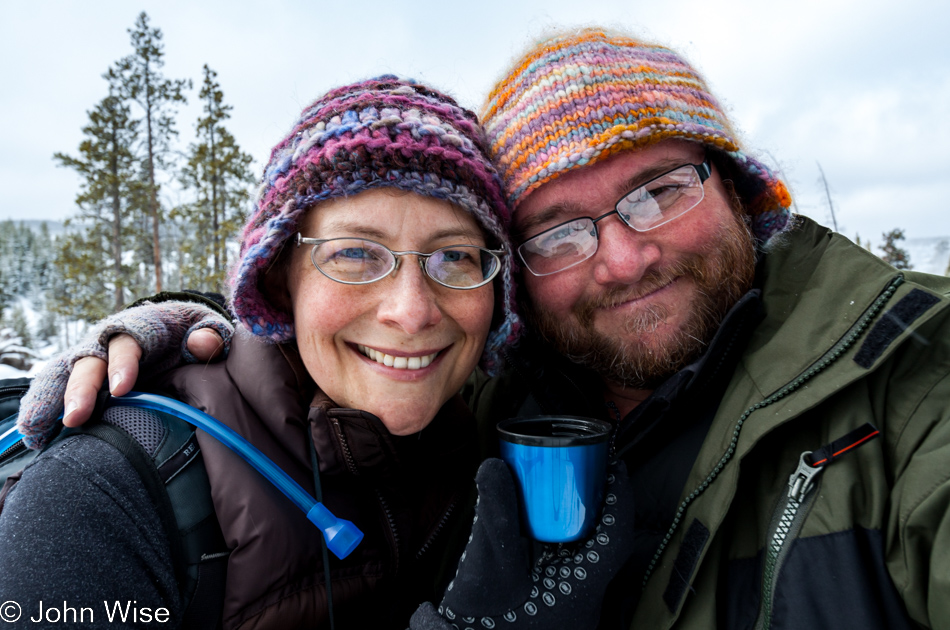
It’s 11:47, tea time. Once again, we are at Morning Glory, and as it has been on other visits, this is the turnaround point and, in effect, the end of our visit to Yellowstone. From here, we begin our goodbyes. We are no longer traveling into but away from. We raise our cup of hot tea and toast Yellowstone. A little bit of sun pokes through as the wind whips snow from the trees. Words fail to describe the immensity and totality of the experience once one has been immersed in Yellowstone for a goodly period of time. The landscape and its components become a singular whole, with each individual element being an obvious part of a larger body. Only because we are so tiny ourselves are we able to witness the finery and details we look at and pretend to understand. Each part is like a cell that, when grouped together, forms an organ, but looking from afar at the individual element, can we understand its role? The organ that is Yellowstone is too complex, too large to come to an appreciable understanding of just what it is and how its myriad pieces fit together in a week, a month, or a year. That this park delivers such extraordinary experiences is part of the draw that brings those of us back who have been here before. We become two more pieces of the puzzle, with a sense that our small part must be filled, and for a short time, we, too, can and must be a part of Yellowstone.
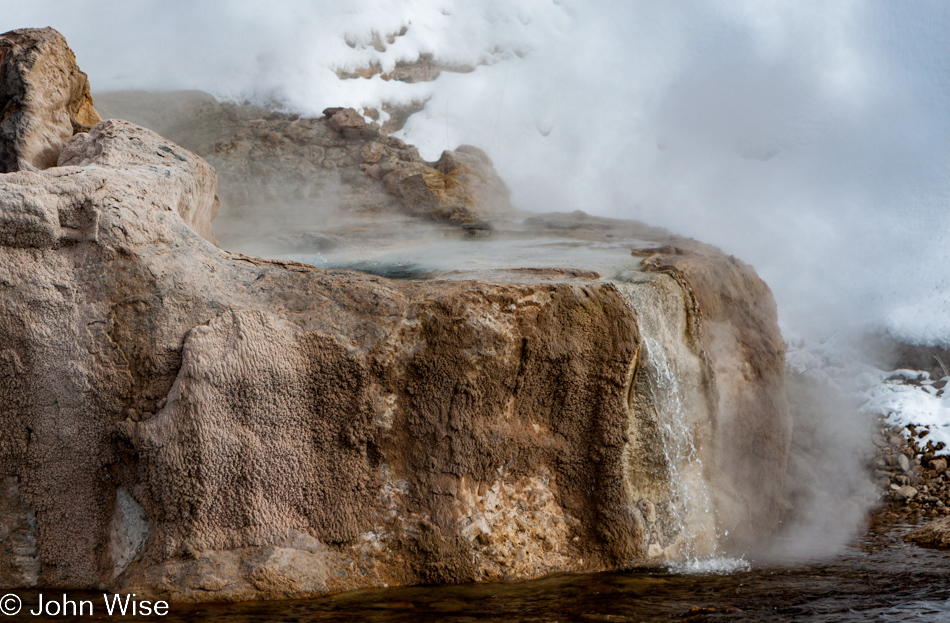
We deviate from the trail returning us to the Snow Lodge, veering onto Riverside Drive. A pool is overflowing, spilling into the Firehole River. This pool is bubbling with a few small eruptions, only reaching heights of six or seven inches, but these are signs that Riverside Geyser is likely to erupt within the next 90 minutes. Yet nearly a half hour passes and the activity, while not constant, remains as it was, never becoming a full eruption. With less than an hour before check-in for our snow coach, it is now time to beat feet.
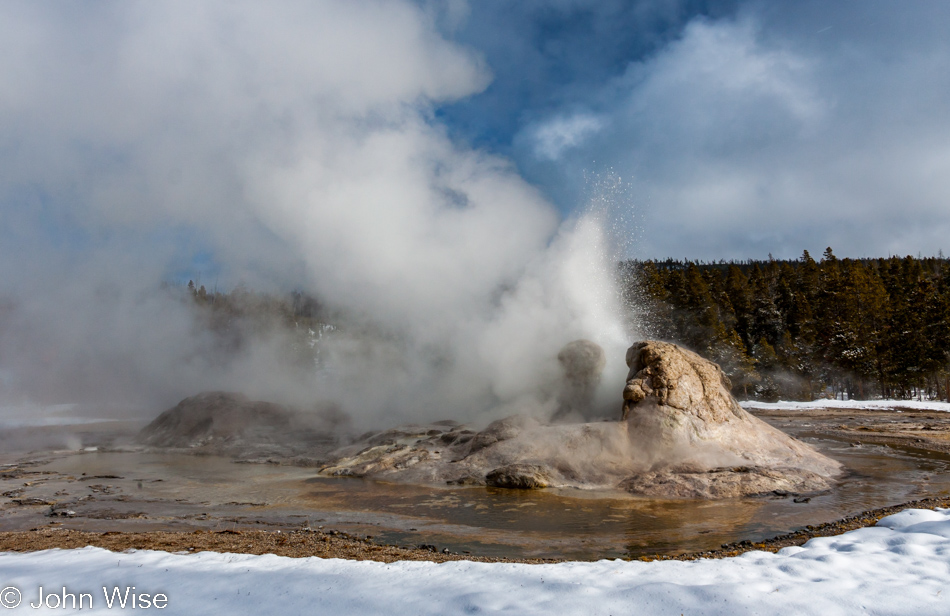
Just because we are leaving doesn’t mean we don’t have time to enjoy a sight or two. Earlier, we had skipped by Grotto; now, as we were walking by some sun and blue sky bringing cheer to these moments, we attempted to draw out of the sadness of the end of an incredible trip. Someone might ask, why don’t you make an effort to spend more time here, to work here, to live within the borders of Yellowstone? Is there a job title describing one who sits and stares at nature for months and years on end and who is not an accomplished author or photographer? Is it even possible to write tomes on a mind-ascending beauty with no regard for a thread of story besides the journey of recognition of the aesthetics of the natural world?
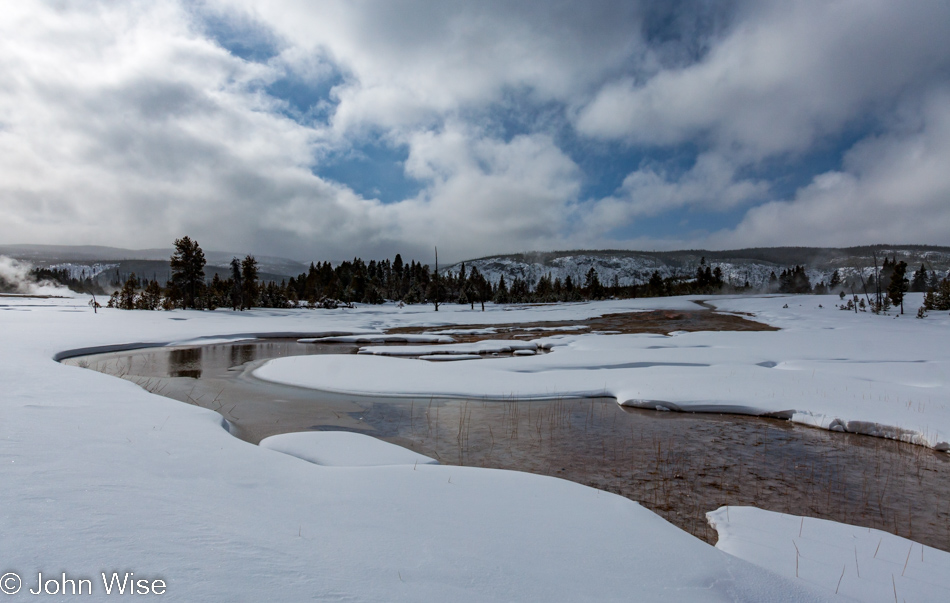
Wouldn’t you know it – another bison jam? Our herd from up the hill moved its way west and is presently crossing the bicycle path, our only short distance and expedient path to the Snow Lodge. Backtracking to cut a return passing Beehive Geyser might make us late. We need a lifesaver. And it is delivered by a Matt-Track vehicle whose approach scurries the bison forward while part of the herd is yet to jump over the stream to cross the bicycle path – we break for it, oh no, so is a bison, we run, it lumbers, but it’s big and heavy so we allow fear to propel us out of its way. Out of the wind and out of harm’s way, we are soon in front of the shuttered Old Faithful Inn, its big red door closed for the season. Its presence is ghostly with the echoes of summer and the shadow of crowds in the foyer spilling out of the sealed namesake of the geyser it was built next to. Walking by I can’t help but see Jack Nicholson opening the doors and inviting us in for a private winter tour.
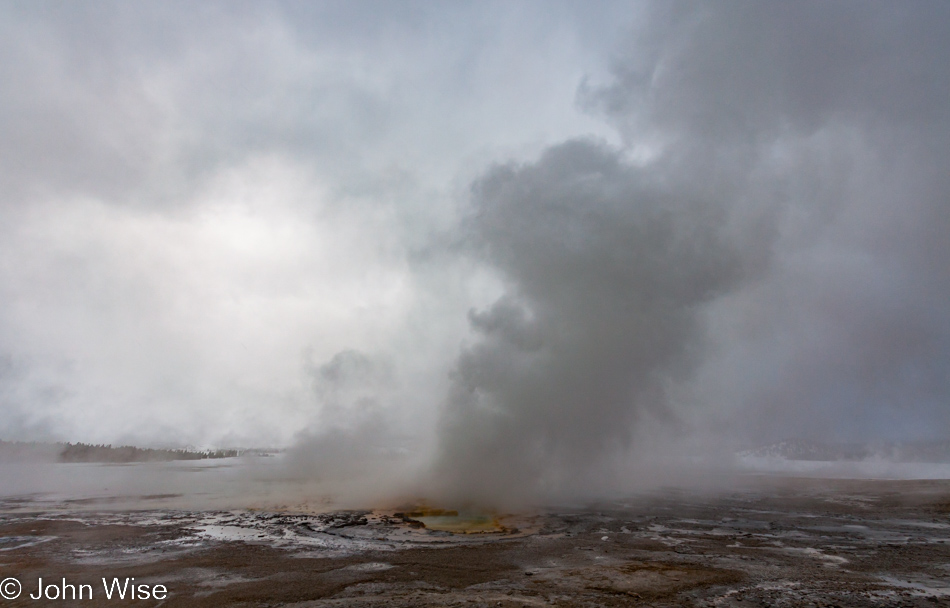
And it’s done. Our bags are about to be loaded on the Prinoth, and us on a snow coach bound for Mammoth. Dipper Darla will be our driver and guide for the four-hour, fifty-mile ride north. Passing Black Sand Basin, Biscuit, and Midway Basin with its Grand Prismatic until we reach the Lower Geyser Basin Thermal area, the Fountain Group to be precise, also known as the Fountain Paint Pots. A thirty-minute speed tour over the boardwalk feels like a fifteen-minute blur. We barely have a minute to appreciate Clepsydra Geyser, the geyser that never stops erupting – almost never.
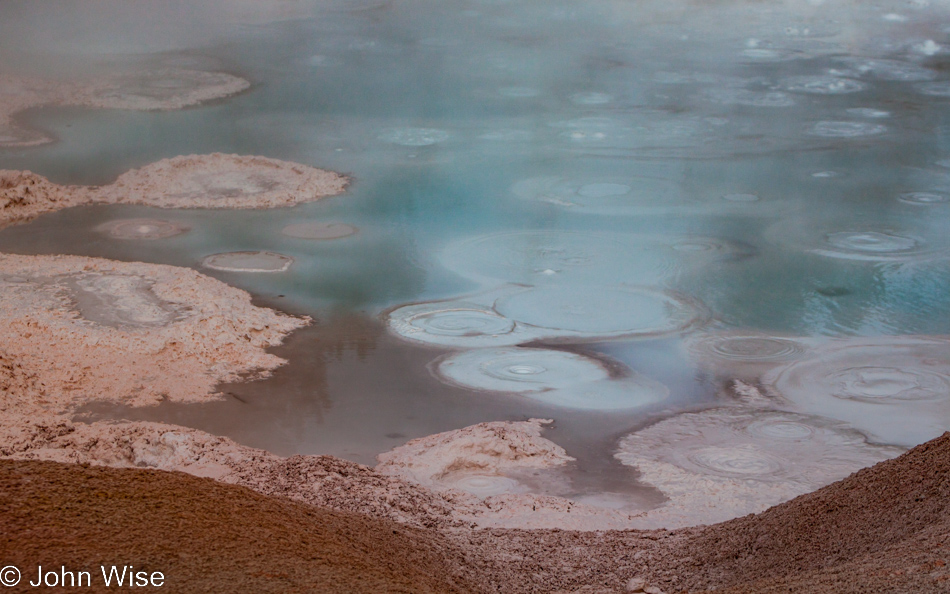
A peek into the mud pots and Silex Spring and Darla get us to pile back into the snow coach. Twenty minutes later we take a short break at Madison Junction. Unceremoniously, we dart past Norris Geyser Basin, Roaring Mountain, Obsidian Cliff, and more until we reach Swan Lake Flat in the dark. We did stop momentarily on the way for a sighting of a bald eagle. We pulled over, slowing down as we passed Gibbon Falls, but we did stop a few times to spot Dippers. The American Dipper is a small dark gray aquatic bird that survives Yellowstone’s harsh winter by diving and feeding in the rich, warm waters of the Yellowstone River system. Darla loves these birds so much she has been christened Dipper Darla.
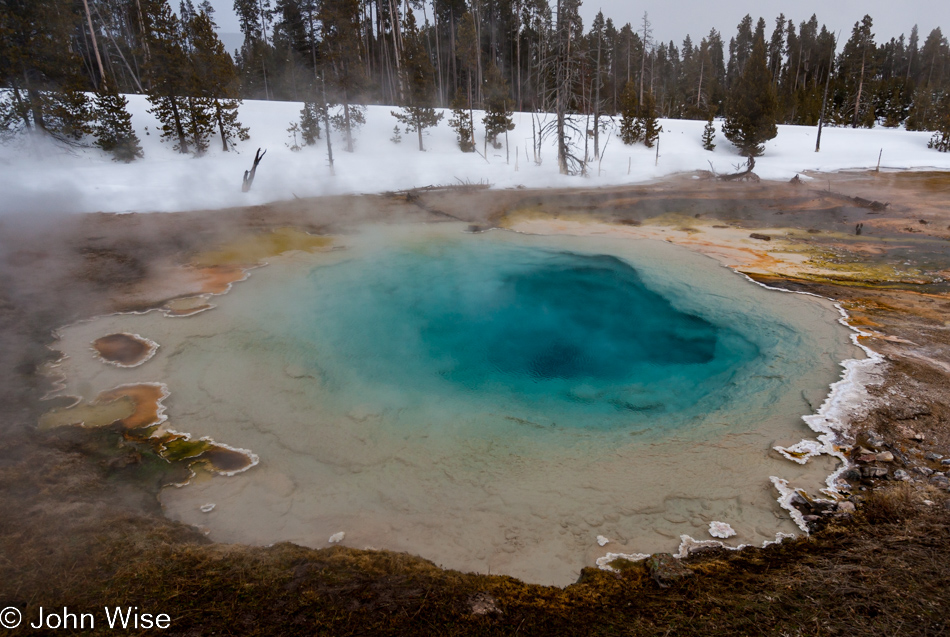
Bunsen and Electric Peaks are not to be seen in the dark. We pass the Golden Gate knowing so only because we are told. In front of the Mammoth Hotel, we stretch tired limbs and hobble to our room to deposit our bags before stuffing ourselves at the Mammoth Dining Room. What we ate wasn’t spectacular; it hardly registers, but the dessert of Apple Gallete ala Mode could be considered a primary factor in returning. For all I know, this sweet treat is a frozen toaster pasty, but after a long cold day, it does fill a certain spot. [The photo above is Silex Spring.]
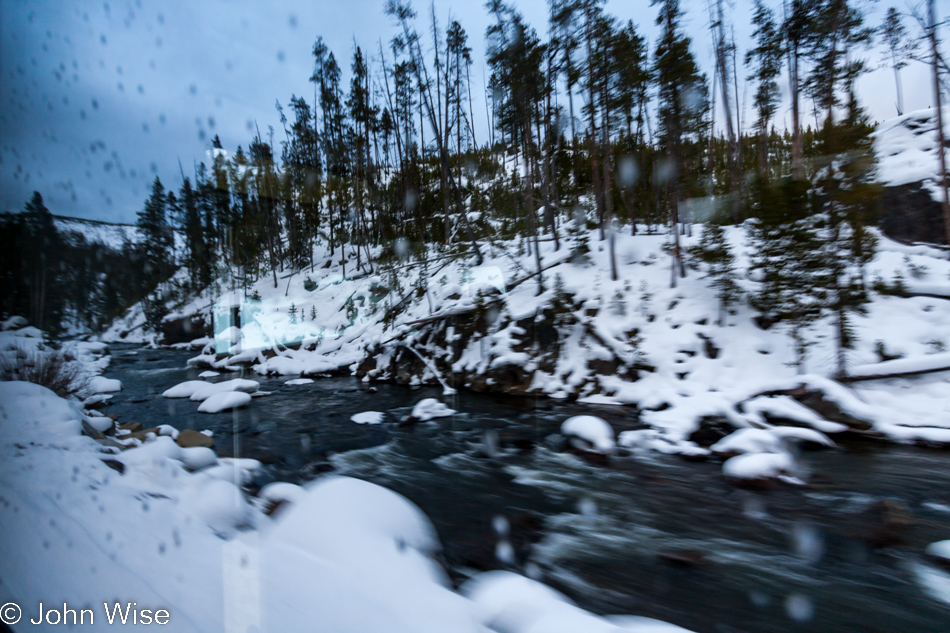
A short break before collecting the key to the hot tub for an hour-long basking in steaming waters topped with the cold night air. We look skyward at the stars while a light snow is blowing in from where we do not know. Music plays softly in the background, drifting in from the adjacent ice skating rink. The barren trees overhead and behind are illuminated by the lights of the ice rink, the hot tub light is blue, and a clock in the window of the cabin reminds us of the time. All too soon, the spa, the sight of the stars over Yellowstone, the smell of sulfur from the springs, geysers, and fumaroles, and our week-long vacation here will all come to an end for us and will probably be just getting started for someone else. We are finished packing and ready for sleep. In the morning, we will have breakfast and await H.A. Moore’s return to ferry us back to the Bozeman Airport. [The photo above is out the window of the snow coach; you see, it pays to leave your vehicle and explore this world around you.]
